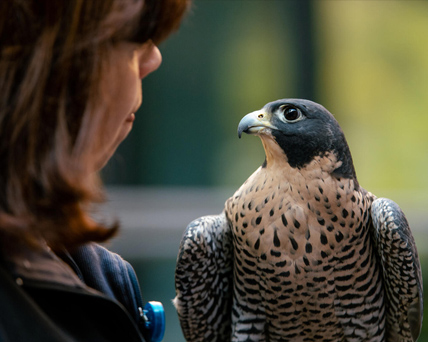From approximately mid-February to early August, this page features a 24/7 live camera with two real-time views of the nest box where the peregrine falcons live and raise their young. Please note that this is live video of wild birds in the natural process of raising their young. A Mayo Clinic biologist is monitoring this camera and will evaluate developments as they occur. We do not plan to interfere with this nest or its occupants.
Throughout the year, this page features a short video about peregrines and their activities at Mayo Clinic. Scroll down to the bottom of the page to view the video.
Questions about the program may be submitted to peregrines@mayo.edu.
Click here to watch a recording of the 2025 falcon chicks banding and naming event.
News from the Nest Box
Click on an entry below to learn more.
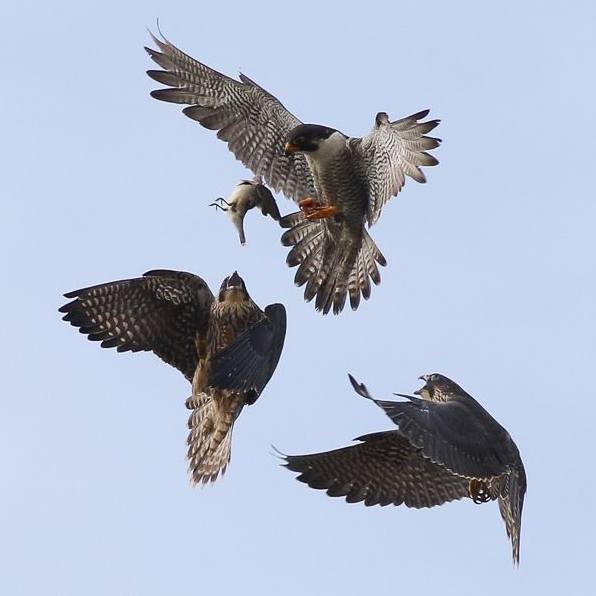

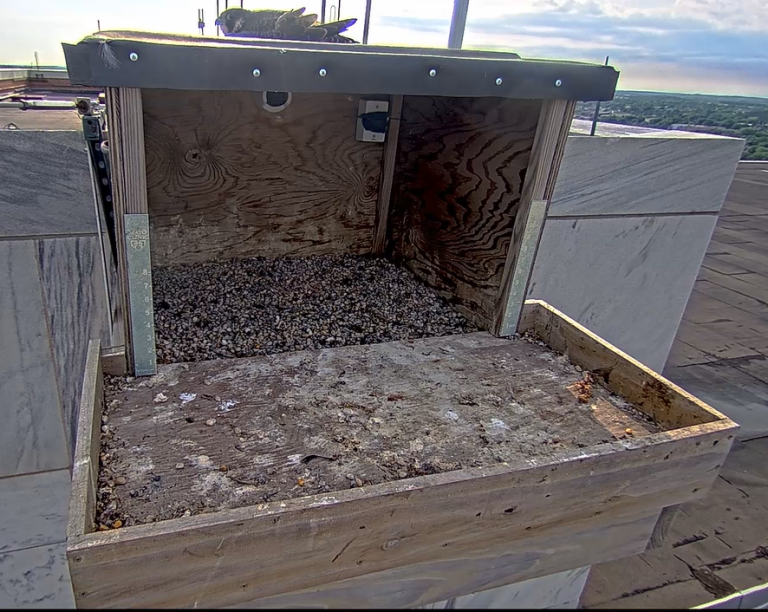
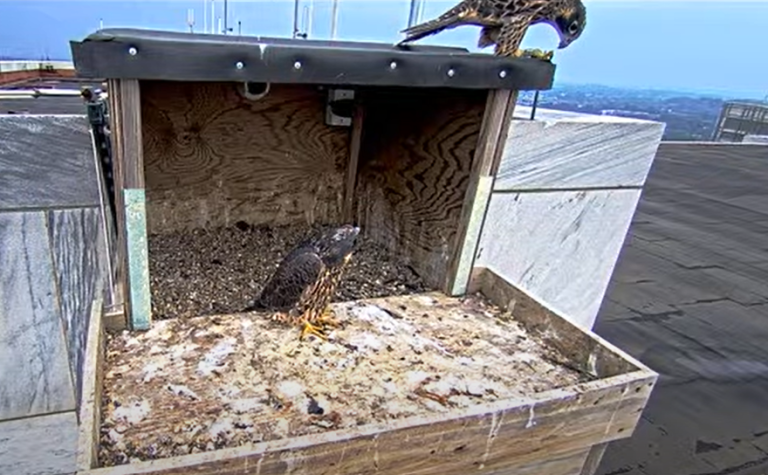
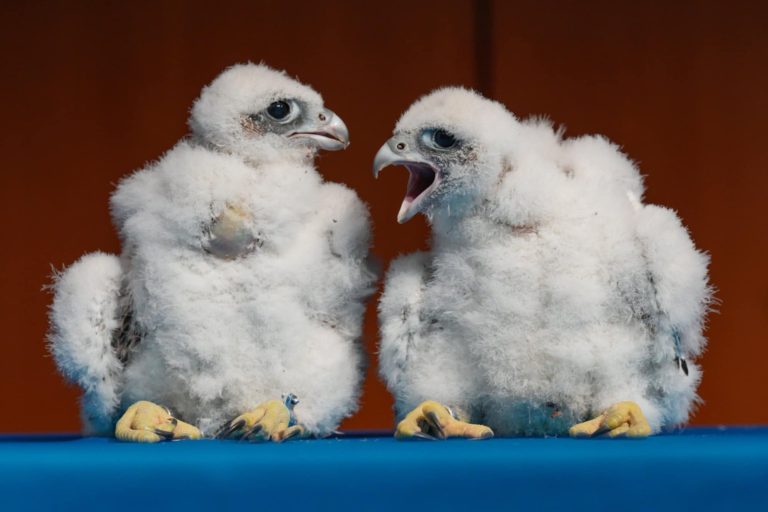
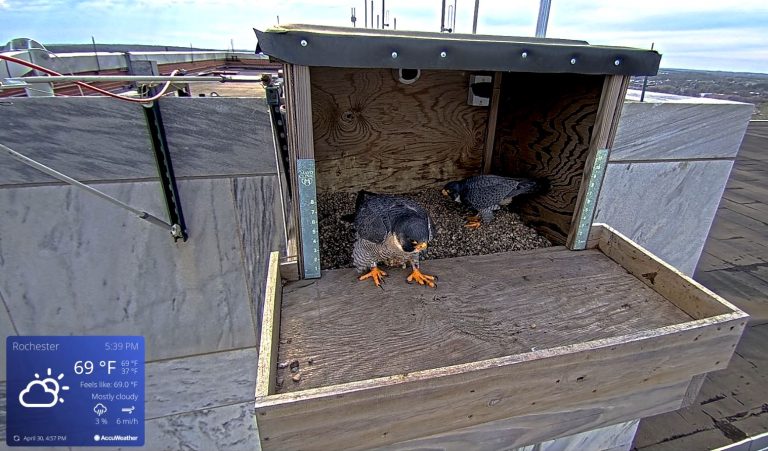
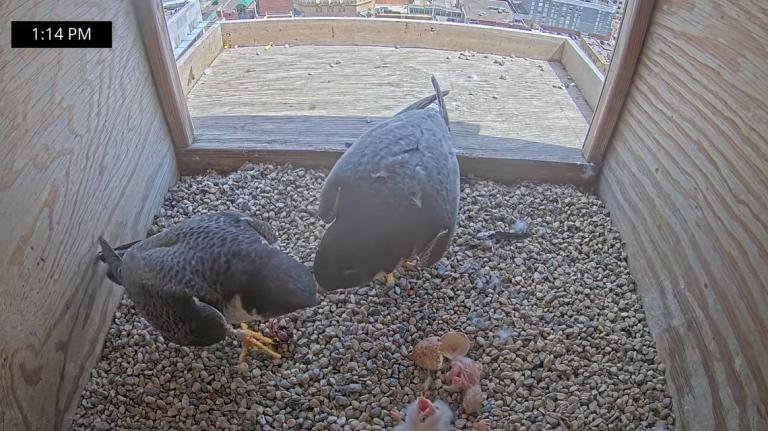
The second chick arrived this afternoon, approximately at 1 pm CST. Both chicks appear to be doing well and are being well cared for by Hattie and Orton.
We're still reviewing the camera footage and will share another update as soon as we have news about the disappearance of the third egg.. Thanks for your patience!

Yesterday at 5:23 pm CST in Rochester, Minn., Hattie and Orton welcomed their first chick of the 2025 season.
The chick made it through the night and is being tended to by Hattie. At this stage, the nestling won't eat more than a few bites, but if everything goes well, it will start eating its body weight on a daily basis until it is nearly three weeks old.
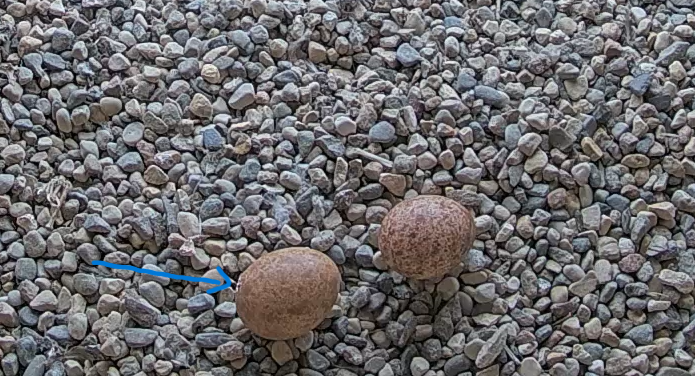

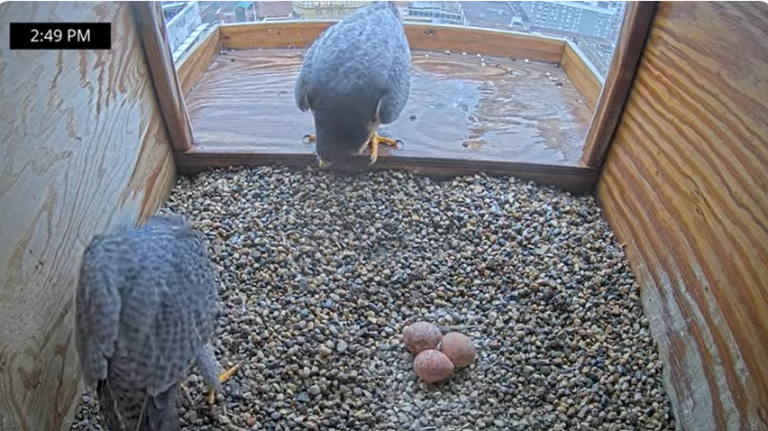
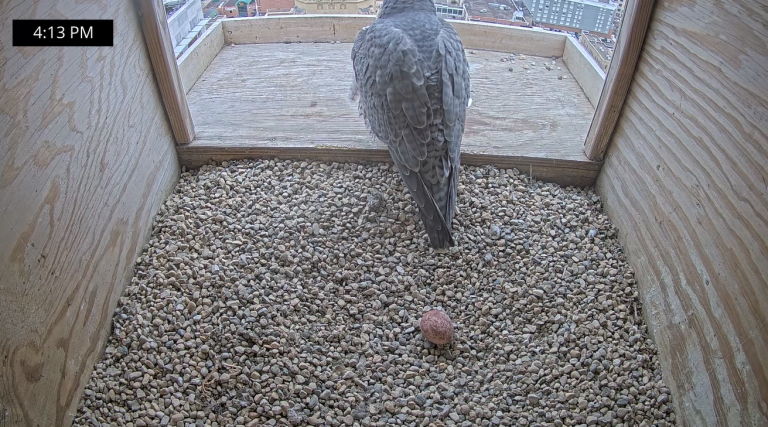
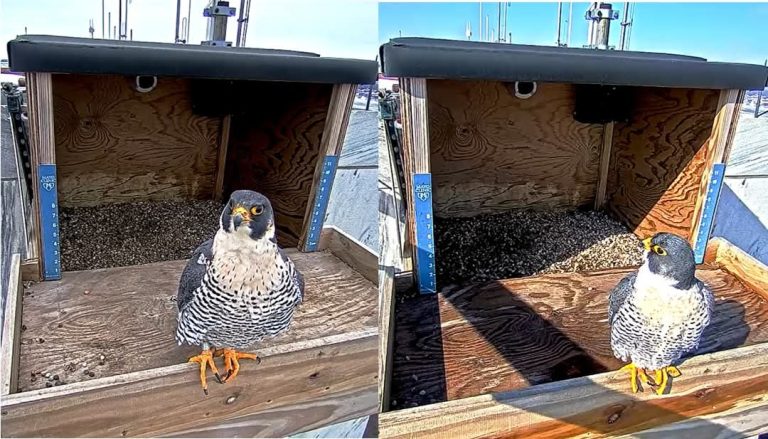
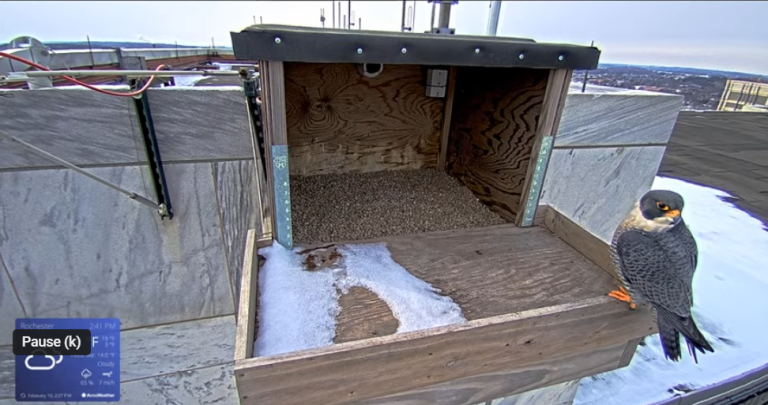
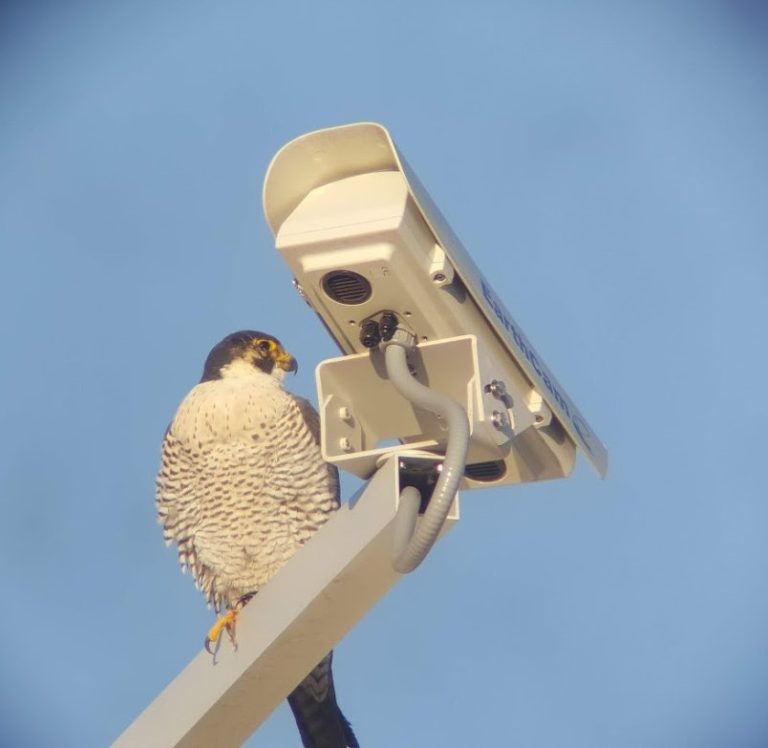
2025 Community Events
Mayo Clinic is proud to offer these educational programs which highlight our involvement with peregrine falcon recovery.
Contact peregrines@mayo.edu for more information.
July 16, 2025 – Live Peregrine Falcon Presentation, St. Charles Library, St. Charles, MN 10:30 a.m. CT – FREE
July 25, 2025 – Live Peregrine Falcon Presentation, Olmsted County Fair Grounds, Rochester, MN 3-5 p.m. CT -FREE
August 13, 2025 – Live Peregrine Falcon Presentation, Steele County Fair, Owatonna, MN 1, 3, 5 p.m. CT – FREE
August 31, 2025 – Live Peregrine Falcon Presentation, Frontenac State Park, Frontenac, MN 11 a.m.-1 p.m. CT – FREE
August 31, 2025 – Live Peregrine Falcon Presentation, Whitewater State Park, Altura, MN 5-6 p.m. CT – FREE
September 6, 2025 – Live Peregrine Falcon Presentation, Cannon Valley Trail, Welch Station Access, Welch, MN 11 a.m. – 1 p.m. CT – FREE
September 24, 2025 – Live Peregrine Falcon Presentation, Rochester Library, Rochester, MN 6:30-7:30 p.m. CT – FREE
October 25, 2025 – Live Peregrine Falcon Presentation, River Bend Nature Center, Faribault, MN 2-5 p.m. CT – FREE with admission
NOTE: Be aware that weather conditions may prevent our presence at some of the above locations. We recommend that you contact facility staff at the location to confirm that a program will still occur, if extreme weather conditions or temperatures are a possibility in that area.
On May 23, two female peregrine falcon chicks were banded and named Riya (ree-uh), meaning beautiful or graceful, and Aria, meaning lioness/noble.
Click here to watch a recording of the banding.
Banding: Why, when and how?
NOTE: All banding, marking, and sampling is being conducted under a federally authorized Bird Banding Permit issued by the U.S. Geological Survey
The date of the banding day is dependent on when the eggs hatch. Since chicks are nearly fully grown at three weeks old, this is the perfect age for biologists to band them as part of a peregrine monitoring program. The four falcon chicks in 2023 were just shy of three weeks old on May 19. Banding is a way for biologists to identify individual birds by placing a band on its leg with a unique number that distinguishes it from others — kind of like how each person has unique fingerprints. Biologists use these band numbers to monitor peregrine falcons in Minnesota and other states, so that we can learn more about the birds. Some of the things that banding helps track are the distances birds travel, how long they live, who they mate with and how many chicks they have.There are a number of challenges when it comes to banding chicks. The biggest is safety for the biologists and their teams as well as the birds. When removing the birds from the nest, biologists try to create as little stress as possible on the peregrine parents and the chicks. Adult falcons are protective of their young and don’t know that a team of biologists isn’t a threat, so they will attack to protect their nestlings. Field team members need to wear protective helmets, and sometimes use objects like brooms and shields to keep the parents from hitting the biologists while they are trying to do their work.
Biologists carefully examine the chicks, lifting them one at a time from the transport box to check each chick’s health and determine its sex. Even at this age, the female chicks are much larger than the males. The chick is then placed on a special scale, and its weight and measurements are recorded in a notebook. Finally, a biologist secures a metal band around each of the chick’s legs with special pliers and rivets. The right leg band is a federal band for tracking — it’s silver, with eight or nine numbers on it. The chick’s left leg band is colored and has large letters and numbers that can be read by a biologist from up to 700 feet away. Each bird’s band information is entered into both the federal bird banding and the Midwest Peregrine Society databases so the chicks can be tracked after they leave the nest box.
Banding doesn’t hurt the chicks — the bands fit the chicks’ legs just like an ankle bracelet. At this age, the chicks’ legs are fully grown, so the band will not squeeze or constrict them at all. After chicks are banded, they are given names from the many suggestions people have sent in to Mayo Clinic. With their new bands and names, the chicks are returned to the transport box. Then, they are carried back to the rooftop nest box, where their anxious parents are waiting for their return. There is no risk of the adults abandoning the chicks, since they have invested over five weeks of care during incubation and nearly three weeks since the chicks have hatched.
Hattie and Orton both hatched in Minneapolis, Minnesota, and were banded as part of the research program for the Midwest Peregrine Society.
On May 23, two female peregrine falcon chicks were banded and named Riya (meaning beautiful or graceful) and Aria (meaning lioness/noble).
Thank you to everyone who submitted name suggestions!
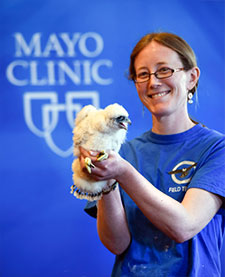
- The peregrine falcon is a raptor – a bird of prey that hunts and feeds on other animals, typically birds.
- The peregrine falcon is a crow-sized bird (1-3.5 lbs.) with long, pointed wings. Young birds, which are brown and cream colored, are heavily marked with streaks. Adults have a blue-gray back with a light, striped underside and a dark-colored head.
- Its Latin name, Falco peregrinus, means “wanderer.”
- The male is about one-third to one-half smaller than the female.
- The birds typically mature at two years and can live to nearly 20 years old.
- Peregrine falcons can migrate more than 15,000 miles per year.
- The peregrine falcon is the fastest member of the animal kingdom, able to reach speeds over 200 mph in spectacular dives called a “stoop.” It lives on every continent except Antarctica.
- The falcon has long been associated with European and Middle Eastern royalty. Records of the sport of falconry (using a trained raptor to hunt wild game) date back more than 4,000 years.
- Historically, the peregrine falcon preferred to nest on high cliffs near water. Today, the bird is also found on towers, bridges, and tall buildings such as those found on the Mayo Clinic campus in downtown Rochester.
Where are they now?
A look at some friends from the Mayo Clinic Peregrine Falcon Program
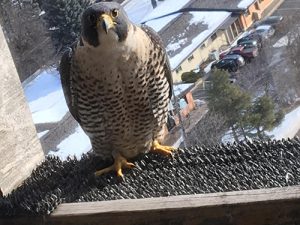 Epic – Epic is one of two females that hatched from Mayo Clinic in 2017. (The male was named Lucky Lindy.) Epic was seen at The Colonnade in Golden Valley, Minnesota, in February 2020 but was displaced when the resident female (unbanded, approximately 7-8 years old) returned on March 1. Epic is now nesting at the Anoka-Champlin Mississippi Bridge in the Twin Cities area.
Epic – Epic is one of two females that hatched from Mayo Clinic in 2017. (The male was named Lucky Lindy.) Epic was seen at The Colonnade in Golden Valley, Minnesota, in February 2020 but was displaced when the resident female (unbanded, approximately 7-8 years old) returned on March 1. Epic is now nesting at the Anoka-Champlin Mississippi Bridge in the Twin Cities area.
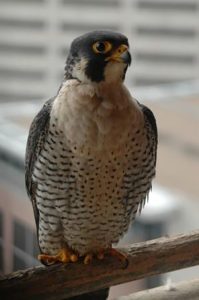 Sota – Hatched from Mayo Clinic in 1994, Sota was found in downtown St. Paul, Minnesota, in 1998, nesting with a female named Meg. They stayed together until 2005. Then Sota partnered with Jill from 2006-2012. In his lifetime, Sota produced 34 chicks. Along with being a prolific father, he was quite a survivor, since when he was found in 1998 he was missing four of his eight toes (and doing just fine).
Sota – Hatched from Mayo Clinic in 1994, Sota was found in downtown St. Paul, Minnesota, in 1998, nesting with a female named Meg. They stayed together until 2005. Then Sota partnered with Jill from 2006-2012. In his lifetime, Sota produced 34 chicks. Along with being a prolific father, he was quite a survivor, since when he was found in 1998 he was missing four of his eight toes (and doing just fine).
We suspect that frostbite caused the loss of the toes since he was known to spend winters in the city. The loss of the digits didn’t cause him any difficulties. He was an excellent provider to his mate and offspring. Sota lived to be nearly 19 years old. (Photos copyright Midwest Peregrine Society and used with permission.)
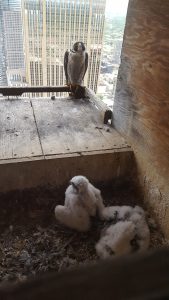 Triumph – Fledged at Mayo Clinic in 2013, Triumph was the father of three chicks in 2018 in the nest box at 33 South Sixth Street Tower (formerly International Multifoods Tower) in Minneapolis. Triumph had been spotted in downtown San Antonio, Texas, during the winter of 2017, and then he journeyed back to Minneapolis, where he and Genie had nested since 2016.
Triumph – Fledged at Mayo Clinic in 2013, Triumph was the father of three chicks in 2018 in the nest box at 33 South Sixth Street Tower (formerly International Multifoods Tower) in Minneapolis. Triumph had been spotted in downtown San Antonio, Texas, during the winter of 2017, and then he journeyed back to Minneapolis, where he and Genie had nested since 2016.
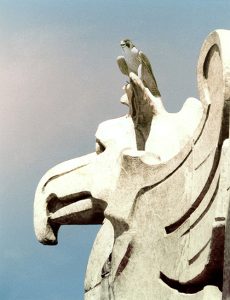 Chase – Chase was a male peregrine that also had strong ties to Mayo Clinic. In 1988, Chase was one of eleven captive-bred peregrines which were released on top of the Mayo Building. He continued to stay in Rochester, attempting to attract a mate, but was unsuccessful. He traveled to St. Paul, MN, in the fall of 1990, and suffered from a fractured wing during a territorial dispute with another peregrine falcon. Thankfully, he was rescued and transported to The Raptor Center at the University of Minnesota, St. Paul, MN. His injuries healed nicely, although he always had a slight bend in the outer portion of his wing. He was returned to Mayo Clinic in April 1991, and quickly attracted a female peregrine named Minnsoar. Chase paired with several females in his lifetime, and produced 15 young from 1991-1998. Many biologists of the falcon team consider Chase an “icon of peregrine recovery” in the state of Minnesota.
Chase – Chase was a male peregrine that also had strong ties to Mayo Clinic. In 1988, Chase was one of eleven captive-bred peregrines which were released on top of the Mayo Building. He continued to stay in Rochester, attempting to attract a mate, but was unsuccessful. He traveled to St. Paul, MN, in the fall of 1990, and suffered from a fractured wing during a territorial dispute with another peregrine falcon. Thankfully, he was rescued and transported to The Raptor Center at the University of Minnesota, St. Paul, MN. His injuries healed nicely, although he always had a slight bend in the outer portion of his wing. He was returned to Mayo Clinic in April 1991, and quickly attracted a female peregrine named Minnsoar. Chase paired with several females in his lifetime, and produced 15 young from 1991-1998. Many biologists of the falcon team consider Chase an “icon of peregrine recovery” in the state of Minnesota.
 Aurora – Fledged in 2008, Aurora has been the female on territory at the Washington University Medical Campus in St. Louis, Missouri since 2015. She has produced 21 young between 2015-2021. The researchers in Missouri tell us that Aurora is an exceptionally large and defensive female. Aurora was named for the aurora borealis or northern lights, which are quite an amazing display of nature in northern areas of the world.
Aurora – Fledged in 2008, Aurora has been the female on territory at the Washington University Medical Campus in St. Louis, Missouri since 2015. She has produced 21 young between 2015-2021. The researchers in Missouri tell us that Aurora is an exceptionally large and defensive female. Aurora was named for the aurora borealis or northern lights, which are quite an amazing display of nature in northern areas of the world.
The Mayo brothers, Dr. Will and Dr. Charlie, often said they grew up in medicine “the way farm boys are taught to farm.” All their lives, they shared a deep appreciation of nature. Dr. Will was an early advocate of efforts to clean the Mississippi River. Dr. Charlie made Mayowood, his country home, a preserve for many species of wildlife. The Sisters of St. Francis, who founded Saint Marys Hospital and are active in many activities at Mayo Clinic and beyond, uphold a reverence for nature.
Following World War II, the widespread use of pesticides, especially DDT, put many species of wildlife at risk. When DDT was banned in 1973, recovery efforts began for many threatened species, including the peregrine falcon. At the invitation of the not-for-profit Midwest Peregrine Society, Mayo Clinic began hosting the falcons in 1987. Mayo’s Peregrine Falcon Program is a popular annual activity, involving the support and collaboration of many colleagues. Some patients tell us they schedule their medical appointments in order to be on campus when the falcons are in residence!
Past Year Recaps
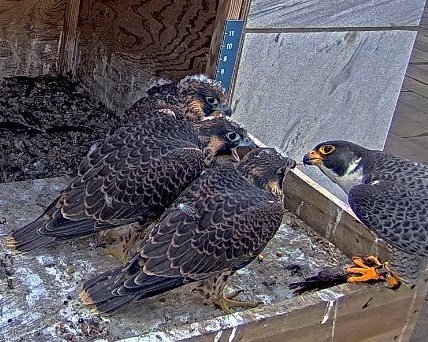
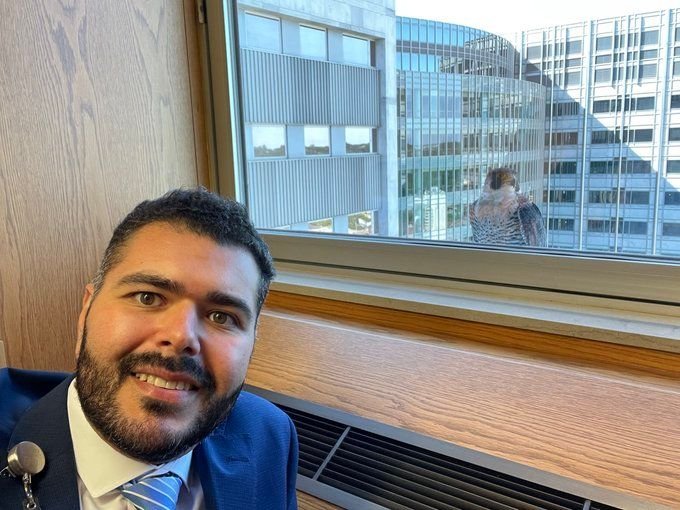
August 11 - The weather is getting cooler and change is in the air. The one thing that doesn't seem to change, however, is Hattie making window visits to staff and patients alike! The latest "Hattie" report was from Dr. Jad Sfeir, of Internal Medicine. He graciously shared his selfie encounter photo with the peregrine team, saying she kept posing for the photos, looking straight at the camera and didn't leave until he was done. What a wonderful opportunity and experience! Thank you so much Dr. Sfeir for sharing such a wonderful photo with us. How many of you have had similar experiences?
With the cooler weather, it is also expected that many birds will soon begin their migration journey. Although Hattie and Orton reside in Rochester, Minnesota year round, many other birds don't, including the 2022 fledglings Comet, Rebel, and Nova. Confirmed sightings of this year's fledglings haven't occurred since the first week of August, but that is normal behavior for peregrines. Typically, the fledglings only stay with the adults in their home territory for 6-8 weeks, before they explore their surroundings and find other places to call their own. Sometimes, the distance may only be 50-75 miles, and sometimes it may be 500 miles or more. We will have to patiently wait to hear reports or receive a note, telling us of a sighting. This is one of the most important reasons we band the peregrines in the first place to find out where their "wandering ways" take them. It is also possible that the fledglings are still within the Rochester city limits, and haven't begun their first migration as well.
We would love to hear about any peregrine sightings, especially if you can read the band information on their left leg. You can send your reports to us at peregrines@mayo.edu. Happy birding!
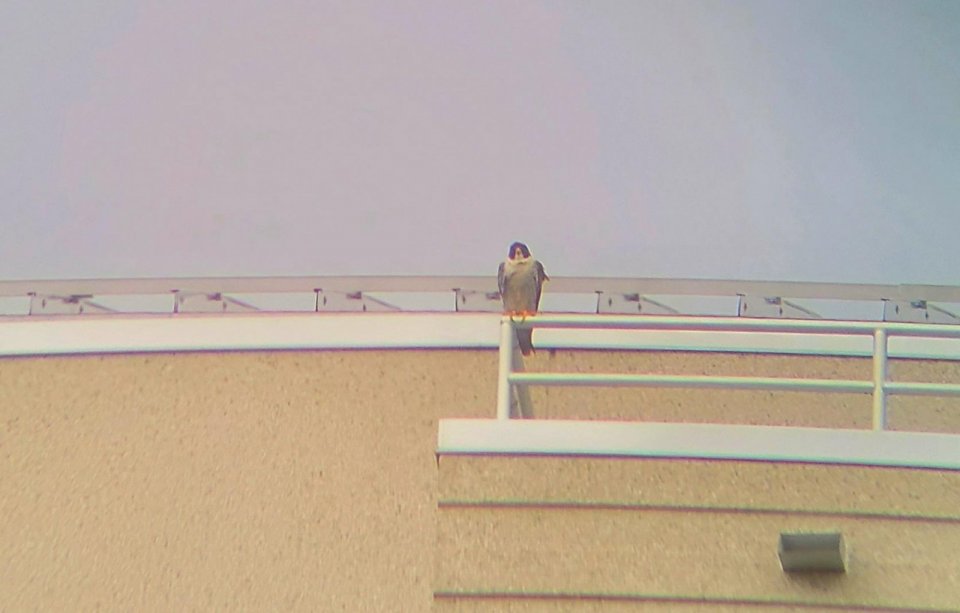
July 11 - Many of our falcon fans have recently emailed us, wanting to know if we had any news about the three fledglings or the falcon family since the last chick fledged on June 18th, 2022. Despite numerous days and nearly 40 hours spent over the past three weeks, we have very little information to share with everyone.
We DO know that both Hattie and Orton are doing well and are found during every visit. As can be expected, since the chicks have left the nest box, the peregrines have little need to spend much time at the box. Instead, they are using other areas of their territory, which includes the entire Rochester area. Lately, they appear to spend most of their time on buildings on Broadway Avenue, or the Gonda and Siebens building. The adults are busy teaching the young birds how to hunt and help out with a feeding if they are unsuccessful.
Unfortunately, we haven't been able to find all three remaining fledglings perched in a visible spot or perched long enough to get an ID on their banded leg. We have observed two fledglings in flight numerous times, but again never in a situation to be able to confirm their identity. These are the challenges of peregrine field work once the chicks have fledged. We do know that Rebel is still alive, since the one bird observed today was significantly smaller than the other fledgling.
We will continue to leave the camera on for the next few weeks, in the hopes of catching a glimpse of a visit by one of the falcons. We will continue to do weekly on-site monitoring and hope to have more information to share at our Facebook LIVE event on July 18th at 11 a.m. https://bit.ly/3bLDSIo
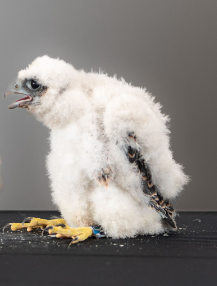
June 22 - On Monday, June 20, Facilities staff were finally able to safely access the peregrine nest box atop the Mayo Building and retrieve the remains from the chick which passed away on June 10. As we mentioned before, it wasn't feasible to do so until the remaining nestlings had fledged from the box and were not in danger of being startled by staff approaching the box.
Because of the delay in retrieval, it isn't a surprise that after examining the remains, authorities cannot speculate as to the cause of death. This is unfortunate, but our obligation was also to the remaining nestlings in the box and is at the basis of all decisions being made in regard to the birds. We appreciate everyone who has written or sent messages about this loss, which you can imagine has also impacted the staff and the entire peregrine falcon team.
For now, we are going to maintain the camera view on the outside camera only, since there is very little activity occurring in the box itself. This will also allow us to view any of the falcons within the immediate area of the roof, and help our monitoring efforts on the remaining peregrines. This is a fast-paced time of learning for the fledglings, as they are learning important life lessons from Hattie and Orton on flight skills, hunting, and adapting to an urban landscape. As of today, two of our fledglings have been observed with the adult falcons. We will continue to try and confirm the identity of all peregrines, when possible.
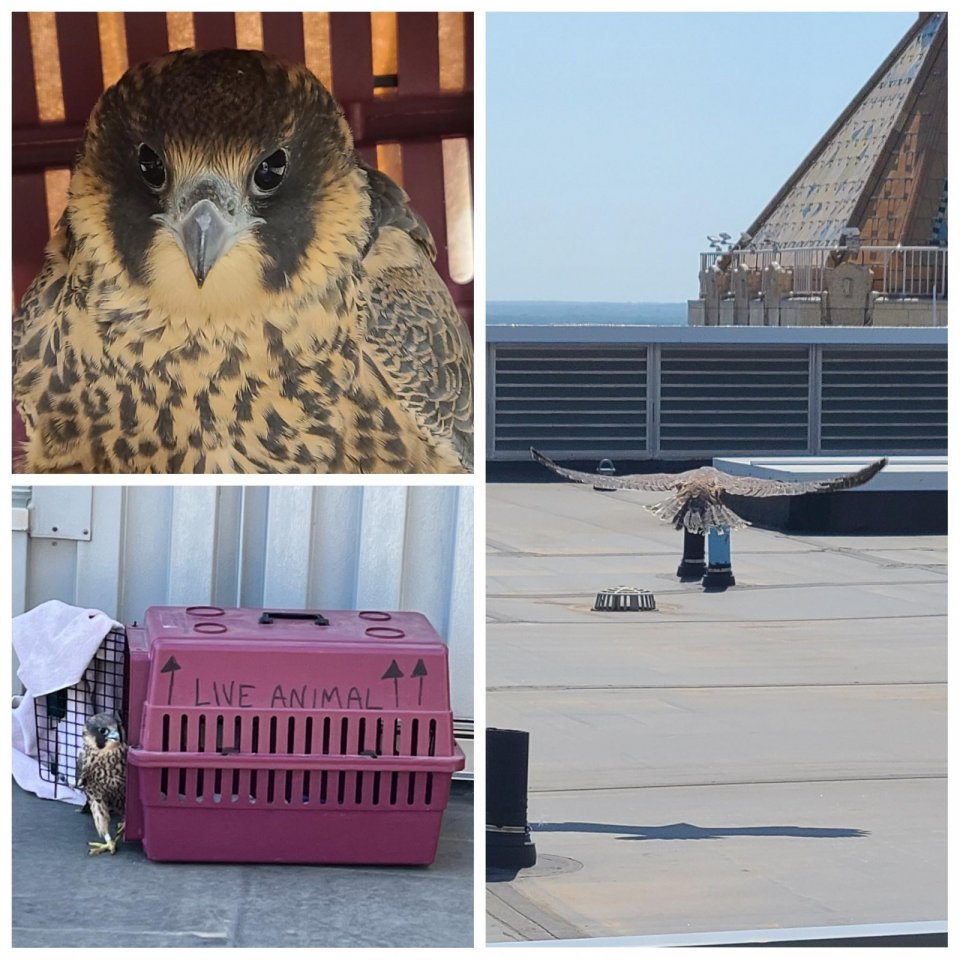
June 20 - Today we had the good fortune to return Nova to her home on top of the Mayo Building. On Saturday morning, Nova was found and rescued from a bench outside the Stabile Building on the downtown Mayo Clinic campus. Mayo Facilities contacted Jackie Fallon to determine the course of action. It was decided that Nova should be transported to Foxloft Conservancy, a wildlife rehabilitator in southern Minnesota, for further evaluation. It was determined that Nova needed to be examined by a licensed veterinarian, so Jackie transported her to the Raptor Center at the University of Minnesota in St. Paul. Nova received a clean bill of health and was cleared for release back at her home territory.
Early Monday morning, Jackie coordinated Nova's release with Mayo Facilities staff. Before we could return Nova to the rooftop, we retrieved the remains of Tom, the falcon that passed away on June 10. We decided that the best location to return Nova was the subroof below the nest box itself. This would provide a larger area for Nova to get her bearings when she left the transport carrier. This way, Nova would take her time before attempting flight again. She still has about about a half-inch of feather growth to occur, which will give her more control in flight.
The transport box was placed in a shaded area on the subroof and the door was opened. Meanwhile, Hattie promptly flew overhead, screeching, which was an encouraging sign indicating that the adults knew where Nova was. After a few minutes of assessing her surroundings, Nova slowly backed out of the crate, keeping a close eye on the human guardians nearby. She then took a low flight toward the center of the roof and flew out of view.
We will be submitting the remains of Tom, the falcon nestling, to try and determine cause of death. However, at this stage and delay in ability to retrieve the remains, we may never know the true cause of death. Stay tuned for more information, as it becomes available.
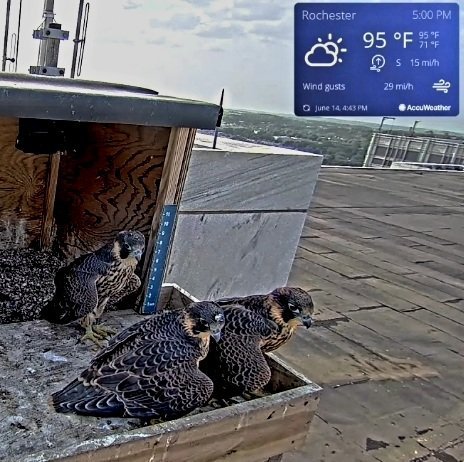
June 14 - As of June 14th, Comet, Rebel and Nova have all successfully fledged from the nest box atop the Mayo Building in Rochester. Nova, the youngest chick, took flight in the afternoon, but only made short trips from the safety of the box. In today's photo, you can see that all three are doing well, and continuing to spend the night back in their nest box-a place that is familiar and safe.
Due to her age at just 41 days old, Nova is definitely on the younger end of fledging age for a female peregrine. We say that, because her flight feathers in the wings and tail still have almost an inch to grow before being fully capable of sustained and controlled flight. When nestlings prematurely fledge in this physical state, they run a much higher risk of colliding with objects or ending up in dangerous situations. With the expected rain tomorrow, we hope that she will remain in the box a little bit longer, to gain every advantage of development that is possible.
Because Rebel fledged first, is the oldest, and a male, falcon fans may not observe him in the nest box very often anymore. His flight skills are improving on every successful flight and will begin to chase prey and the adults more often. This is the final stage of development and gaining independence as a peregrine. As we get reports of his whereabouts, we will be sure to share them with you. They are certainly living up to their name "The Wanderer" at this age.
Although Nova has officially "fledged", it is still unsafe for the team to approach the nest box to retrieve the remains of falcon "Tom". As soon as it is safe to do so, we will collect him and bring the remains to a veterinarian for a necropsy, although it will be difficult to identify for certain a cause of death. Thank you to all of our falcon fans for your emails of support and understanding during this difficult time.
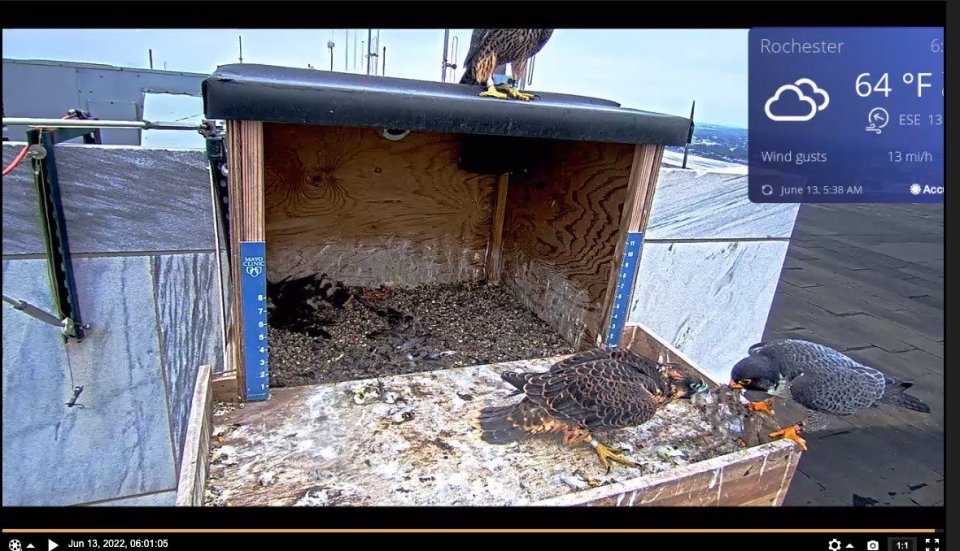
June 13 - This photo, time-stamped 5:38 a.m. CDT, shows Comet atop the nest box, just after she fledged. You can also see Orton on the deck, delivering breakfast. Nova is the youngest of the group and will hopefully stay in the nest box a few more days, until her feathers are more fully developed. Female peregrines are slower to develop than their male siblings, and have a more difficult time at fledge when they try to fly before they are truly ready to do so.
Note: We are sad to report that one of the four peregrine falcon chicks passed away. Please know that the deceased bird will not be retrieved at this time because the nestlings are so close to fledging. If anyone would approach the nest box now, it's likely that the nestlings would jump from the nest box and suffer injury or death because they cannot yet fly. The welfare of the three remaining chicks, as well as Hattie and Orton, remains our top priority and is at the heart of all decisions being made.
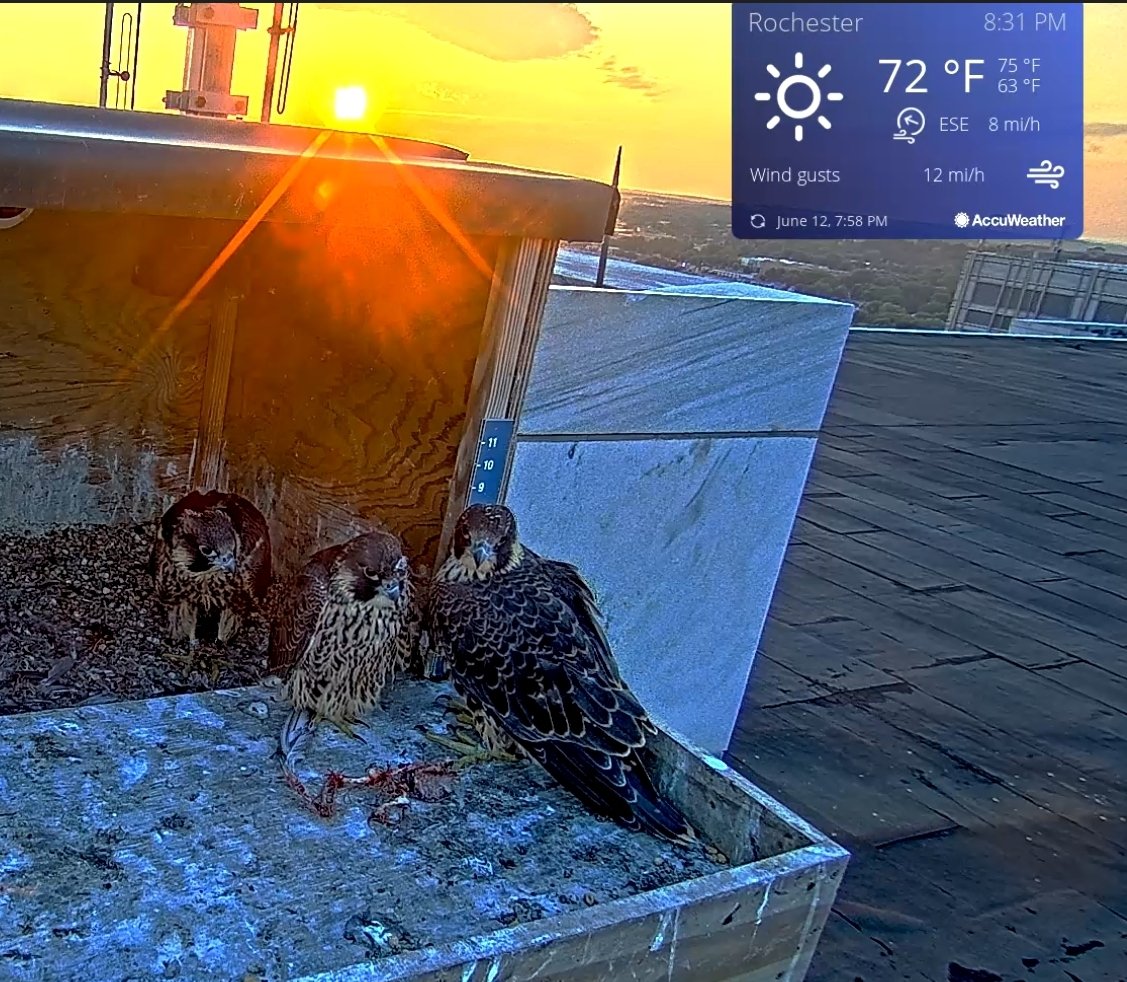
June 12 - We are happy to report that "Rebel" has successfully survived his first day of independence and has safely returned to roost in his natal nest box with his siblings. As you can imagine, there are many threats and unknowns that a newly fledged peregrine must learn about, if they are to survive in their new world away from the eyrie (nest). Typically, a newly fledged falcon will return to the immediate area around the nest for the first few weeks, where they are most comfortable and familiar, before venturing farther and farther away. Stay safe out there Rebel!
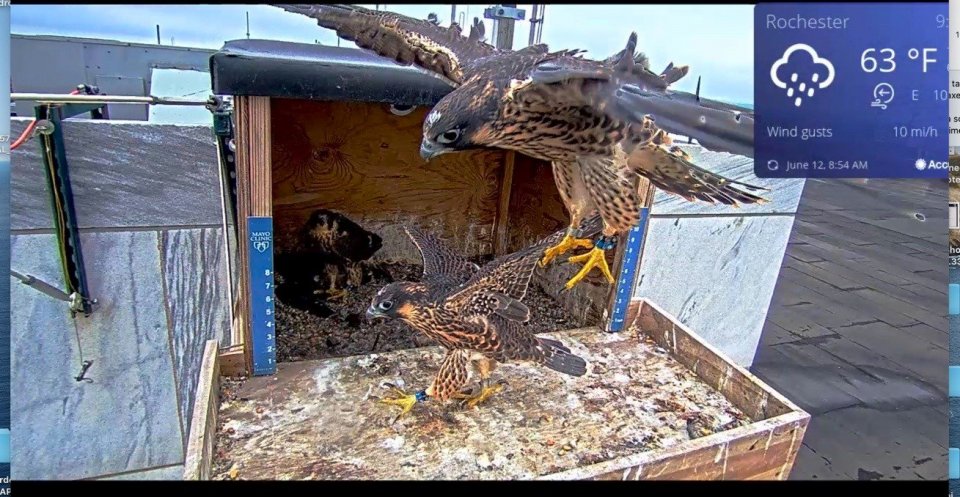
June 12 - We have fledge! At 8:54 a.m. CDT this morning, Rebel (one of the male chicks) spread his wings and took his first flight to the top of the nest box atop the Mayo Building in Rochester, MN. (This image is a screenshot, captured by our outside deck camera and Media Support Services staff). So far, Rebel has made several short flights around the area, and has safely returned to the nest box throughout the morning. If all goes well, he will return to roost in or near the box tonight with his siblings, on his first night of independence.
On that note, you might have noticed that the camera feed is up and running again. The peregrine falcon team has opted to turn the live feedback on to allow you to watch the fledglings up close. While everyone has shared in the sorrow over falcon Tom's unexpected passing, there is also a realization that this is part of nature. We have received numerous emails and comments via our Employees of Mayo Facebook page to watch the remaining falcons as they fledge and develop into independent peregrines.
Another common question we are receiving is: When will the two females take their first flight? Of course, the birds have their own schedule on these things, but we would expect Comet to fledge early this week, and Nova a day or two later. That said, sometimes the birds inadvertently end up being jostled out of the way on the deck and may prematurely fledge before they are capable of sustained flight. Fortunately, there is a sub roof right below the box, which should provide them with a safer landing than the street below. Stay tuned!
Note: We are sad to report that one of the four peregrine falcon chicks passed away. Please know that the deceased bird will not be retrieved at this time because the nestlings are so close to fledging. If anyone would approach the nest box now, it's likely that the nestlings would jump from the nest box and suffer injury or death because they cannot yet fly. The welfare of the three remaining chicks, as well as Hattie and Orton, remains our top priority and is at the heart of all decisions being made.
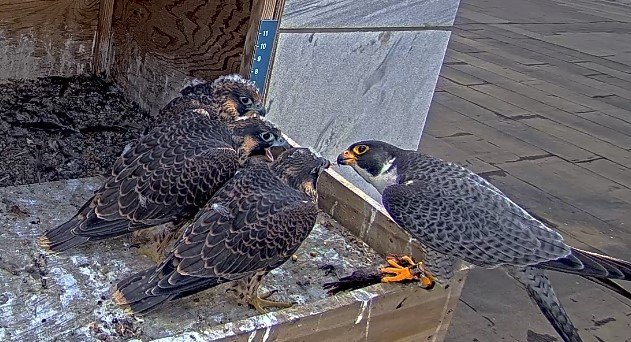
June 10 - We are aware of and are monitoring concerning developments in the nest box. It appears one of the young birds in the back of the box is not moving. Jackie Fallon, our expert from the Midwest Peregrine Society, is investigating and in contact with the Minnesota Department of Natural Resources. Right now, it’s not possible to get near the nest box as it would jeopardize the safety of the other young birds who are preparing for their first flight. We have received many messages from concerned followers and apologize that we are unable to respond to each one at this time. We’ll post updates as they become available.
In the photo above, taken around 5 p.m. today, Orton delivers prey and feeds three youngsters.
Update (6:30 p.m. CDT) - We are sad to report that one of the four peregrine falcon chicks passed away this afternoon. By reading the bands of the three remaining chicks, Jackie Fallon has confirmed that the deceased bird is Tom (b/blu 95/U). Jackie and team cannot confirm the cause of death and cannot speculate. Please know that the deceased bird will not be retrieved at this time because the nestlings are so close to fledging. If anyone would approach the nest box now, it's likely that the nestlings would jump from the nest box and suffer injury or death because they cannot yet fly. The welfare of the three remaining chicks, as well as Hattie and Orton, remains our top priority and is at the heart of all decisions being made. For now, the live falcon cameras have been turned off.
Thanks to all who have been faithfully following our falcons this season.
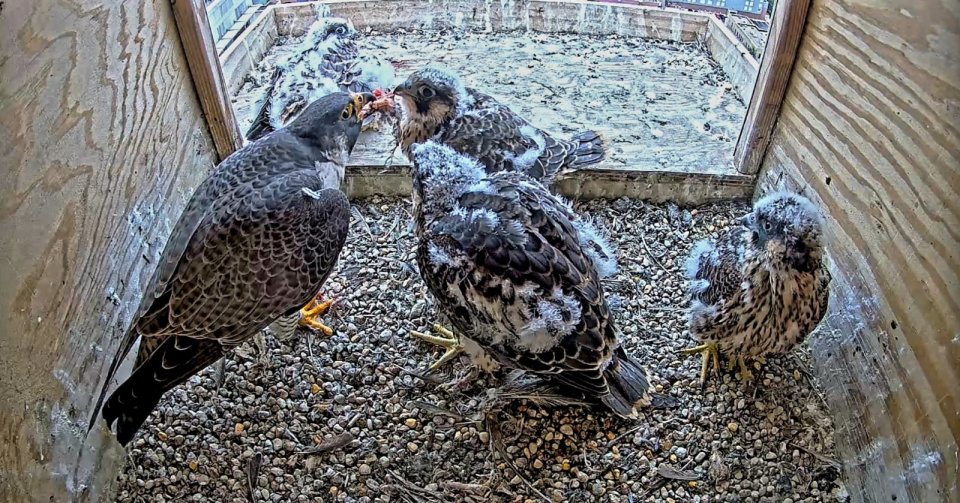
June 6 - We are in the final week of the chick's life in the nest box. By this time next week, it is possible that the oldest chick will have taken the leap of a lifetime and move into its next stage in life: Fledging!
Peregrine falcons typically fledge at about 40-42 days of age, with males fledging before the females do, because they are quicker to develop. Some female peregrines won't fledge until they are closer to 44-46 days old. For the 2022 Mayo brood of chicks, this means that we would expect the order of fledging to go as follows: Tom bblu 95/U; Rebel bblu 94/U; Comet bblu R/30 and Nova bblu R/31. The term "bblu" means "black over blue" band and the letter and number combination is the auxiliary band identifier on each chick's left leg. This color combination signifies that the chick hatched in the eastern U.S., according to the color assignments by the U.S. Fish and Wildlife Service and the Bird Banding Lab. This is an extra band which we place on the chick that you can easily read on camera. This helps us monitor the chicks without approaching them too closely.
Learn more about fledgling behavior and the challenges that newly fledged chicks face as they take their first flight through the special "Meet the Falcon" program available here: https://www.facebook.com/events/589469192407279
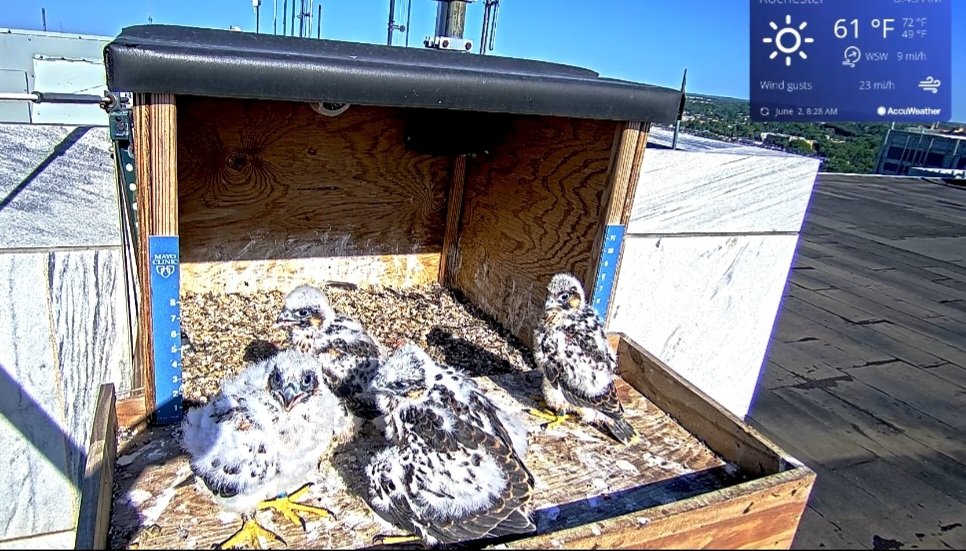
June 2 - The chicks are now at about full adult size and body weight, at 28 to 30 days old. The majority of their development at this point is advanced behavior and growing outer body and flight feathers. The oldest male and female chicks are nearly 50% or more brown and really beginning to look like peregrine falcons. The youngest male is considerably behind in his outer covert feather development compared to his oldest siblings, but I can assure you that this is normal and he is just fine.
The chicks are also spending A LOT of time preening during the day, and even nighttime. Those feathers are somewhat "itchy" and they need great care to stay healthy. The falcons gather a special oil from a gland at the base of their tail to apply to the feathers, which helps to keep them clean, healthy and waterproof.
You may also see the chicks start to fight over food that is brought to them by the adults, and even stealing the entire prey item, and try and keep it for themselves. This is when being an older female might have some advantages over a younger male sibling, even when that age difference is only two days. Again, the adults are spending almost no time in the box now, because of the age of the chicks and aggression towards the food they deliver to the box. Both Hattie and Orton continue to spend quite a bit of time hunting, in order to feed the four chicks and themselves. As we've mentioned before, pigeons are an important prey item for the falcons, in addition to other small to medium sized birds and even an occasional bat!
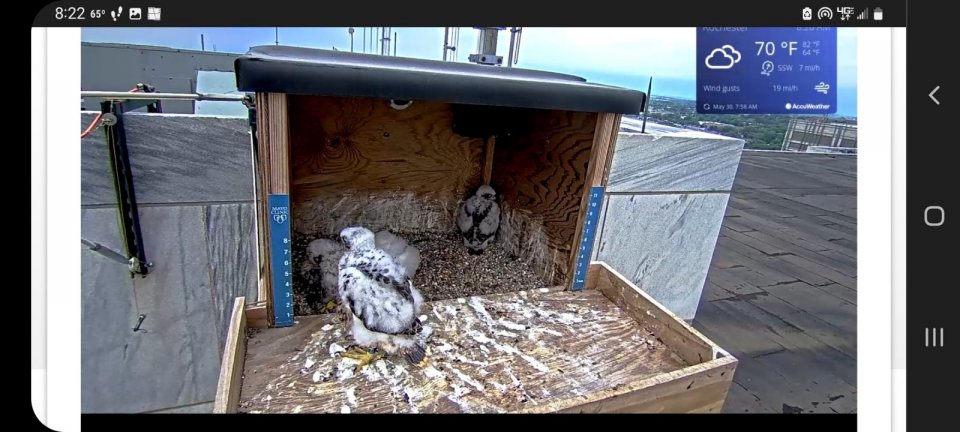
May 30 - Happy Memorial Day! The nestlings are now 25-27 days of age and progressing nicely to the next stage of their development: getting ready for their first flight! As you can see, Comet (the oldest female) has made the first jump onto the outside nest box deck. This is a natural progression in a peregrine's development, where they start exploring their surroundings, stretching and jumping, and becoming an independent falcon.
You may also notice how many more brown feathers are growing in on their outer body, and the increased length of their flight feathers on their wings and tail. At this stage (25-35 days of age) they seem to physically change right before your eyes! They are becoming bolder with each other and towards the adults when food is present, sometimes quite aggressively. They will start to tear apart food on their own and won't need to be fed by their parents anymore either. This is all part of growing up on their journey to independence and venturing out into the big world beyond their natal territory.
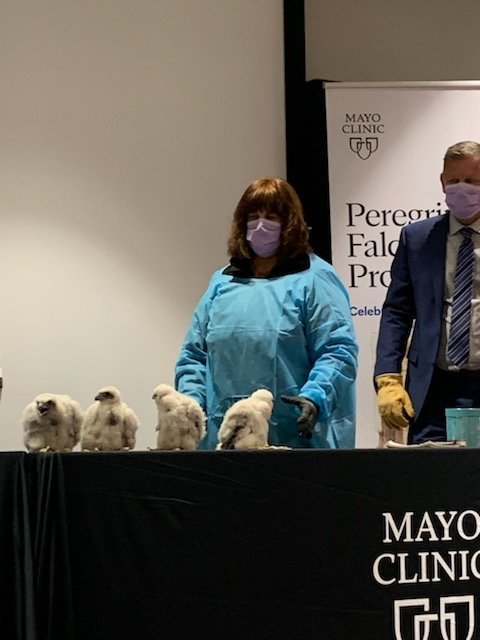
May 25 - Well, the big day finally arrived! The staff from Mayo Clinic's Peregrine Falcon team and Midwest Peregrine Society banded the four nestlings earlier today, as part of a live feed on the Clinic's social media page. The team carefully planned out the day's event on who was doing what, and how best to make it all happen smoothly and efficiently.
The team gathered at 11 am to meet one another, our invited guests from the media, and the Child Life team. Jackie Fallon, peregrine state coordinator for the Midwest Peregrine Society, explained the process to those who had never experienced the retrieval and banding event, so we could then focus on things once we accessed the roof. At noon, the entire team and guests proceeded to the rooftop of the Mayo Building to retrieve the chicks from the nest box. While Jackie, Tom Behrens from Facilities Management and Peter Smerud from Wolf Ridge ELC transferred the chicks from the nest box to the transport box, other staff held umbrellas over the team to protect guests and those at the box from the defensive flights of the parents. As you can imagine, the adults are protective against any threats to the chicks, including humans. Thankfully, things went according to plan, and within minutes we had retrieved the chicks and were off the roof.
The next stage of the event was to gather in Judd Auditorium on the Mayo campus, where the actual banding would take place. While Peter removed each nestling from the transport box and weighed it on the scale, Jackie determined whether the chick was a male or female in order to apply the appropriate sized band. Jackie recited the band number and information to Trish Amundson from the Heritage Days Committee, who then recorded all the vital information in the record book. Jackie then applied the bands on each chick, performed a quick exam to look for any signs of illness and then the banded chick received its name.
This year's brood included two male and two female nestlings. The names for the chicks were submitted from Mayo employees across the country, as well as school children and other interested falcon fans. We received over 1700 names from nearly 500 people, which was amazing! The committee made a final selection of twelve names to choose from via a drawing once we knew what sex each chick was. The Child Life team members were given the honor of drawing the final name choices from the bins, and they are as follows: the female names were Comet and Nova and the male names were Rebel and Tom. The name Tom specifically was chosen to honor Tom Behrens for his 30 years of service and support of the peregrine falcon program at Mayo.
We hope everyone enjoyed watching the banding and naming event this year. This is always an exciting day for everyone on the team, as well as our thousands of falcon fans all over the country. The chicks will be changing almost daily now with their feathering, from white fluffy balls of down to sleek brown and cream fledglings, and taking their first flight in about three weeks' time.
If you missed the live event, you can view it online in two parts:
Part 1 https://bit.ly/38s2KDM
Part 2 https://bit.ly/3Lj8Q6G
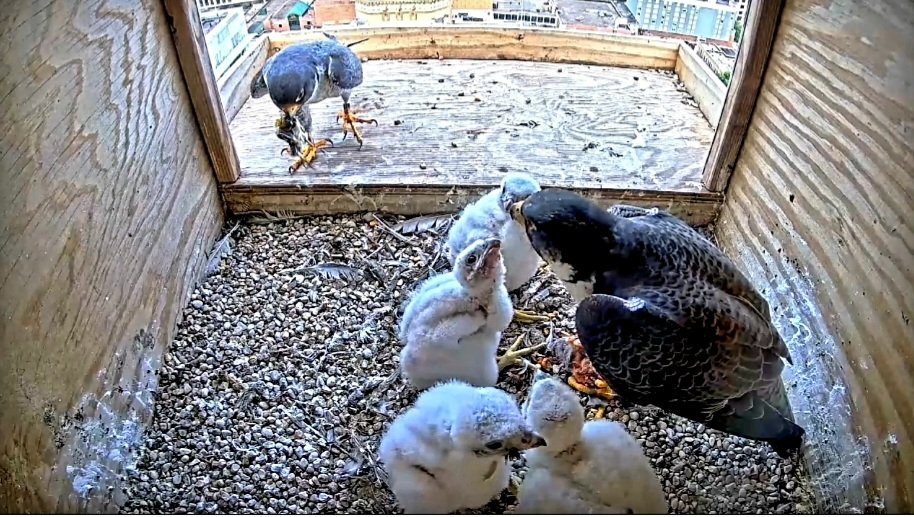
May 20 - The eyasses (nestlings) are now 15-17 days old and are seeming to grow larger right before our eyes! At day 14, they start growing their flight feathers on their wings and tail, which requires even more food than ever. Both adults are now actively hunting for the family, as shown in this photo. Hattie (right) had just brought in a pigeon, while Orton (left) brought in a much smaller songbird. You might even notice that the eyasses are constantly vocalizing to their parents, to bring them more food.
You may also notice that the chicks are spending more time flapping their wings and awkwardly stumbling about the box. They are becoming more curious about their surroundings as well, and even starting to pick up pieces of food left in the box by the adults. It always amazes me how quickly they change and develop motor skills in such a short period of time.
We want to thank everyone who submitted names for this year's brood of chicks. We had over 400 people submit over 1600 names, which is AMAZING! The names have come from employees as well as community members, both near and far. The creativity in names submitted ranged from things that reflected Mayo Clinic's history and staff, the biology about peregrine falcons, to important historical events and people in 1987, the year that Mayo Clinic joined the restoration efforts to save peregrines in the Upper Midwest. The submission list is now closed, and the falcon committee is now starting to look through all of the names to come up with a list for Wednesday's banding and naming event. I can tell you it will be a difficult decision to try and select 12-15 names for the drawing of names at the banding and naming event.
A reminder to watch us LIVE on Wednesday, May 25th at noon - 12:50 p.m. Central Time via Facebook Live. Part 1 (12-12:10 p.m.) https://bit.ly/38s2KDM and Part 2 (12:20-12:50 p.m.) https://bit.ly/3Lj8Q6G. Part 1 will be video feed of the field team and Mayo staff retrieving the eyasses from the roof of the Mayo Building, while Part 2 will be the actual banding and naming event. The videos will be available after the banding and naming, for those who cannot watch the process live. We hope many of you can join us in celebrating 35 years of peregrines at Mayo Clinic.
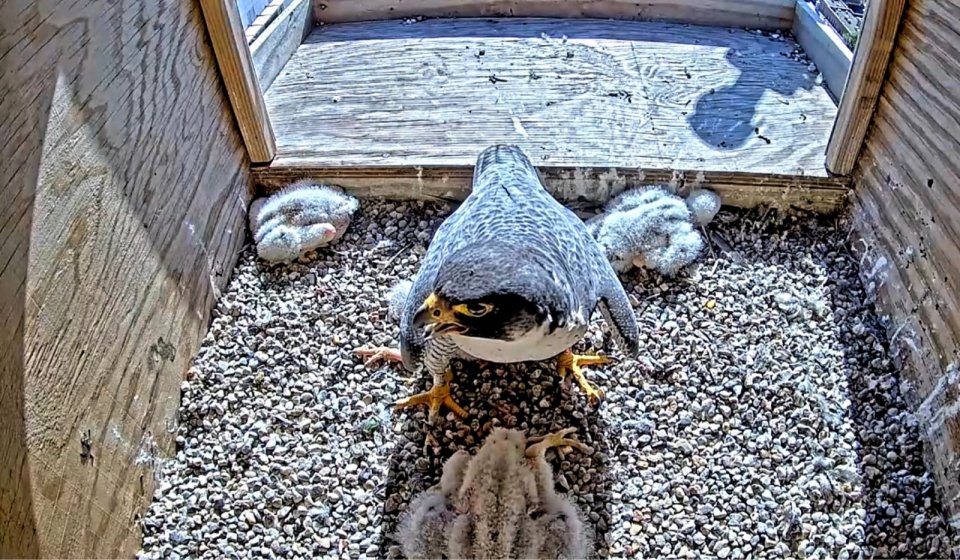
May 15 - The falcon chicks are now 12, 11, and 10 days old and beginning to explore the nest box independently of each other. This also happens because they are developing more feathering and no longer need to stay huddled together for warmth. You may even see them spread out and appear to be sick or unresponsive. I assure you that this body positioning is completely normal and how the nestlings get rid of excess heat with the warmer temperatures. This is also how they rest during the day. Today's photo is a perfect example of normal chick and adult behavior, in dealing with a warm, sunny morning.
You may also notice in the photo that the adults may pant (open their mouth to breath) and hold their wings open and away from the body. This is how they will keep their body cool, when they aren't taking a bath in cool water. Those same feathers that insulate them against -20 degrees F weather are also very insulating during warm spring and summer days. In this photo, Hattie is also sheltering the single chick in the middle from the sun. As we've mentioned before, our nest boxes purposely face east to only get morning sun instead of excessive afternoon heat.
Lastly, we've received numerous emails this week about not seeing the chicks and being concerned about them. Please don't be alarmed if you only view one chick in the box, or if you don't see any chicks in the overhead camera view. This camera angle doesn't cover a small area at the very back of the box, and the nestlings are often lying down in that area and are out of view. If something should happen to the chicks, we will be sure to alert you of significant changes via the Employees of Mayo Facebook page or on this website.
A reminder to send your naming suggestions to HeritageDays@mayo.edu by May 20th at 5 pm. We have already received some wonderful choices for this year's "Class of 2022", celebrating 35 years of peregrines at Mayo. Thank you all!
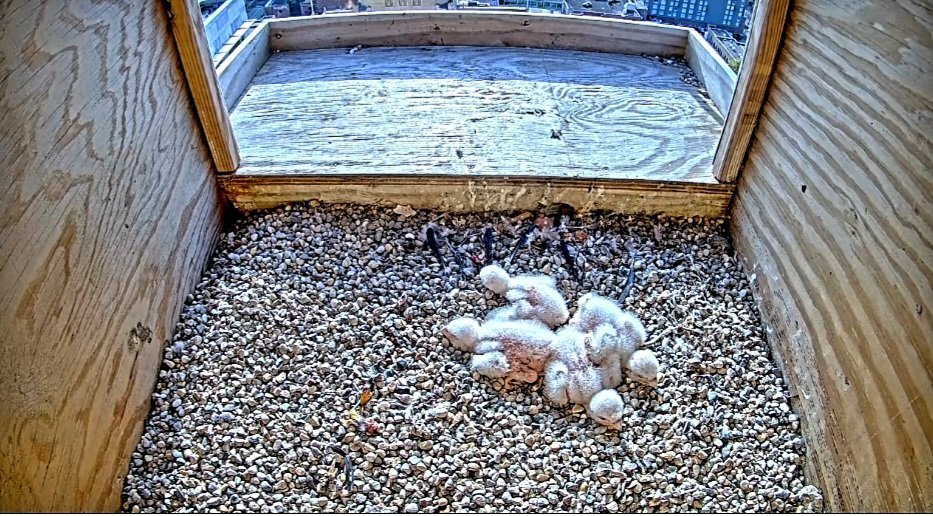
May 10 - The chicks are now 5-7 days old, and all appear to be doing very well. Hattie and Orton are being kept busy by catching enough food and keeping the chicks warm. At day 7, the two chicks are nearly three times larger than they were when they hatched!
You may notice that the adults are starting to leave the nestlings alone a little bit more and more each day. No need to worry, one of the adults is right nearby, perched just outside the nest box at all times, while the other one is out trying to catch more food. Also, the weather is finally warmer, so you may see the adults shading them from the sun as well. Lastly, the chicks are also growing in more feathers, so they can start keeping themselves warm enough, without help from the parents. Life is busy, and exhausting for the nestlings, so unless they are eating, they are sleeping. Soon enough, they will start standing up more and start preening in those new outer feathers that will start to grow in. Until next time...
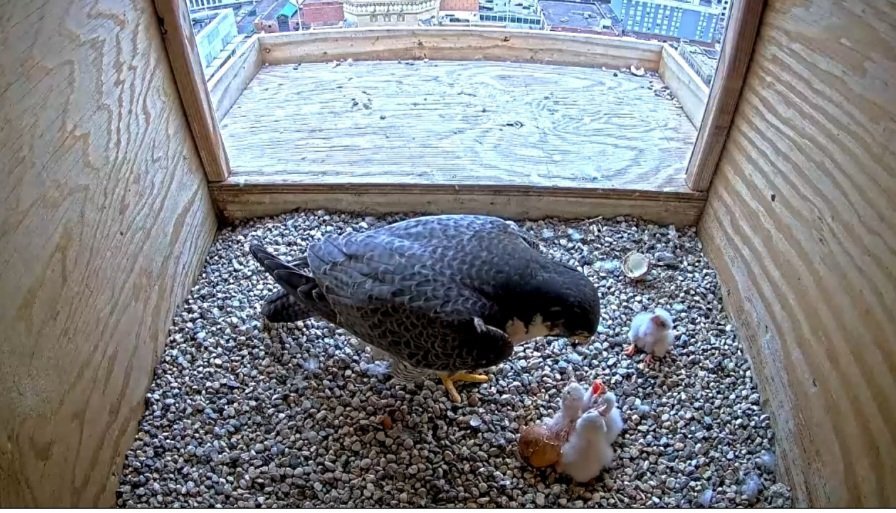
May 5 - Just when we were receiving numerous email inquiries about the possibility of egg number 4 hatching or not, the little chick arrived right when it was supposed to do so. At about 3:15 pm today, Orton brought in some fresh dinner and Hattie immediately started feeding the four chicks. You can even see that one chick in the center grouping of three, is still fairly wet and not dried off from hatching. It can take up to an hour or so to dry off and they won't generally eat much the first 24 hours, if at all.
Now that all four eggs have hatched, you will see more and more food being delivered into the nest box by Orton. Also, Hattie will start leaving the box more in the upcoming week and allow Orton the opportunity to feed the chicks as well while she will eat her meal just outside the nestbox. Also, don't be alarmed if you don't see each chick receive exactly the same amount of food as their sibling. The chicks don't need to eat more than a few mouthfuls right now, and they will be offered food every few hours-day and night.
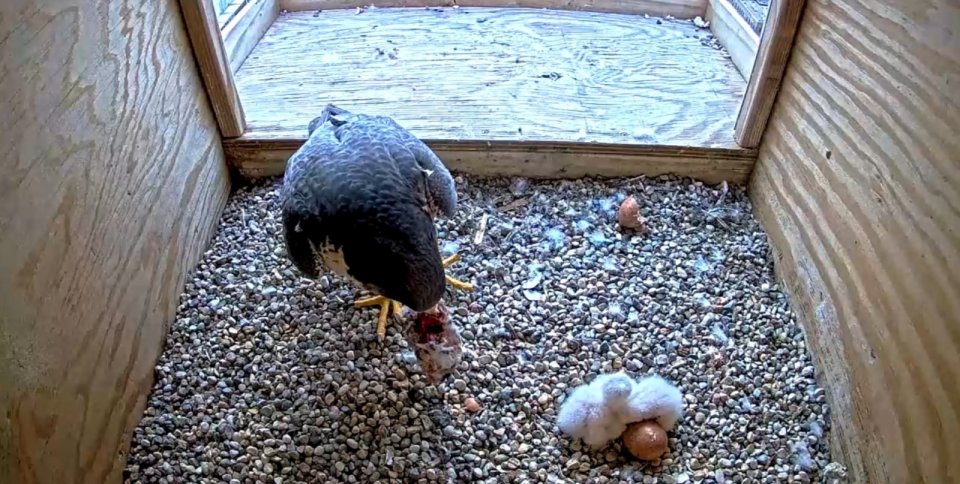
May 5 - Breakfast in Bed! Hattie and Orton have been busy feeding and caring for the three new chicks (eyasses). Most often, Hattie is providing care for them, but every once in awhile she takes a short break and allows Orton some time with them. When Orton isn't taking his turn with the chicks, he is busy trying to catch enough food for himself, Hattie and the new nestlings. Considering the chicks will double in size within 5 days, you can imagine how much food they need to eat. Pigeons are the primary food item brought into the box, but you may also see smaller birds as well. Peregrines have been known to prey upon over 100 different kinds of birds in Minnesota, but most often the prey range in size of 50g-500g in size. Also, bats are occasionally taken in certain locations in the state, but never confirmed at Mayo Clinic.
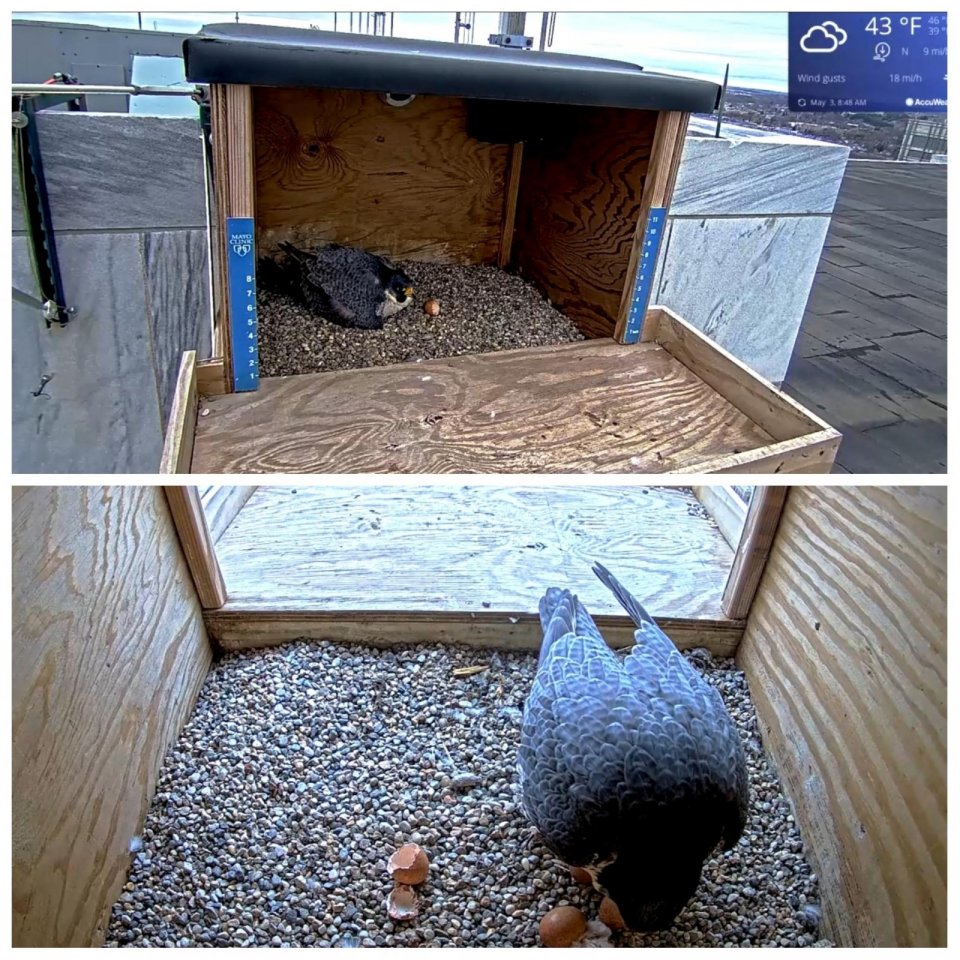
May 3 - The wait is finally over and we had our first chick hatch this morning at 8:31 a.m.! It was noticed that a small pip in the eggshell happened yesterday, and over the next 24 hours, the chick used its egg tooth to slowly chisel its way out of the egg. You could even hear the chick peeping before it hatched, thanks to the wonderful audio in our nesr box! The remaining eggs should all hatch within the next day or so if they were fertile and healthy.
You may notice that Orton is making numerous visits to the box, hoping to entice Hattie off the eggs and chick. However, she is reluctant to leave them right now, so it is difficult to get a glimpse of the chick(s) nestled underneath her. Be patient and you might get lucky in catching a quick peek. As the chicks get older, and once all the eggs hatch, it will get easier to see them when the adults shift in the box or exchange duties.
At this time, we would like to formally open up the naming submissions for the 2022 brood, so feel free to submit your name suggestions to heritagedays@mayo.edu
Suggestions will be accepted until 5:00 p.m. CDT on May 20th. Names of the chicks be announced during the banding event on Wednesday, May 25th at noon. Happy 35th Anniversary, Mayo Clinic Peregrine Falcon Program!
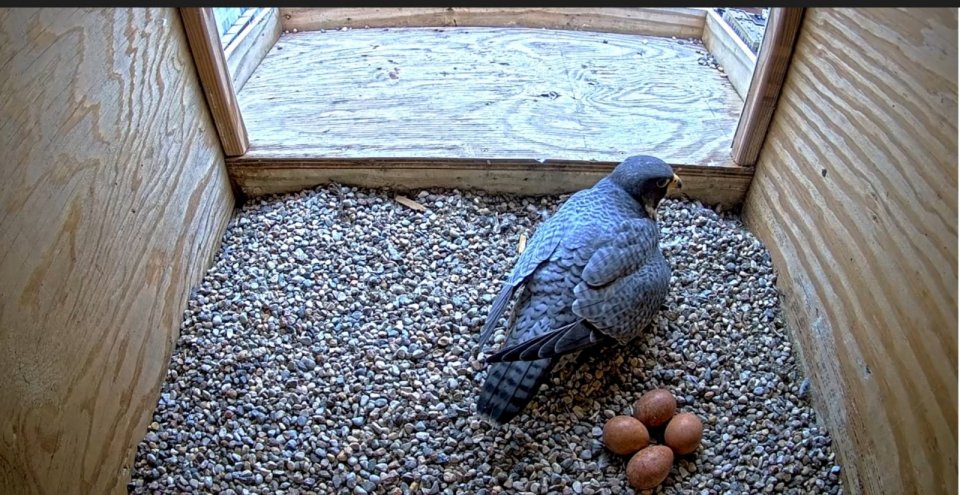
April 24 - We are in the final days before the eggs should hatch! I know it seems like forever sometimes, but it has only been 27 days since the third egg was laid, and when "true" incubation began. Hattie and Orton have been doing a fantastic job of keeping the eggs at a constant temperature during this abnormally cold spring, and it can be difficult to catch a glance at the four eggs. We were lucky to catch this view of the eggs during such an exchange.
During hatch, the chick will use the egg tooth on top of its beak, to slowly chisel its way out of the egg. This is called pipping, and can be exhausting for the chick. Pipping can take up to 72 hours or so, and during this time the adult may be acting very agitated and even appear to sit upright over the eggs. You may even hear them vocalize to the chicks while they are hatching! You then know the time is getting close. We are estimating that hatch will happen around May 2nd to 4th, so start watching carefully for the first little hole or crack to appear around May 1st. Of course, we are all hoping for a full brood of four chicks to hatch, to help celebrate our 35th Anniversary.
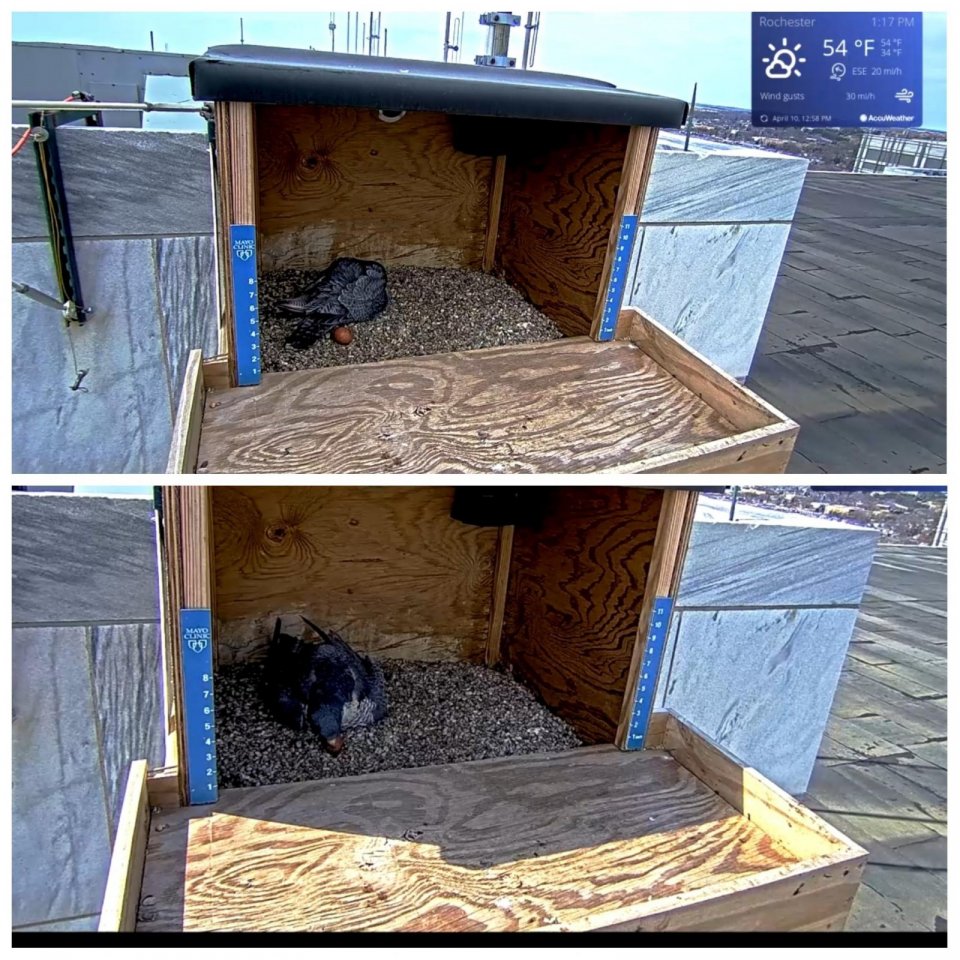
April 10 - This afternoon, it was noticed that one of the eggs happened to get separated from the other three in the scrape. We are uncertain on how this happened, but after about an hour, Hattie noticed the lone egg while she was shifting position and gently pulled it back with the others. This should not make a significant difference in hatch, due to the warmer temperatures on Sunday, but time will tell when incubation is complete. We are on day 14 of incubation with the four eggs in the nest box on top of the Mayo Building and eagerly expecting hatch to happen the first week in May. We will have more updates during our monthly Facebook Live appearances on April 18th at 11 am CST. Bring your questions!
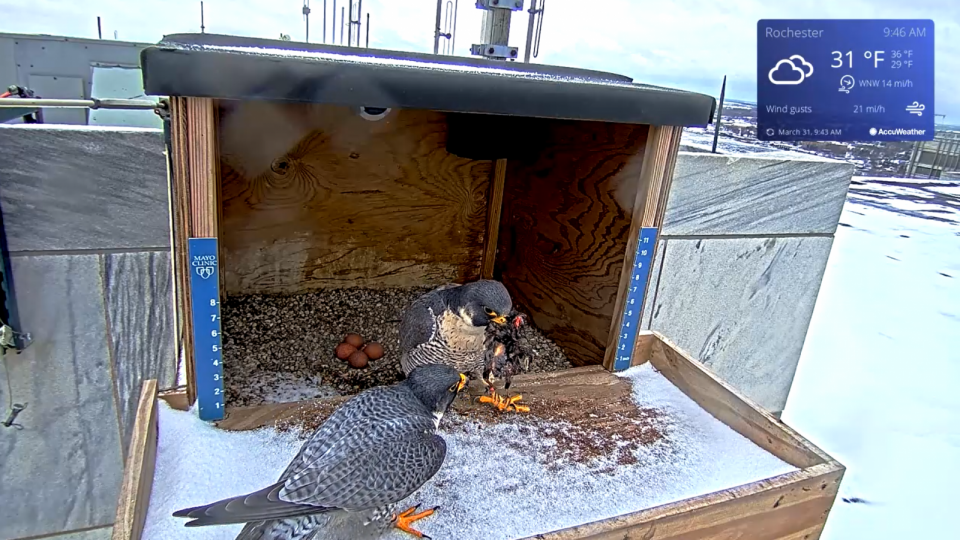
March 31 - The fourth egg arrived sometime overnight or early this morning. This photo, taken at about 9:50 a.m., shows a food exchange between Orton and Hattie before trading off incubation duties. Now it's very interesting to watch the adults as they trade off to incubate the eggs. Hattie's body is quite large so she has an easier time keeping all the eggs covered, while Orton has to do more shifting and maneuvering of his body.
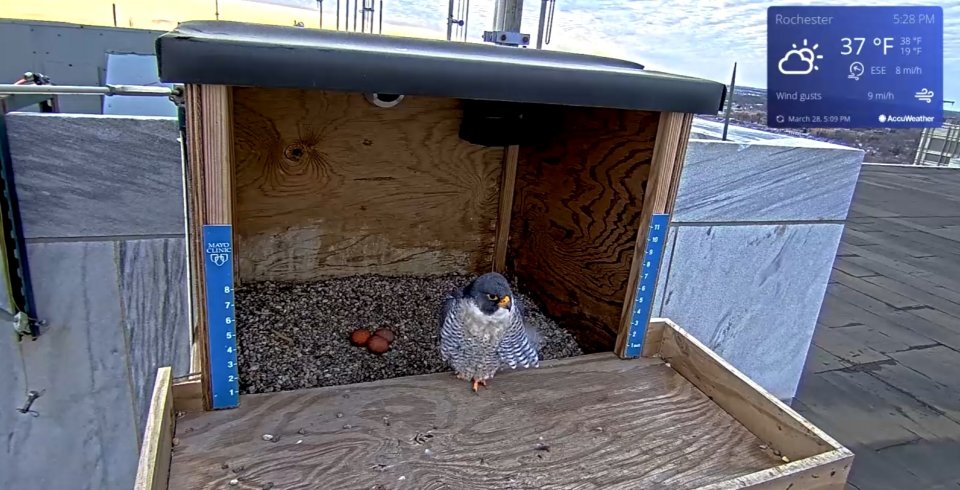
March 28 - The peregrine pair, Hattie and Orton, continue right on schedule with their egg laying sequence for the 2022 nesting season. The third egg arrived this afternoon, and while Hattie took a short break from incubating, we were finally able to get a screen capture of the three eggs in the nest box atop the Mayo Building. If history repeats itself, there should be one more egg laid in the gravel, although it is always possible to have up to five eggs. If there will be a fourth egg laid, it should arrive by March 31st, possibly a little earlier.
Now that we have three eggs in the clutch, true incubation will occur by the pair of falcons. This means that the adults will rarely leave the eggs uncovered for more than a minute or so, unless the temperatures get in the 80's or so. The adults keep the eggs at about 99.5 to 100 degrees Fahrenheit and will use their beaks to turn the eggs several times during the day. The female peregrine does most of the incubation of the eggs, while the male will relieve her of the duties during the day while she eats, stretches, or takes a short break. The female is rarely off the eggs for more than an hour at a time and does all of the incubation during the night hours. This is especially important when it is so cold out, like we are experiencing in Minnesota over the next couple of weeks.
Our 2022 nesting season is off to a great start! What a great way to celebrate 35 years of peregrine falcons at Mayo Clinic.
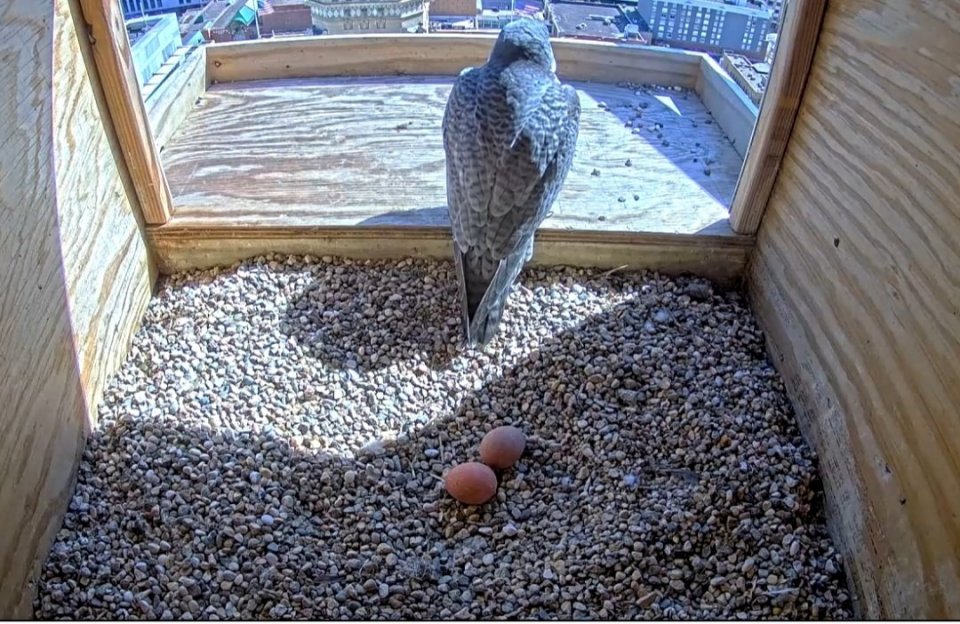
March 26 - Many of you might have noticed that egg #2 arrived sometime overnight, right on schedule. Today's photo shows the male falcon, Orton, standing guard over the eggs. With the expected cooler temperatures over the next few days, you may see the adults covering them quite a bit. Just a reminder that they are just keeping the eggs from freezing, and not truly incubating them. Egg number three should arrive by Monday evening or by Tuesday morning.
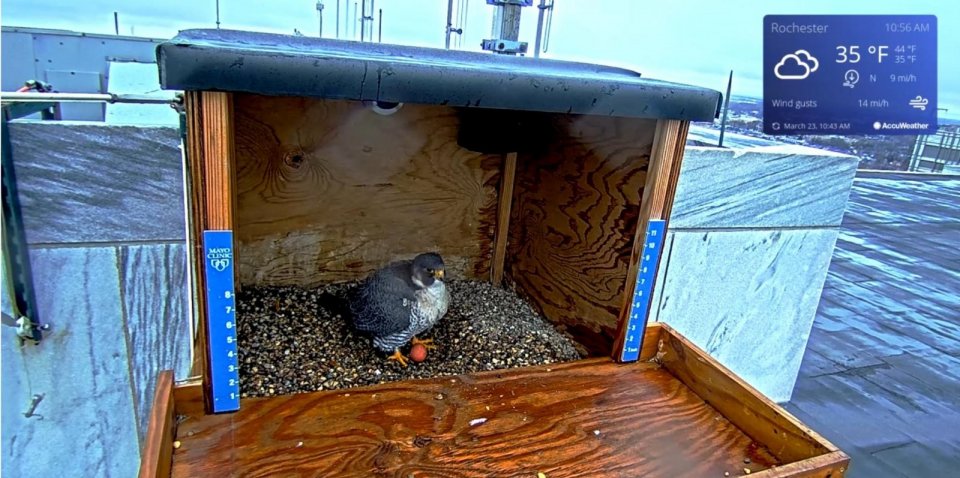
March 23 - The long awaited day arrived today, specifically at 10:37 am CDT...the first peregrine egg for Hattie and Orton's 2022 nesting season! Hattie has been spending more and more time in the nest box the past few days, spending time perfecting the scrape where the eggs would be laid and just standing guard. This morning we noted that she was spending more time bending over, shuffling in the gravel, standing up, and then shuffling in the gravel again. Behaviors like this are strong indicators that a bird is getting ready to lay an egg. So, what's next? Here are some answers to common questions about egg laying and incubation.
Why do the peregrines leave their eggs uncovered during the first days? Peregrines don't start true incubation until they lay the second to last egg of the clutch. This way, all of the eggs will hatch at about the same time. The adults may cover the eggs during really cold temperatures, but are not truly incubating them. This happens most often at night, especially in northern states where the air temperature is below freezing.
How many eggs will Hattie lay? Typically, peregrine falcons lay between three and four eggs in a clutch. They can lay anywhere from one to five eggs in a single clutch. They will normally lay an egg every 24-48 hours apart, although sometimes it may take up to 72 hours between eggs. The eggs are a little smaller than the size of a chicken egg, and are speckled brown in color.
How long is incubation in peregrine falcons? Incubation for peregrine falcons is between 33 and 35 days from when that second to last egg is laid. Most often, all of the eggs will hatch within one to two days of each other, although we have seen it take almost four days in rare cases. Sometimes the incubation can last an extra day or two in cooler weather.
Who incubates the eggs? Both adult falcons incubate the eggs, although the female peregrine spends the most time incubating, especially overnight. The male peregrine will take his turn incubating while the female is taking a rest and eating or stretching her wings. During this time, the male peregrine does all of the hunting, to feed himself and the female peregrine.

March 14 - Good evening, everyone! We just wanted to give you a quick update on Hattie and Orton. The past week you might have noticed that Hattie is spending more time in the nest box than in previous weeks. As we get closer to egg laying, her hormone levels are increasing, and she is taking more of an interest in the nest box and defending the territory. So far this season, she has successfully defended the area from two other intruding females, which can be quite an intense and vocal display. Looking back at the past five years of data we have on the pair, we could expect to have our first egg laid by the end of March.
Thanks to AZ staff member Elias Chavez for sharing today's image with us.
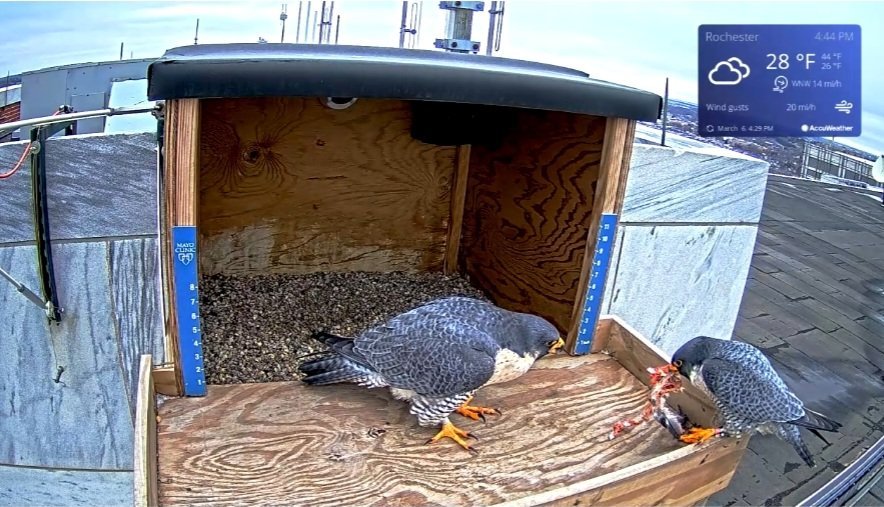
March 6 - A food prey exchange between two peregrine falcons is an important part of the falcon's courtship behavior. Most often, it is the male peregrine bringing in a variety of food items to the female, showing off his expert hunting skills. This prey exchange can occur in the air or near the nest ledge, which is what is happening in today's photo. Here, you can see Orton on the right side of the box with the partial pigeon and Hattie is bowing towards him on the left. Often the two birds will bow toward each other and be quite vocal during these exchanges. All of these behaviors and vocalizations help solidify the pair bond before the first egg is laid.
This is also a great photo showing the size differences between a male and female peregrine. In the pair of falcons at Mayo Clinic, Hattie is nearly twice the size of Orton. In raptors, this size difference allows females to capture larger prey, while the males most often hunt smaller items under a pound in size. Here, this adult pigeon is over half the size of Orton! The powerful stoop flight is a wonderful adaptation for falcons, which helps them to capture prey such as ducks, grouse, and even birds as large as sandhill cranes!
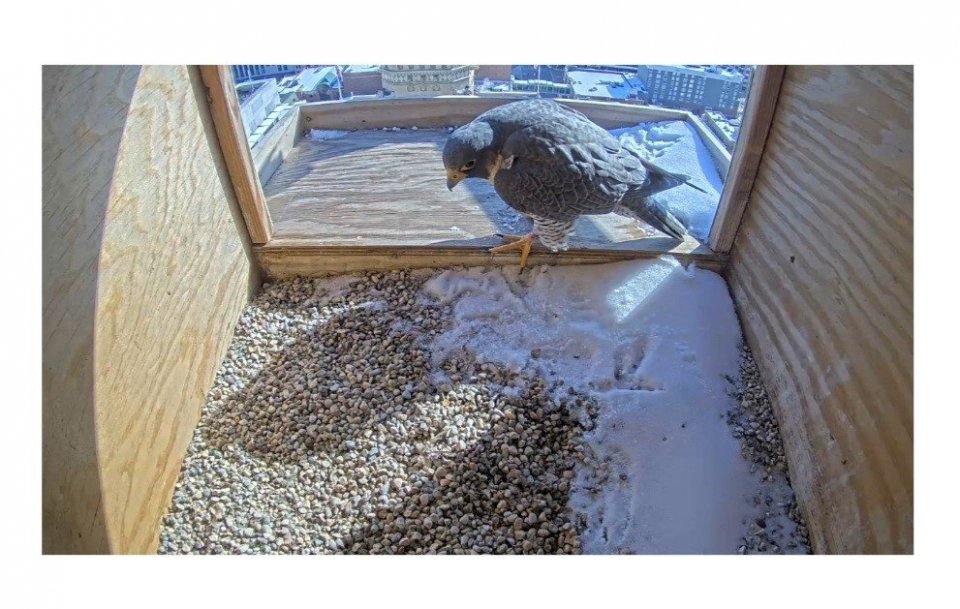
February 27
In this photo you can see the adult female, Hattie, exploring the nest box. This is an important behavior for a nesting pair of peregrine falcons. Although the male falcon is often the one to attract a mate to the territory, it is the female falcon who chooses the specific nest site within the territory. As the female gets closer to egg laying, both the male and female will spend quite a bit of time in the eyrie (nest ledge or box) and make a scrape. You can see that Hattie and Orton have already been busy making this scrape, or depression in the gravel, which is where the future eggs will be laid.
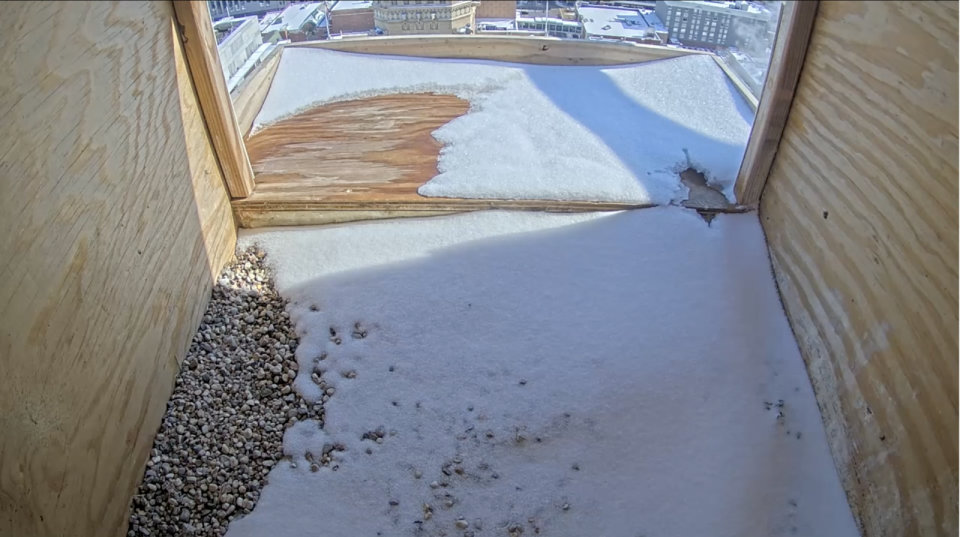
Check out the new camera angle for a second view. The new camera system will toggle back and forth between the two camera views about every 20 seconds.
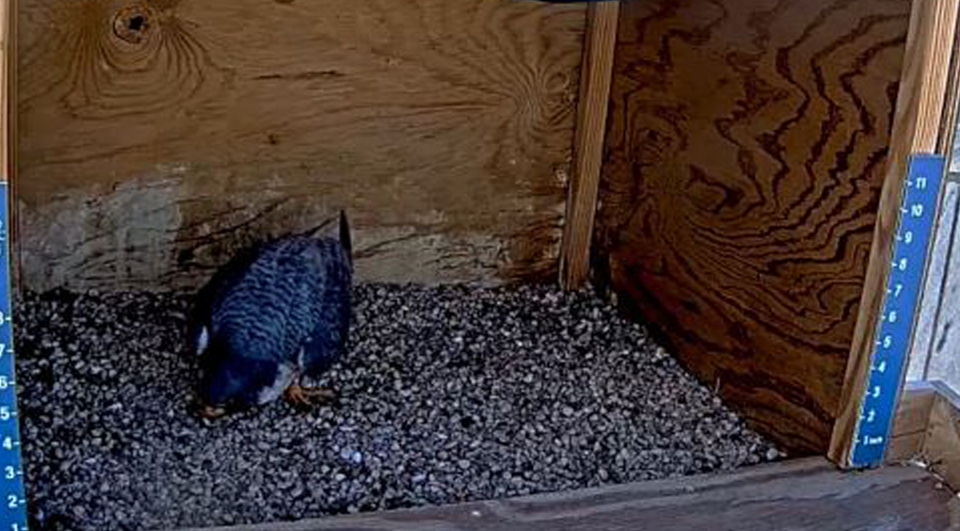
February 22, 2022 - Welcome back to the peregrine falcon nest box at Mayo Clinic and help us celebrate our 35th year of peregrine recovery!
Our new camera system gives you two different views into the box, along with audio of the falcons and their environment. One view is from the back of the nest box, looking outward towards the Plummer Building and the other view is from outside the nest box, looking inside.
It is still a little early to say with certainty which peregrine falcon pair will gain possession of the Mayo Clinic Nest Box in Rochester, MN., but so far Hattie and Orton, the resident pair here since 2016, have been successful in chasing away intruders such as Cooper’s Hawks, Red-tailed Hawks and other peregrines. In past years, we have observed as many as FIVE different female peregrines trying to claim the territory. This is one of the consequences of having such a robust and healthy peregrine population in Minnesota.
Because it is still very early in the nesting season, the peregrines aren’t spending much time at the nest box itself but are somewhere nearby. As we get closer to egg laying, both adults will be getting ready for the arrival of eggs by making a scrape in the gravel. This scrape is a depression or bowl, which helps keep the eggs together and in a secure spot for incubation. If Hattie and Orton continue to retain possession of the territory, we could have the first egg laid as early as mid-March. Orton was spotted on camera over the weekend, making such a scrape in the box and vocalizing to Hattie. This is very encouraging behavior, and we are hopeful for another successful nesting season on campus. For now, stay tuned and we will continue to share observations with everyone, as they happen.
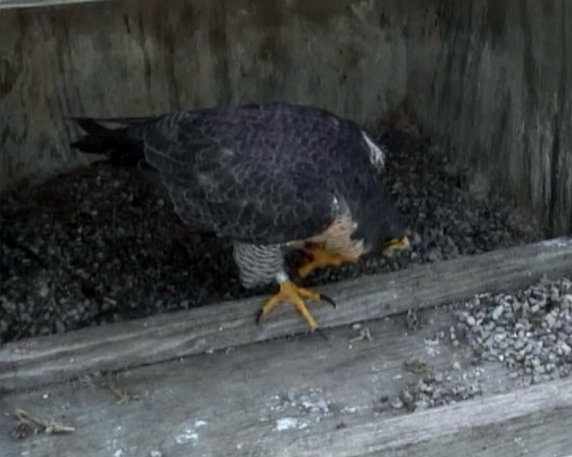
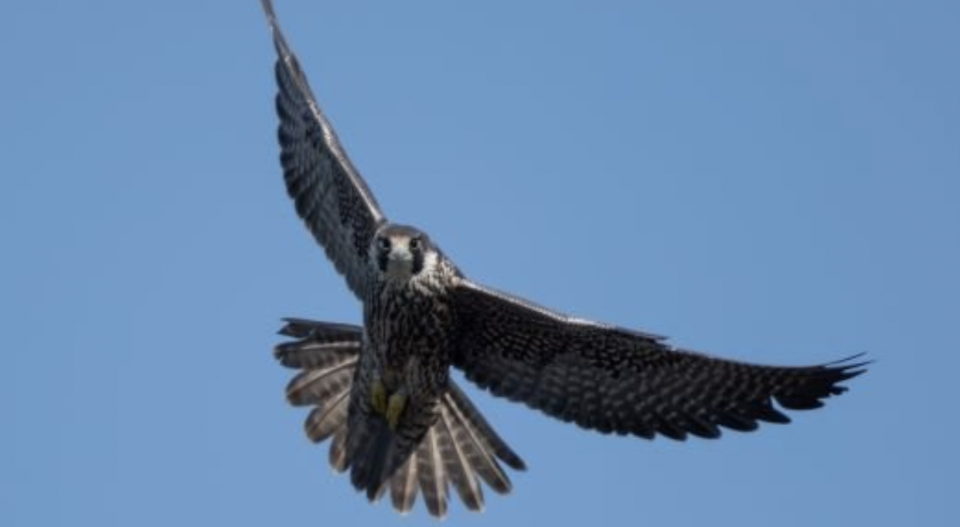
December 23 - When someone finds or photographs a banded bird, they can contact the US Geological Survey staff at the Bird Banding Lab to find out more information about that bird. The Banding Lab will send out a certificate of appreciation for your sighting, as well as any information on the bird you saw, such as banding date, location and age at banding. The Lab will also notify the bander of the location and condition of the bird which they banded, to help increase the knowledge of the research project they are working on. Most often, the news isn't good because mortality can be high for birds, especially juvenile birds. But thankfully, the news was good and a second fledgling from the 2021 brood has been found to be alive and doing well!
On November 21, Hailey was photographed by Andy Clawson. He saw her perched in a tree and watched her fly at the Clarence Cannon National Wildlife Refuge in Annada, MO. This refuge area is a little over an hour north of St. Louis, just west of the Mississippi River. The refuge is an important stop over spot for migratory birds, especially waterfowl and shorebirds, an important food source for peregrine falcons. This 3750-acre refuge is about 400 miles south of Mayo Clinic, a reasonable distance for a falcon to migrate during its first year.
Considering peregrine falcons have been known to migrate over 100 miles in a single day, it would have taken Hailey less than a week to find her way to this refuge. Although it isn't known whether she is still at the refuge today, it would make sense since the habitat is so rich with food, water, and shelter. Time will tell, and all we can do is wait for future reports of her whereabouts.
In the meantime, Hattie and Orton continue to do well in downtown Rochester and the neighboring area. Patients, visitors and staff continue to let us know they often find them perched on the east side of the Mayo, Gonda, or Siebens buildings as well as the nearby Broadway Plaza Hotel and Charter House. The new camera has been installed, so stay tuned to having an even better view into the nestbox in 2022, while we celebrate Mayo Clinic's 35th year of peregrine recovery. Happy holidays everyone!
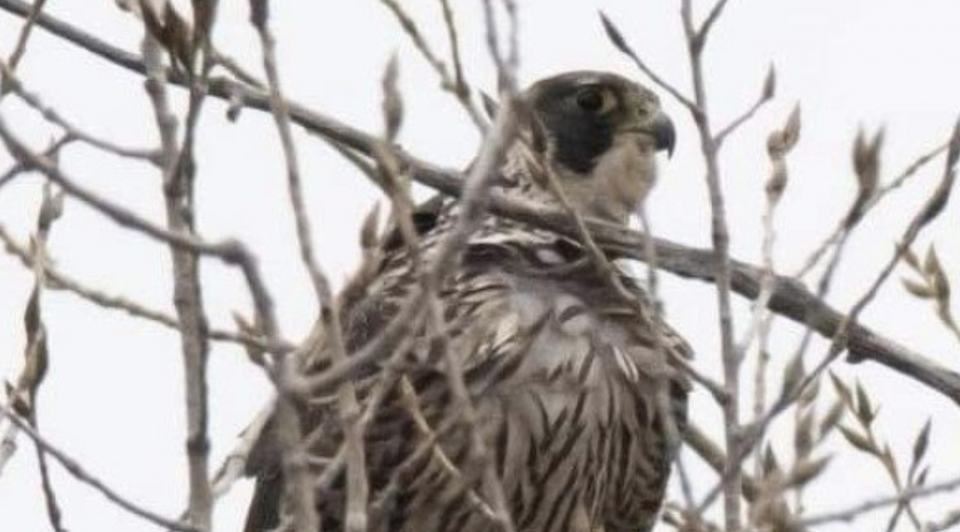
November 12 - The Mayo Clinic Peregrine Falcon Team received some very exciting news last night, when naturalist Jackie Fallon was sent a message about a young banded peregrine falcon. When she was able to look closely at the photo, she quickly verified that the immature peregrine was indeed Avalon, one of the fledglings from this season. Yipee!
Avalon's recent sighting was a relief to many, since it showed that she was obviously successful at catching her own food and staying away from dangers like great-horned owls, tall glass buildings, and other territorial peregrines in the area. Avalon traveled nearly 90 miles north to Vadnais Heights, MN, and appeared to be quite calm to the birders and photographers that spotted her. The photographer who shared the photo said she and others were very excited to see her perched so close. Avalon perched long enough for Brooke Roegge to take a photo that clearly showed the black and blue band on her left leg, before flying out of view along the trail.
This is a perfect example on why the banding team chooses to place the additional color band on the falcon chicks at banding time. Without this band, the photographer would have never been able to confirm the Avalon's identity and we would have continued to wonder about her whereabouts. Hopefully, she will continue to thrive and survive until a time when she can find a breeding territory of her own. Stay tuned!
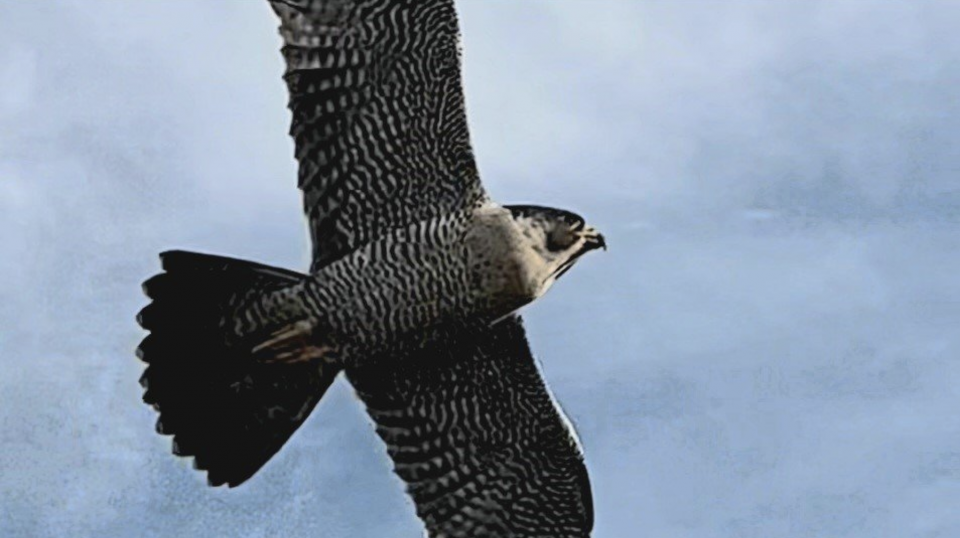
November 9 - The facilities staff at Mayo Clinic have been busy getting the falcon nest box area prepared for the 2022 nesting season. We like to do this type of work outside of the actual nesting season, so it is safer for both humans and the falcons when the hormone levels are lower. With the nice weather we had in Rochester this week, and the arrival of all of the new camera equipment, the facilities team decided that it was a perfect time to install the new system and clean the box at the same time. By doing the work now, we would be all ready to go for the 2022 nesting season.
Although the contract crew didn't have any problems while setting up the scaffolding near the nest box three weeks ago, the Mayo Clinic staff had a completely different experience today. Even though there were four staff members on the roof, Hattie was still very defensive. She was defensive enough to make sure that the humans realized that their presence wasn't welcome, and they should leave immediately. A falcon flying in a stoop is alarming for even an experienced biologist, and even more so when there are two birds flying and vocalizing at the same time. Thankfully, the crew were able to accomplish their task in record time, and safely make their way back into the safety of the Mayo Building. This is a perfect example of how wildlife is never predictable 100% of the time, and that you need to use caution whenever you are around them. After six seasons in Rochester, Hattie and Orton definitely consider Mayo their turf and visitors are NOT welcome, regardless of the time of year. (FYI, the photo below was taken by one of the team members via a cell phone, and not a DSLR camera with a zoom lens).
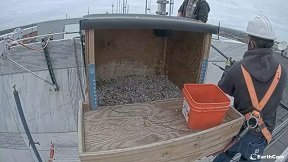
October 21 - Things have been quiet on the peregrine front, now that the 2021 fledglings have left on their migration travels. Hattie and Orton continue to be found most often perched on the Mayo Building, Gonda Building, and on occassion, the Guggenheim Building. As we've mentioned before, Hattie and Orton stay in Rochester, MN all year long. We really don't fully understand why some peregrines migrate and others don't but most likely this is due partly to their genetics.
Since the hormone levels of the falcons is lower this time of year, the falcons are not as defensive towards maintenance staff on the rooftops. This enables the facility staff to clean out the nest box, make repairs on the roof, and install the new camera in a much safer way. Here you see some of the contractors at the nest box a little over a week ago, and while the peregrines were flying nearby, they didn't feel the need to be very protective of the nest box without any eggs or chicks present.
You may also notice that we've turned the camera off until next year, and are showing a video we did several years ago about peregrine falcons and the role that Mayo Clinic has played for nearly 35 years. We are working on some exciting new things for the program's 35th Anniversary in 2022, which includes updating the video, adding many photos of peregrines, and further developing this website. We hope you enjoy the video and look for more updates soon!
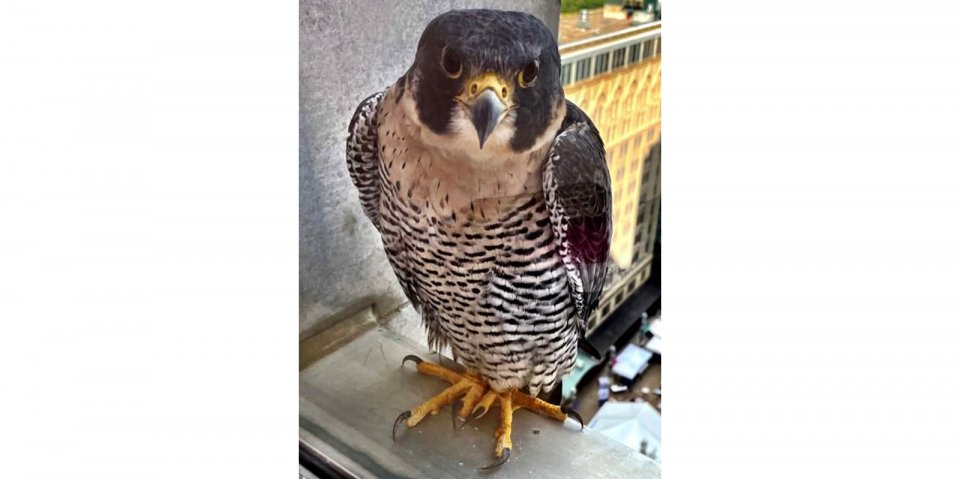
September 13 - We are approaching that time of year when the falcons are rarely observed in the nest box atop the Mayo Building in Rochester. Without the eggs to incubate or young chicks to feed and protect, the adult peregrines start spending more and more time away from the box itself and more time throughout the entire city landscape.
Last week, one of the staff members for the Oral Maxillofacial Surgery department on the 12th floor of the Gonda Building happened to glance towards the windows and noticed one of the adults perched just outside the window! He was able to go back to his desk and snap this wonderful picture of the female Hattie, who was apparently taking an afternoon break. Over the years, Hattie has often been photographed and observed up close by patients and staff at the Clinic, which is quite the special gift during a workday or patient visit. Although we can't say for certain what Hattie might be thinking when she peers back at the people on the other side of the glass, it's obvious she doesn't appear to be very concerned about our presence. At times, it even appears that she's curious about the faces peering back at her.
We want to thank Tim Shorter for sharing this special image of Hattie with all of us on the falcon team. We would love to see any other images anyone might have of our special falcon family. You can email them to us at Peregrines@mayo.edu
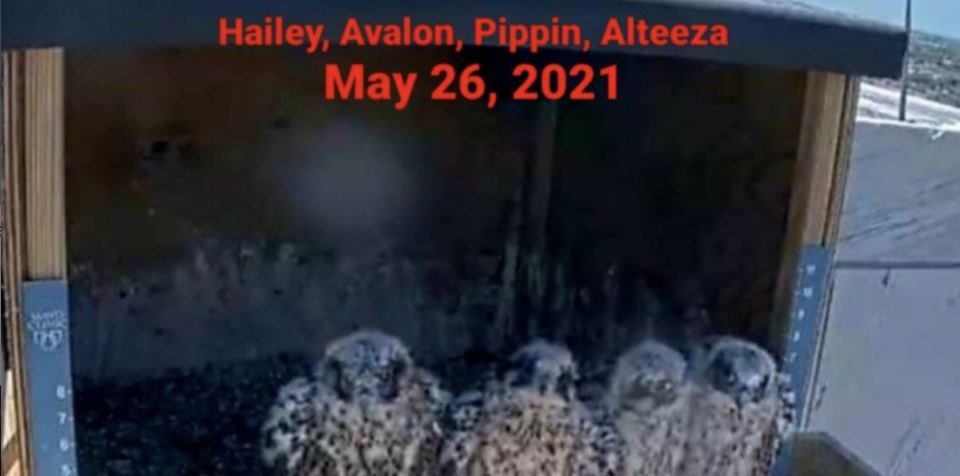
September 9 - The falcons at Mayo Clinic are living up to their name "Wanderer" this month. The field team haven't observed any of the 2021 fledglings in the city since the 24th of August. Not to worry, this is the typical time of the year when Mayo's immature peregrines start their movements outside their natal territory. The adults Hattie and Orton are even found to be exploring the outer edges of the Rochester city. Over the past week they've been sighted from the northwest section of the city by the IBM campus to the south near the Willow Creek Country Club. This may seem like quite a distance to travel, but most peregrines will wander 10 miles or more from their nesting location duirng the non-breeding season.
Because the falcons are rarely found spending time in the nestbox now, we will be turning the camera off soon. We've had a great 2021 season and want to re-share one of our favorite images from this year's nesting season. Remember, keep your eyes to the skies...the 35th Year of Mayo Peregrines will be here before you know it!
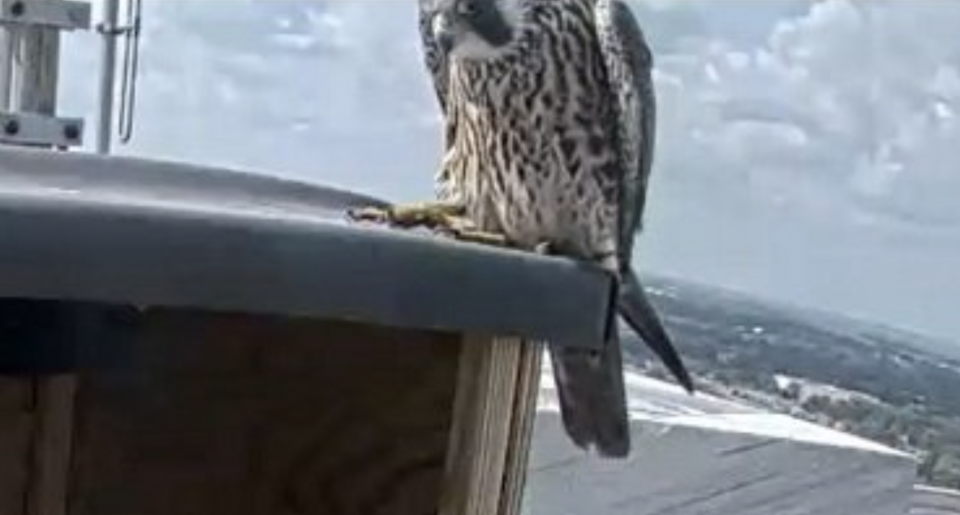
August 25 - Jackie Fallon of the Midwest Peregrine Society continues to closely monitor the nest box video and conducts weekly in-person field observations in downtown Rochester, in hopes of determining the current status of Avalon's injuries. Avalon continues to favor the right leg, but still appears to have strong flights and appears to be bright and alert. The adults are observed spending time with Avalon on top of nearby buildings as well as the clinic campus itself. The image below is from yesterday afternoon, with her looking at "something" below her, showing how curious fledglings are.
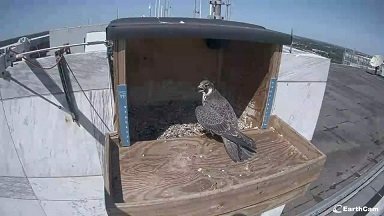
August 13 - The Midwest Peregrine Society field team has been monitoring our nestbox site daily since it was first discovered that Avalon, one of this year's fledglings, appeared to be injured on August 9th. Although the adults Hattie and Orton have been found daily in the vicinity of the nest box or nearby area, Avalon has not seen until this morning. At about 11:19 am Avalon brought in a small bird to the nest box, but did not start eating nearly seven hours later in the afternoon. It also appears from reviewing the video tape that she is using the right leg and foot slightly more than she did on Monday. Both of these things are slightly incouraging, especially that she waited so long before eating. Avalon continues to look bright and alert, and we are continuing to evaluate how to best proceed with any potential intervention. We want to thank everyone for sharing our concerns about her welfare, and understanding that capturing her for any medical treatment is extremely difficult at this time.
The other three fledglings Hailey, Pippin, and Alteeza have not been observed in the downtown Rochester area since late July, and most likely have dispersed their natal territory, beginning the next step in their journey of independance from the adults.
The photo of Avalon from this afternoon, standing in the nest box.
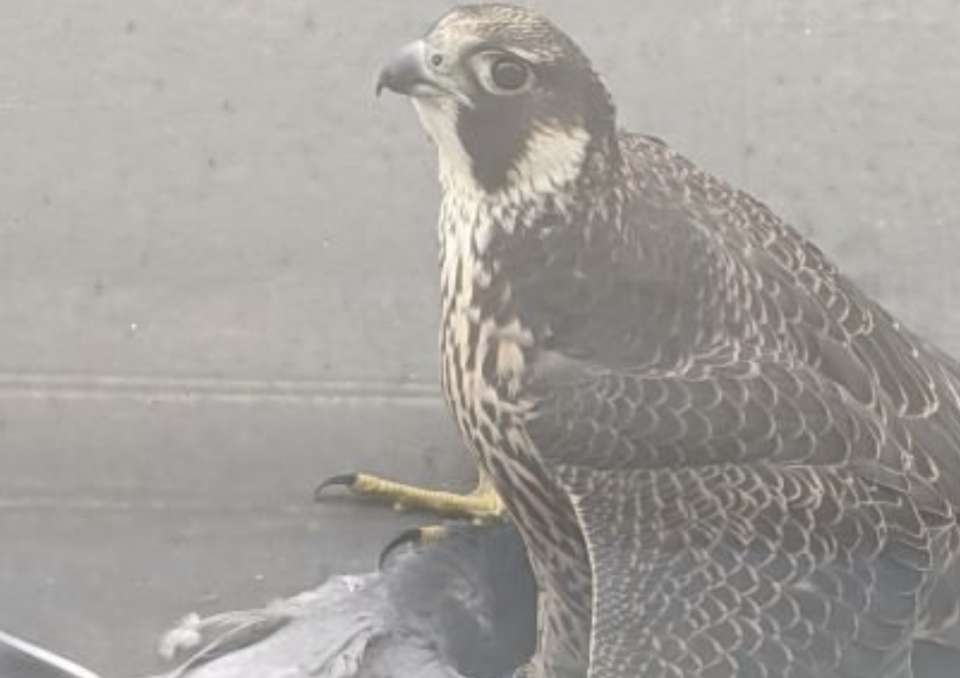
July 22 - Recently a member of the falcon community sent us this image of Avalon, one of the female fledglings from the 2021 brood. It appears that Avalon was in pursuit of her dinner (i.e., pigeon), the most common prey item of urban peregrine falcons. As what often happens, the pigeon unfortunately collided with a building, with Avalon right behind it. Although the pigeon did not survive the collision, Avalon was able to get a full meal and gain further experience in hunting for herself, which will hopefully mean success in her future.
We would like to thank John Giesen for sharing the photo below with us.
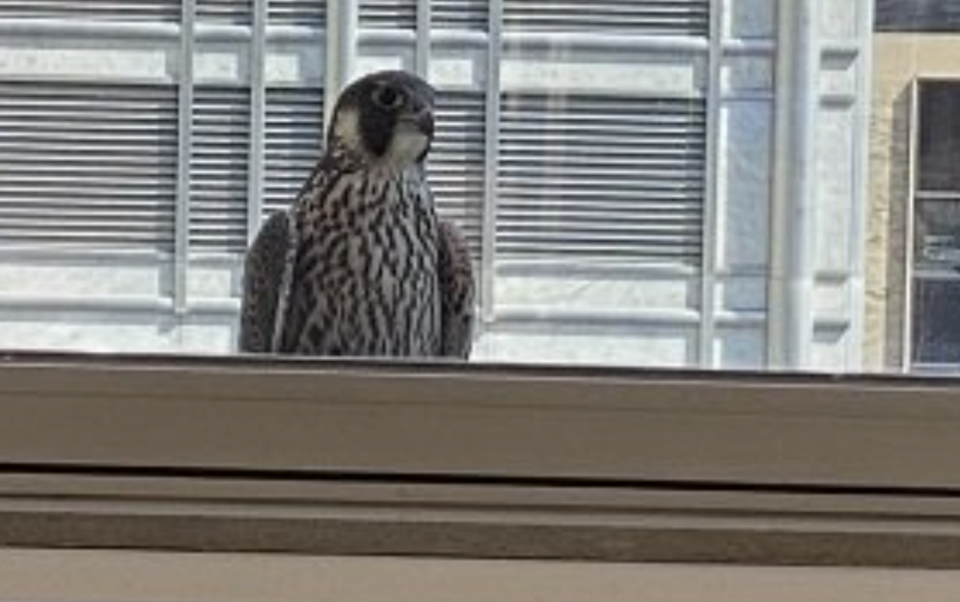
July 13 - Nearly every day, three of the four fledglings continue to be seen with the adult parents, Hattie and Orton. However, since they are ranging farther and farther from the Mayo Building and nestbox, it can be difficult to tell which bird is which, other than identifying them as a male or female. The fledglings have now been "on the wing" for over five weeks and are continuing to gain skills with hunting and flight. We have even had reports of one of them catching a pigeon by itself! The fledglings will start to leave the downtown Rochester area by the end of July, and begin the next stage of independence and migrate to other parts of the Upper Midwest. We wish them good luck and hope to see them nesting in their own territory soon.
Thanks to Bryan Anderson for sharing this photo with us from his office window on Mayo 11. We can tell this is one of the females from her coloration and size, but unfortunately without seeing her left band, we can't say for certain whether it is Hailey or Avalon.
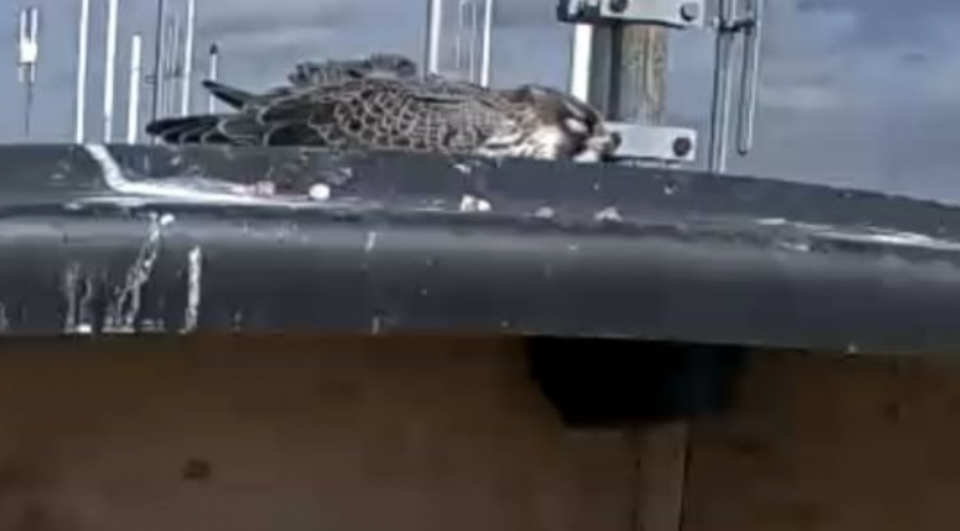
June 25 - The four fledglings continue to do well, exploring the downtown Rochester area and nearby buildings. It has now been three weeks since the first chick fledged, and they all appear to be making strides in gaining hunting skills and having "mock battles" with each other. Here you see the largest female, Hailey, resting on top of the box before taking flight again. It can be quite exhausting for these young birds performing all of their aerial antics, so they often rest flat in the shade or another safe haven.
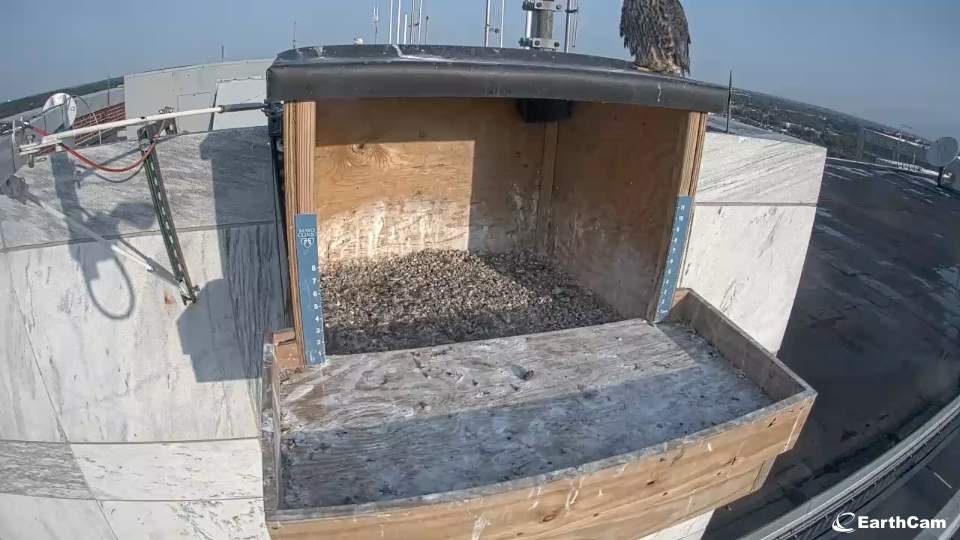
June 17 - As of this morning we were able to see that the adults, Hattie and Orton, and three of the four fledglings were flying high above the downtown Rochester campus. The fledglings are now becoming more adept with their flight skills, chasing each other and their parents and making attempts at catching their first prey. It will still be several weeks before the fledglings will be successful in catching their own meals but the adults are always nearby, watching and providing food for them. The best time to see them on camera is early morning and later afternoon when they roost for the night near or in the nest box. Here you can see one of the fledglings on top of the nest box early this morning.
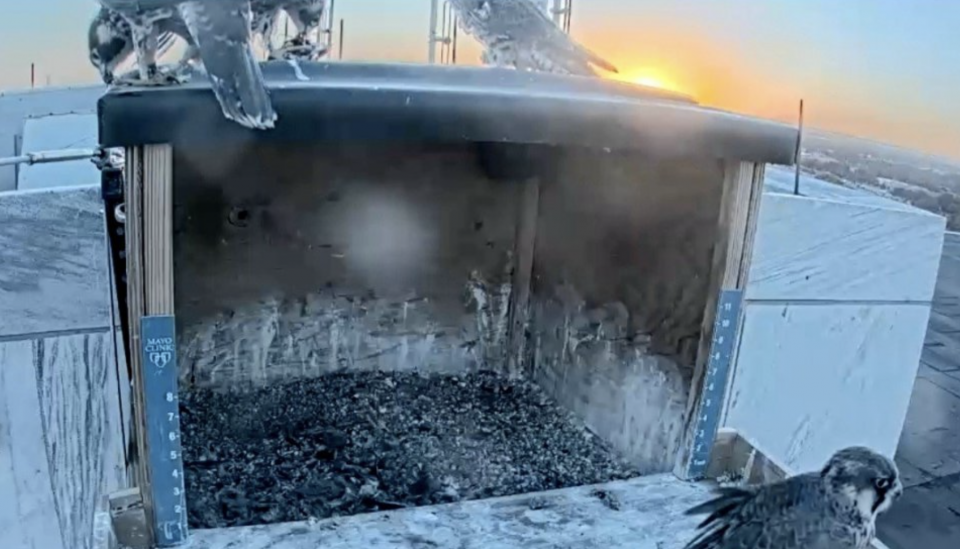
June 14 - All four fledges were back at the nest box last evening, as seen in this photo taken at 8:49 p.m. The fledges typically have left the nest box by sunrise each day. Pippin and Hailey spend the most time roosting at night in the box, where they feel safe.
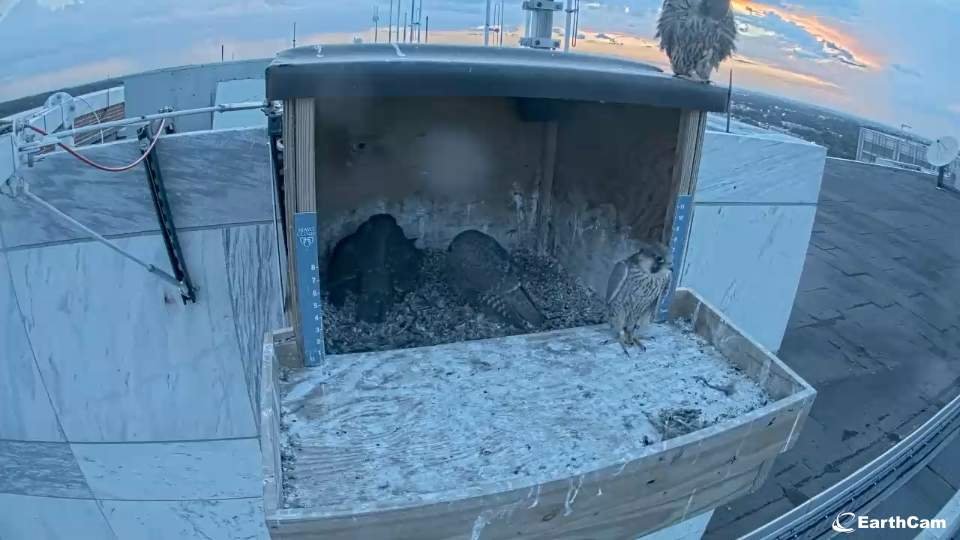
June 9 - This photo was taken at 9 p.m. and shows all four the fledgings doing fine -- three in the box and one on the top, enjoying the view!
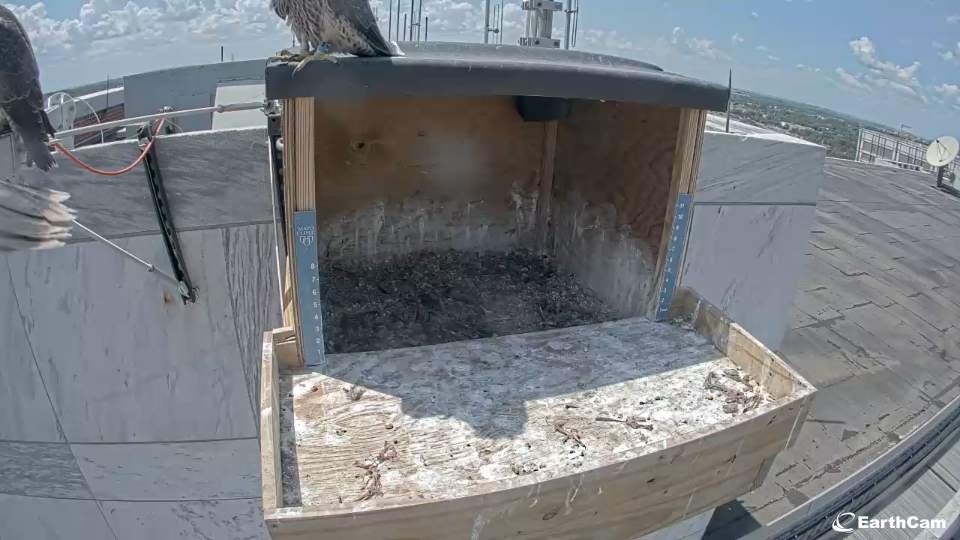
June 8 - As you can see from this photo, even though the chicks have fledged, they are still quite near the nest box. Notice the birds on the far left.
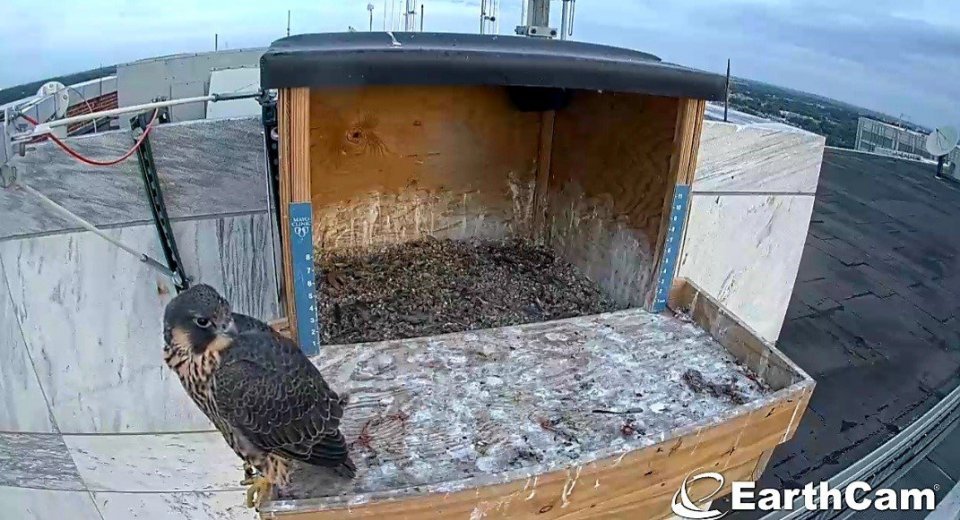
June 8 - Hailey fledged early this morning, before 5:30 a.m., leaving Avalon as the only occupant of the nest box (see photo). Avalon followed suit and fledged shortly after 7:30 a.m. If you look closely at the second photo, you'll see one of the fledglings on the roof of the nest box. It's very likely that Hailey and Avalon are staying close by, at least for a while.
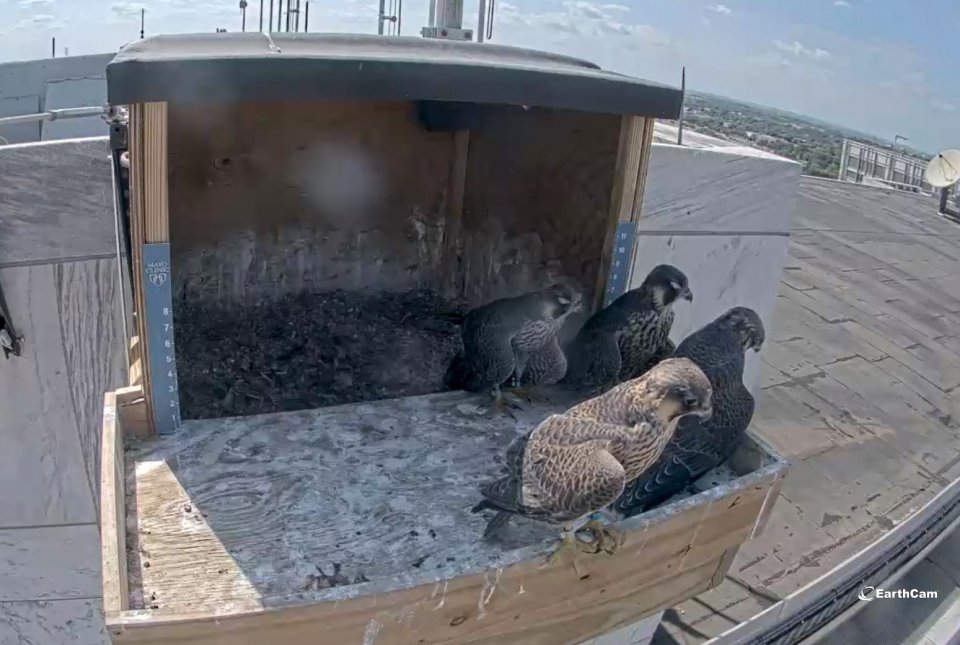
June 7 - All four chicks are back in the nest box (as of 4 p.m.) Do you think the chicks are all looking at the same thing? It could be that they are looking at one of their parents, some prey, or a butterfly or another insect. Everything is interesting to them at this stage.
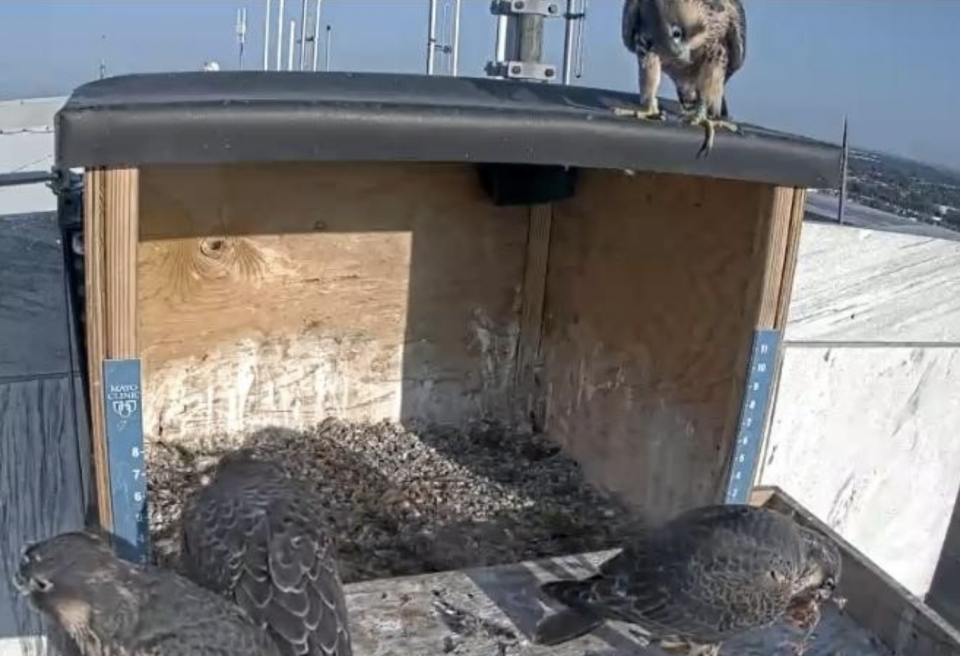
June 7 - All four of the chicks are doing well. This photo, taken about 7 a.m., shows Pippin on the roof of the nest box, while Altezza, Hailey and Avalon spend time on the deck. The females have not yet attempted to fledge.

June 7 - All four of the chicks are doing well. This photo, taken about 7 a.m., shows Pippin on the roof of the nest box, while Altezza, Hailey and Avalon spend time on the deck. The females have not yet attempted to fledge.
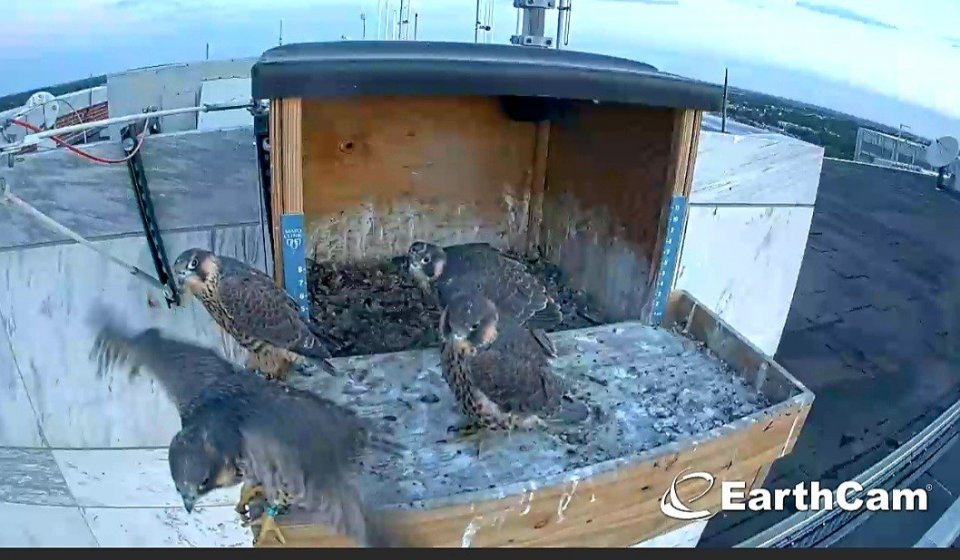
June 4 - We have fledge! Altezza, one of the male chicks, fledged at 5:22 a.m. today (see below), followed soon after by the other male, Pippin. The birds are probably very near the nest box; in fact, you may see one or both perched on one of the structures behind the box. The female chicks, Hailey and Avalon, remain in the nest box but could fledge any day.
Some viewers are concerned about the change in feeding habits observed recently. Orton and Hattie have continued to bring food to the nest box but now just drop it for the chicks to tussle over and consume. This is a natural and important part of what the chicks need to learn; they no longer need to be fed directly by the adults. Raptors, like these peregrine falcons, consume much of the water they need through the food they eat. The chicks have been well-fed since hatch, so they are well-hydated, too.
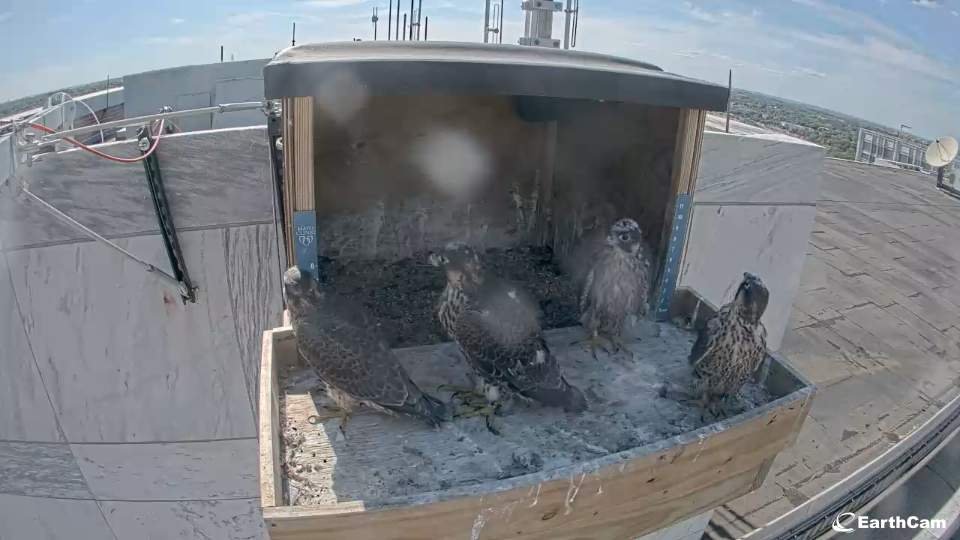
June 1 - Look how the chicks have grown and changed in appearance in just a few days. Here they are shown on the deck of the nest box, scanning the sky and waiting to be fed. They have only a few tufts of their white downy feathers still visible. The temperatures will be reaching the upper 80s and 90s in Rochester as the week continues, so you may see the chicks doing more open mouth breathing. We know this is concerning to see but they are actually doing well. The chicks can also retreat to the shade of the box if they get too warm. This is another reason why nest boxes are never facing west; we don't want the birds to get excessive sun without a place to retreat to.
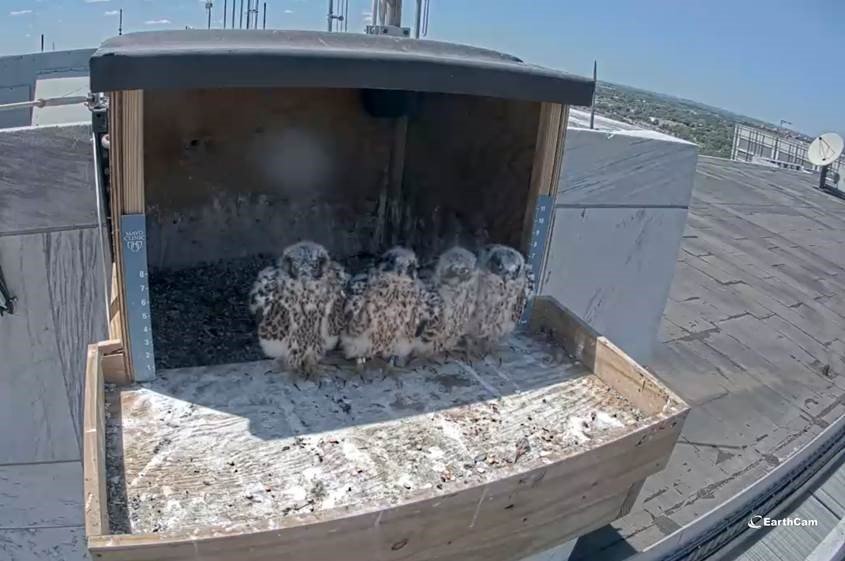
May 26 - All lined up and ready for their photo op! Photo taken around 2 p.m. CDT.
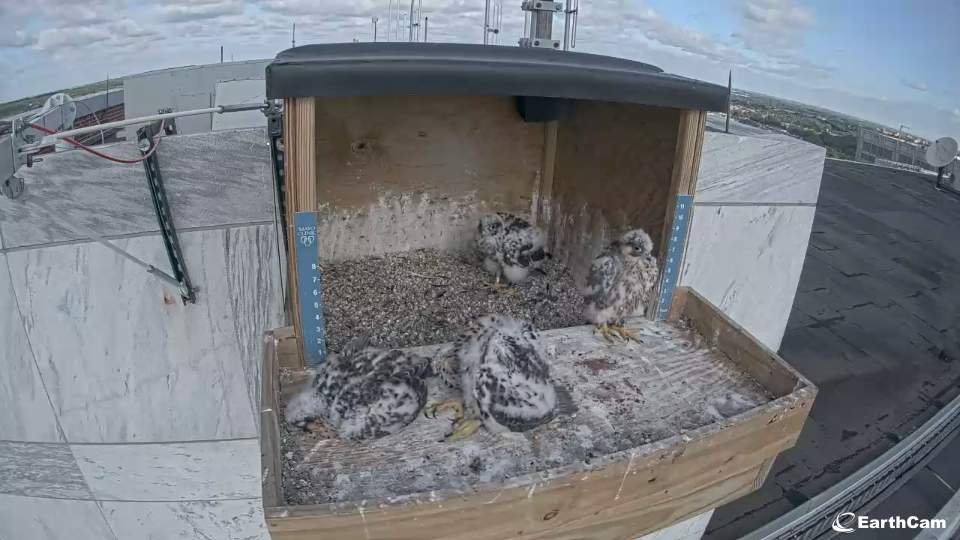
May 26 - These four chicks are getting bigger and bolder, spending more and more time on the nest box deck and even flapping their wings. They are now nearly 50% brown in color as their downy fluff gives way to feathers.
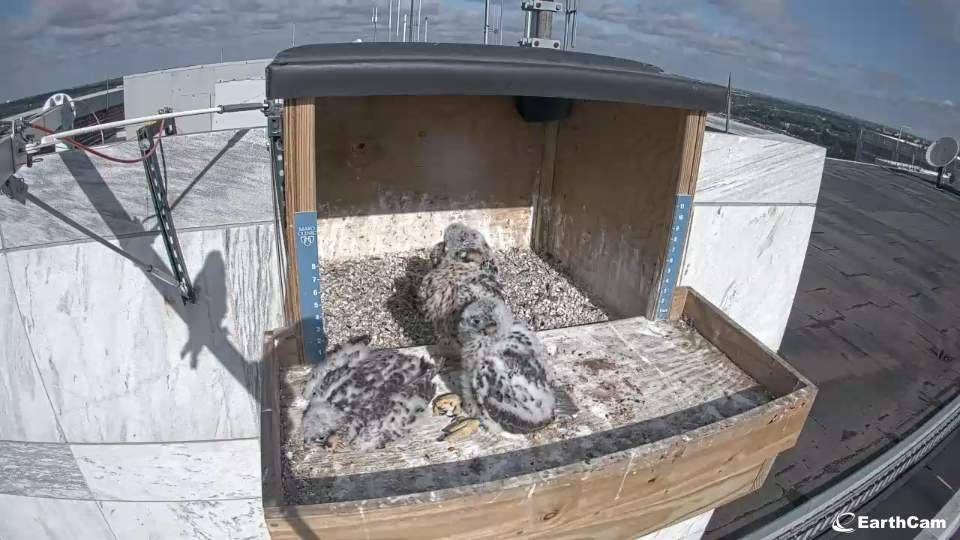
This photo offers a better look at the brown color of the feathers. Notice the shadow of an adult peregrine on the left side.
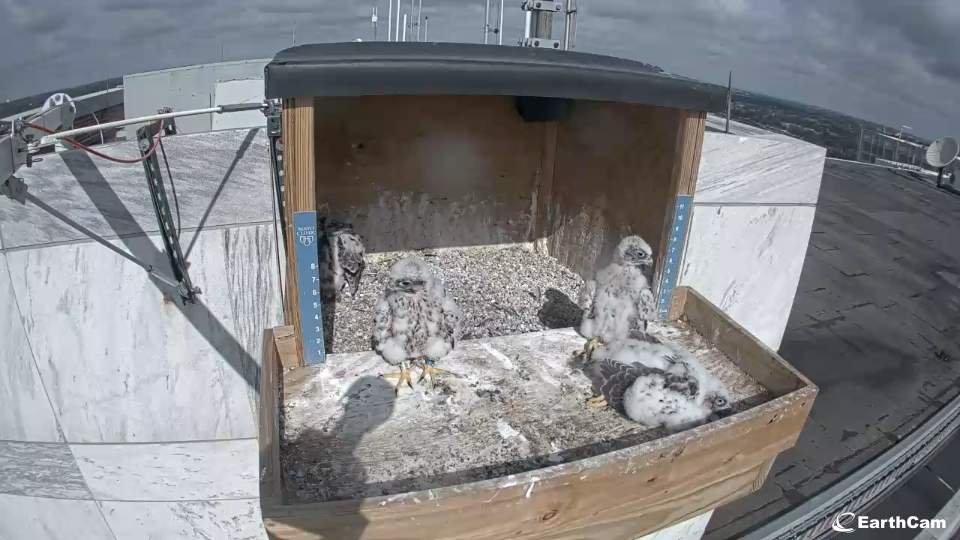
May 24 - It's one week post-banding, and the four chicks continue to grow and change in appearance. They are also venturing out on the deck of the nest box, becoming more curious about the world beyond their immediate surroundings.
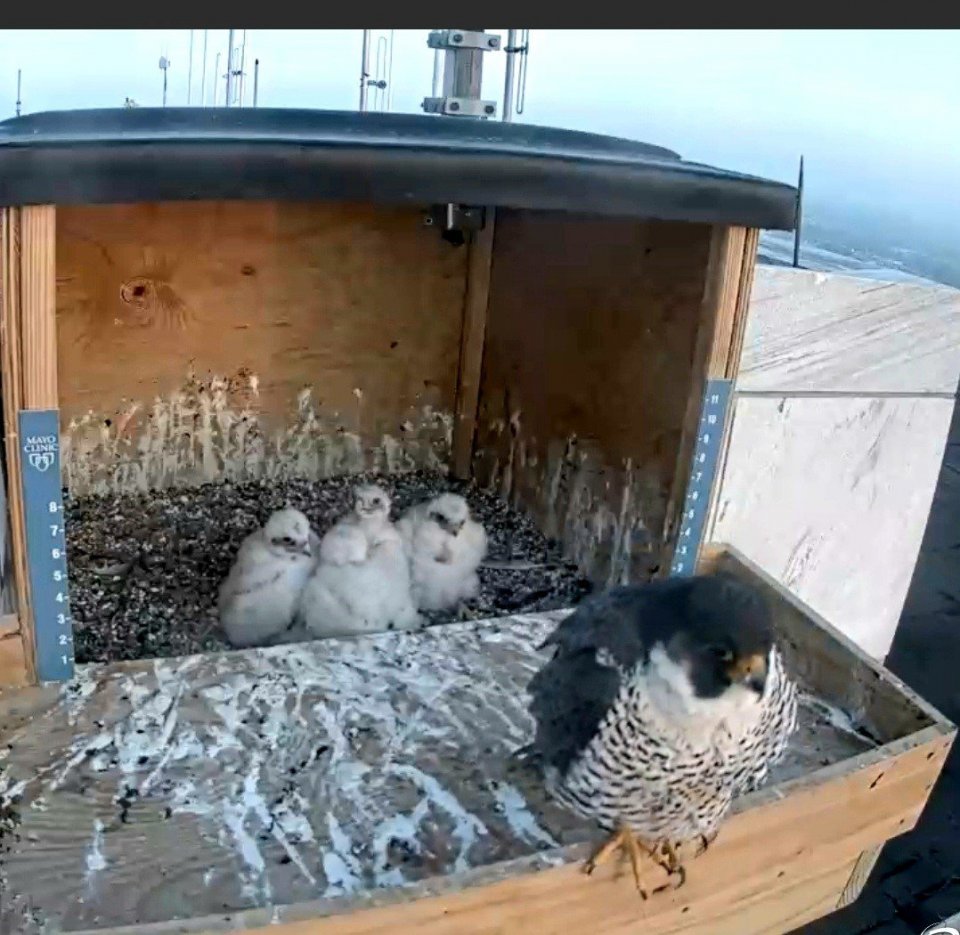
May 17 - It was an eventful morning for the peregrine falcon family at Mayo Clinic in Rochester.
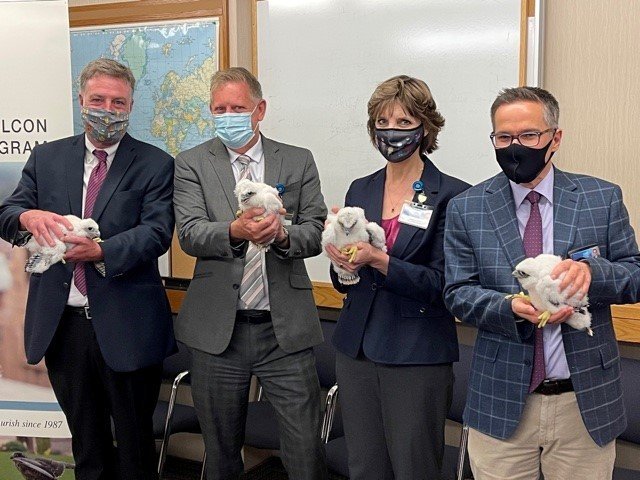
At around 10 a.m., the four chicks were removed from the nest box atop the Mayo Building and carried to a conference room for a physical exam, banding and naming. Jackie Fallon, Midwest Peregrine Society, banded the chicks and stated that all four are healthy and doing well. Names for the chicks were drawn from more than 800 submitted, and we're pleased to announce their names: females Hailey and Avalon; males Altezza and Pippin.
Each chick received a federal band on its right leg and a colored identification band on its left leg. The colored bands are more easily read than the federal bands so they are most helpful when trying to identify birds at a distance. The banding information for the four chicks is as follows: Hailey (female) - black over blue, band 23/X; Altezza (male) - black over blue, band 77/D; Avalon (female) - black over blue, band 24/X; Pippin (male) - black over blue, band 78/D. This information will be entered into the Midwest Peregrine Society database along with the chicks' names, banding date and other documentation.
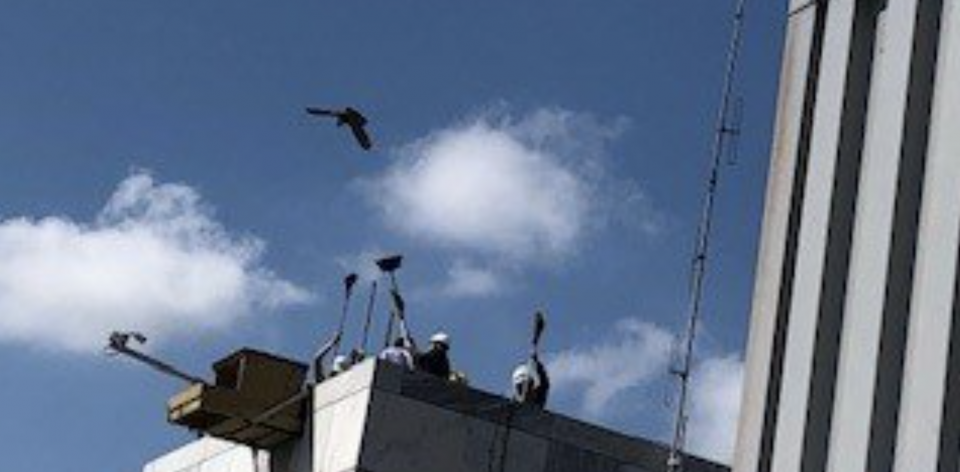
Hattie and Orton aggressively defended the area near the nest box (below) as the chicks were removed and later returned. Team members with brooms protected the others from possible attack by the determined parents.
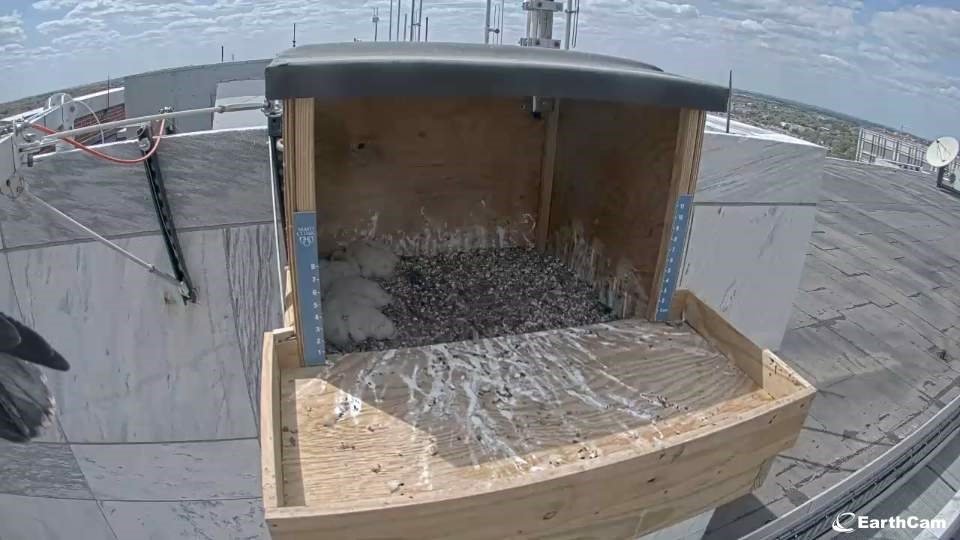
May 13 - This photo shows how, even when we can't see the adults on camera, at least one of them is usually nearby. Do you see the feathers of the adult on the left side of the photo? The adult is perched on the arm of the camera, keeping an eye on the youngsters in the nest box.

May 10 - One week away from our banding/naming event for these four fast-growing youngsters! We hope you can tune in on May 17 at 10 a.m. CDT via Facebook Live. We will also post a recording of the event on this site later that day.
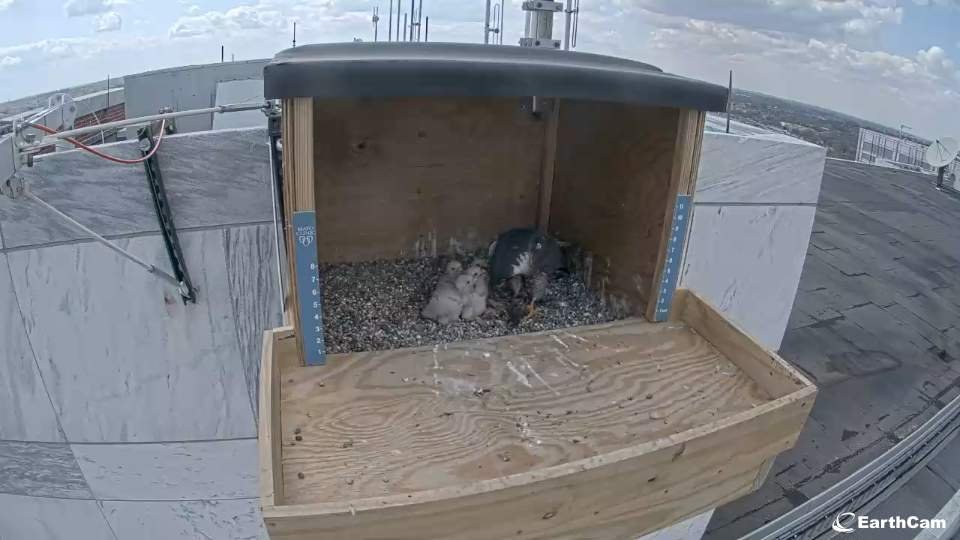
May 6 - Four hungry chicks at feeding time, 3 p.m. CDT.
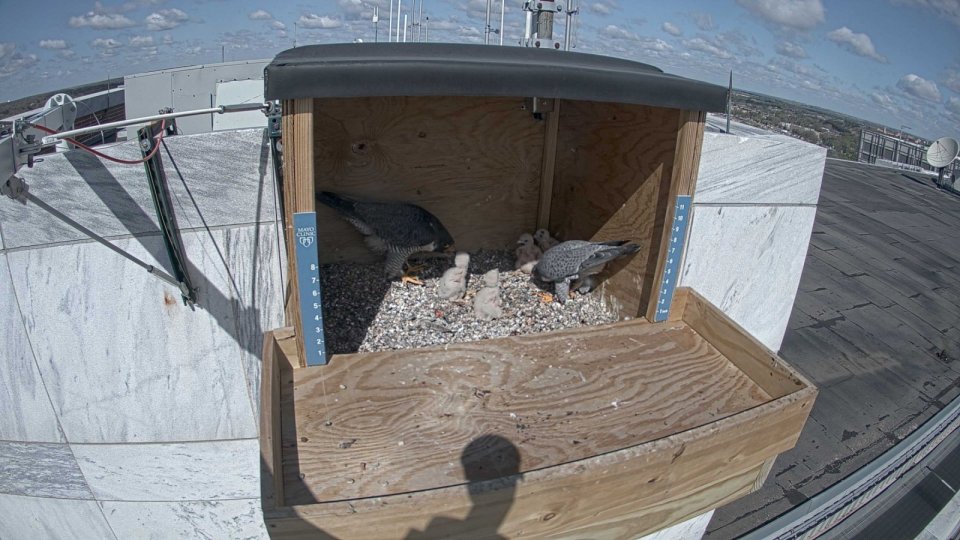
May 4 - Here's our falcon family, at 10:07 a.m. CDT.
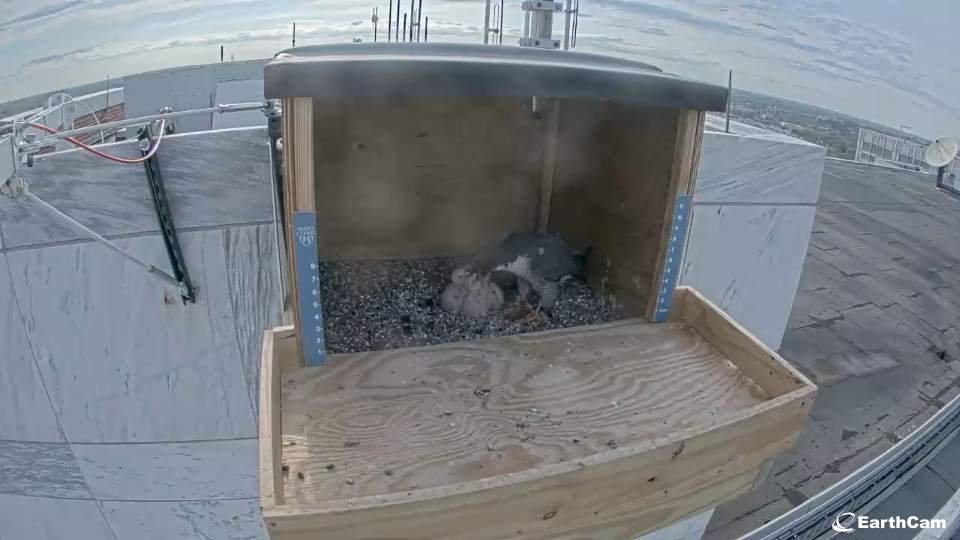
May 3 - Feeding time at 5:45 p.m. CDT!
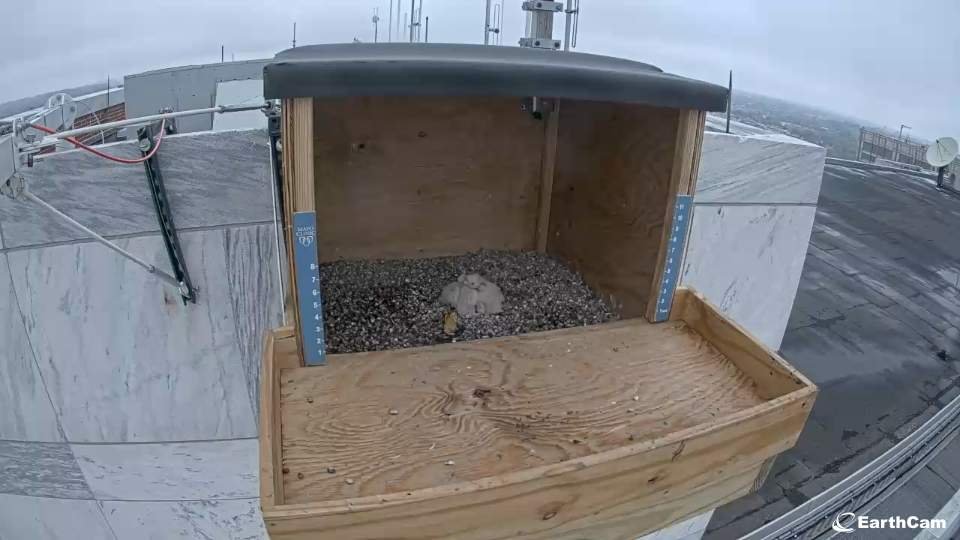
May 3 - Taken at 9 a.m. CDT, this photo shows the four chicks huddled near the middle of the nest box. The outdoor temperature is 55 degrees.
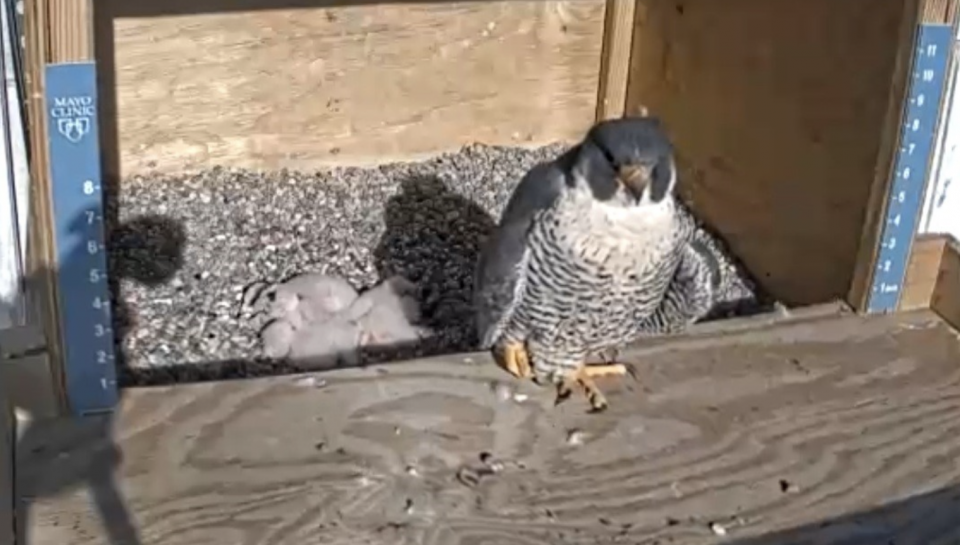
May 3 - This photo, taken on May 1, shows a black "mark" on the head of one of the chicks. Later observations showed that another chick has a similar mark. We're not certain what this is; it may be some debris. However, all four chicks appear to be doing well, and the last-hatched chick is catching up to its siblings in growth.
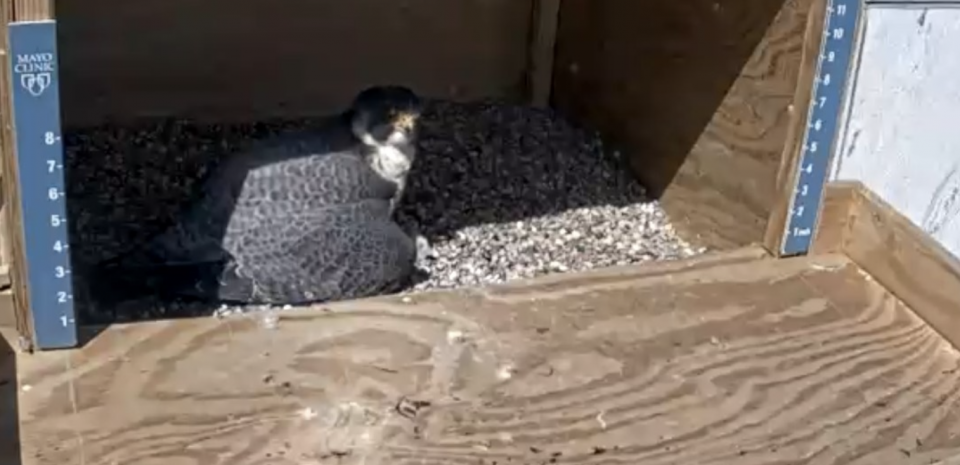
April 30 - In the first photo below, taken this morning, Hatttie is shading the chicks from the sun's heat. Even though the temperature is only in the 50s, the direct sun is warm and the chicks can't thermoregulate at this stage, so the adults do it for them.
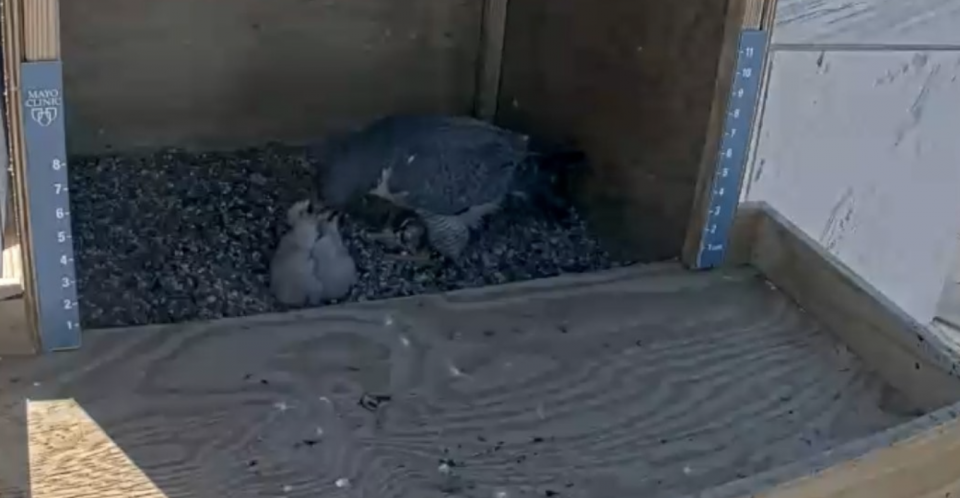
This photo of feeding time today shows how quickly the chicks are growing. They are now double their hatch size!
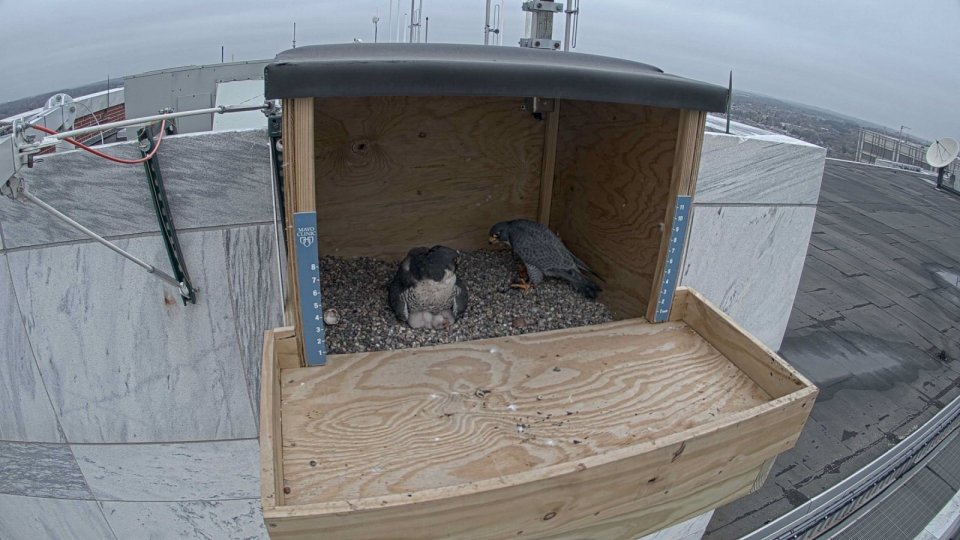
April 28 - Fun family photo of Orton (toward the back) and Hattie, brooding the chicks.
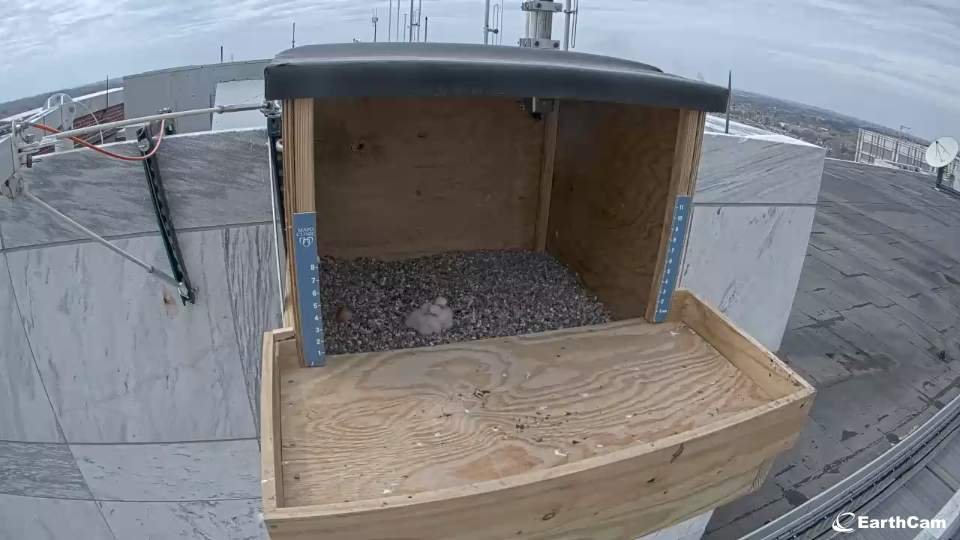
April 27 - 2:15 p.m. - This photo shows the four chicks huddled toward the front of the nest box. The temperature is 53 degrees so they are comfortable for a few minutes on their own. Moments later, Hattie returned.
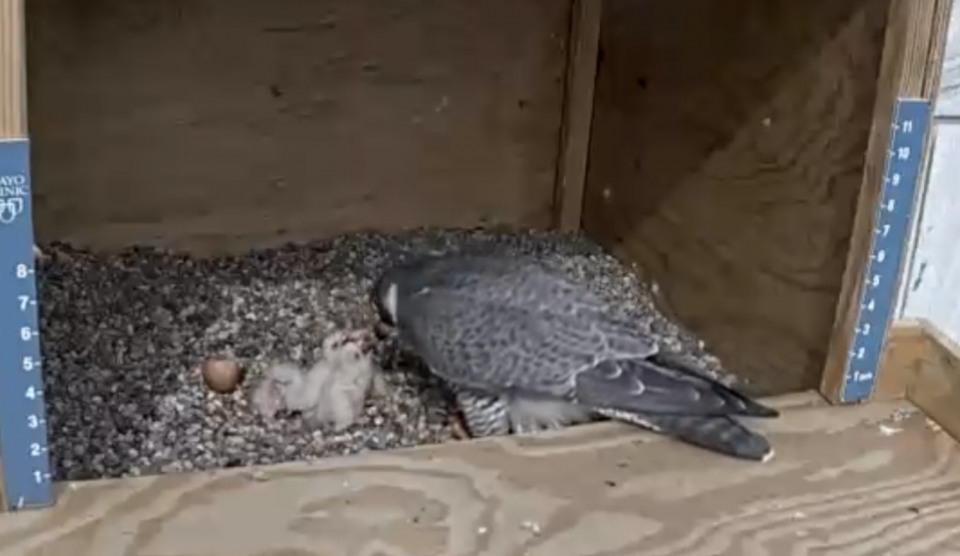
April 27 - The fourth egg hatched this morning, sometime between 6:40 and 9:00 a.m. The first photo below shows today's 10 a.m. feeding, with the newest arrival on the far left, behind its siblings, and the egg shell remaining nearby.
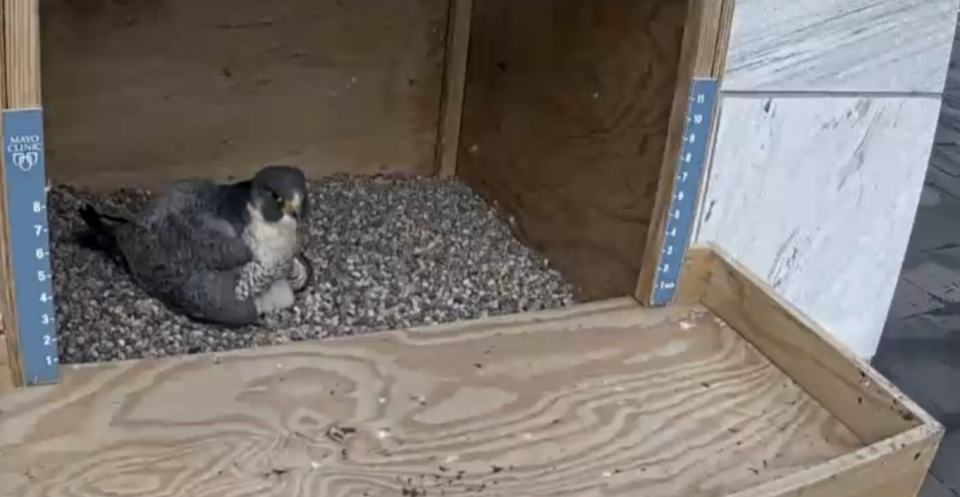
The photo shows Hattie brooding all four chicks. The new arrivals will be brooded by the adults and fed every 2-3 hours. The chicks cannot stay warm on their own for another few days, depending on the weather. Don't be alarmed if the parents aren't covering their chicks for a minute or two when the weather cooperates. What happens to the eggshells? Hattie and Orton will remove them from the nest box.
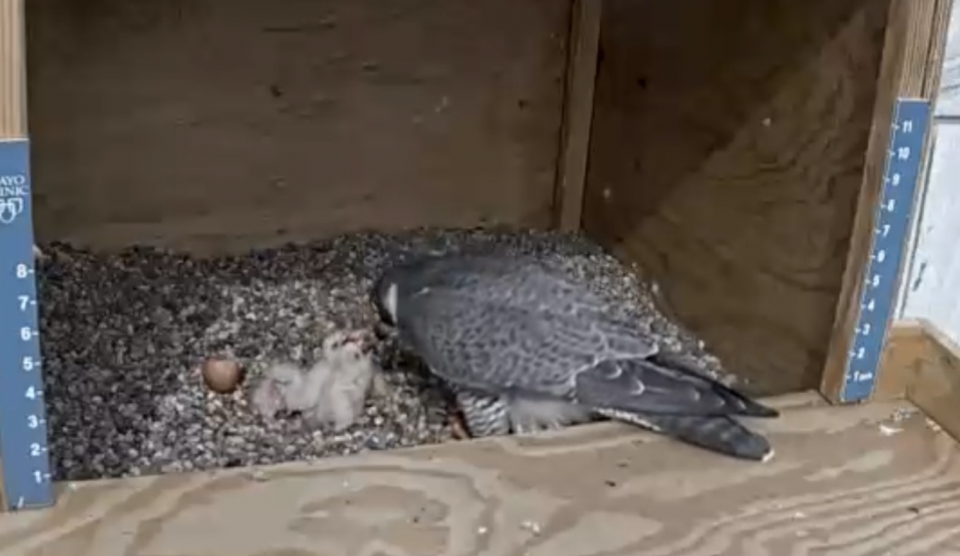
April 26 - Three of the chicks hatched yesterday. As of 7:00 a.m. today, one egg remains and should hatch sometime today. Orton is doing a great job of delivering prey to the nest box for Hattie to feed the chicks. Both adults are brooding the chicks in between feedings.
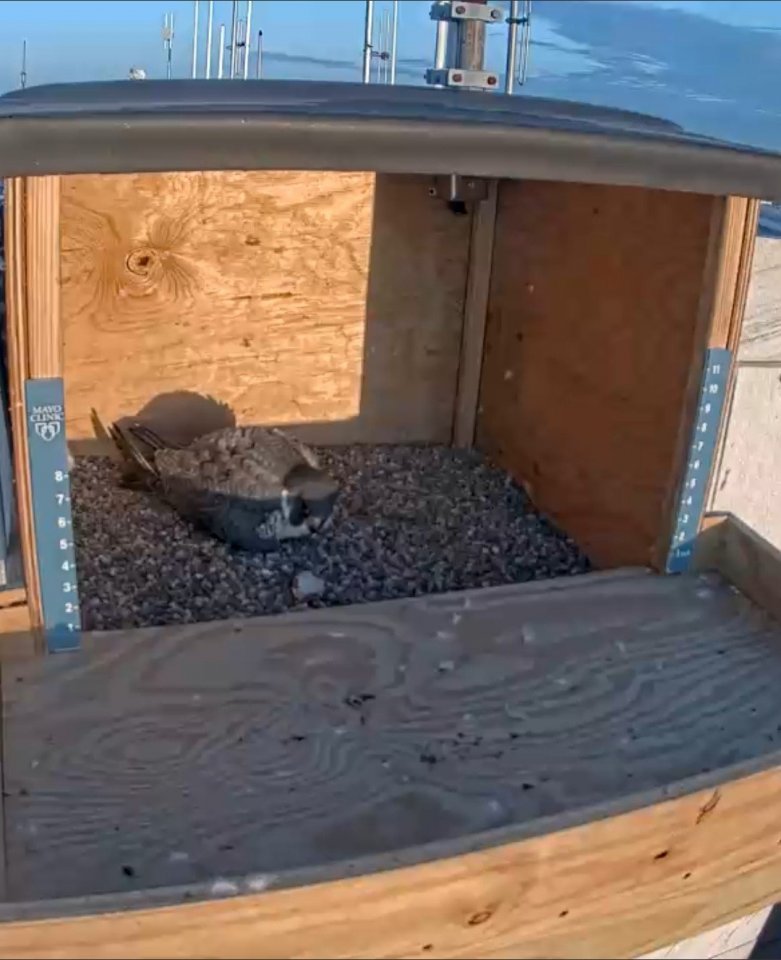
April 25 - We have hatch! As of 6 a.m., one of the chicks had fully hatched and two were pipping (broken a small hole in its shell) and those two should hatch sometime today. In the photo, you can see a piece of an egg shell toward the front of the nest box.
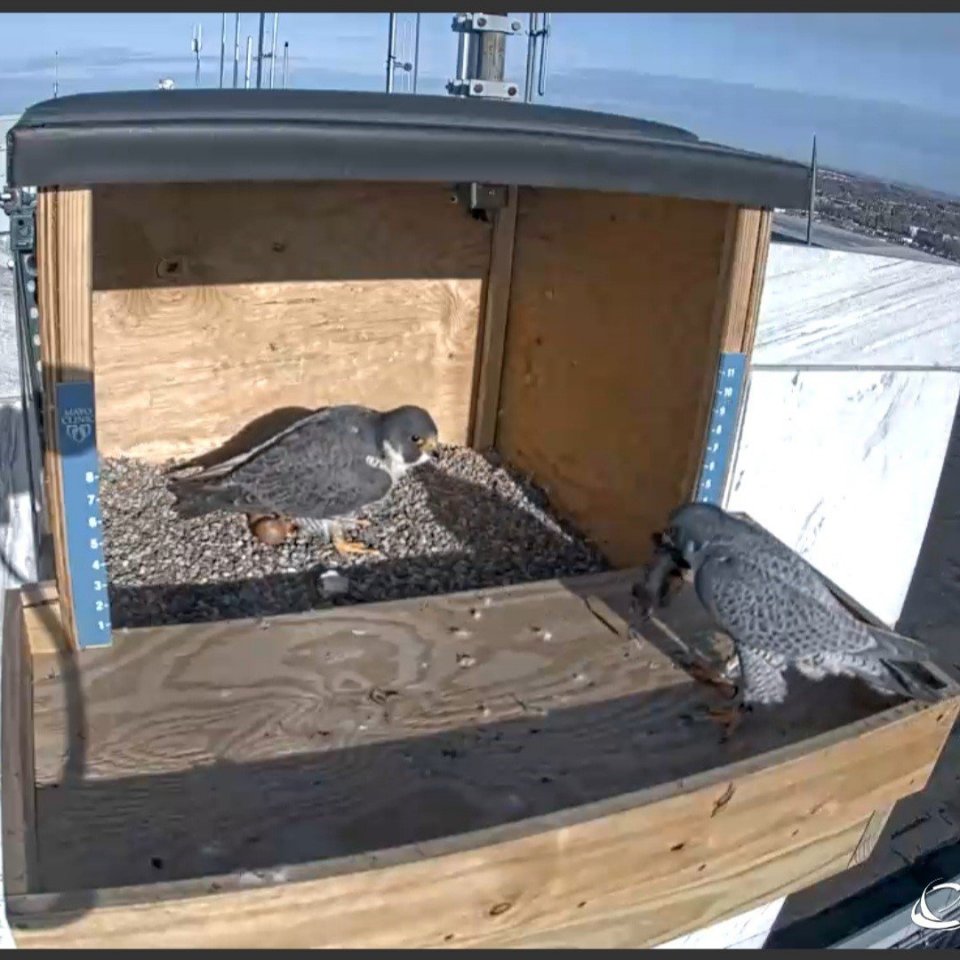
The first photo below shows Orton bringing food to the nest box. It is now his job to bring sufficient food to the nest box, and Hattie's job to feed the chicks.
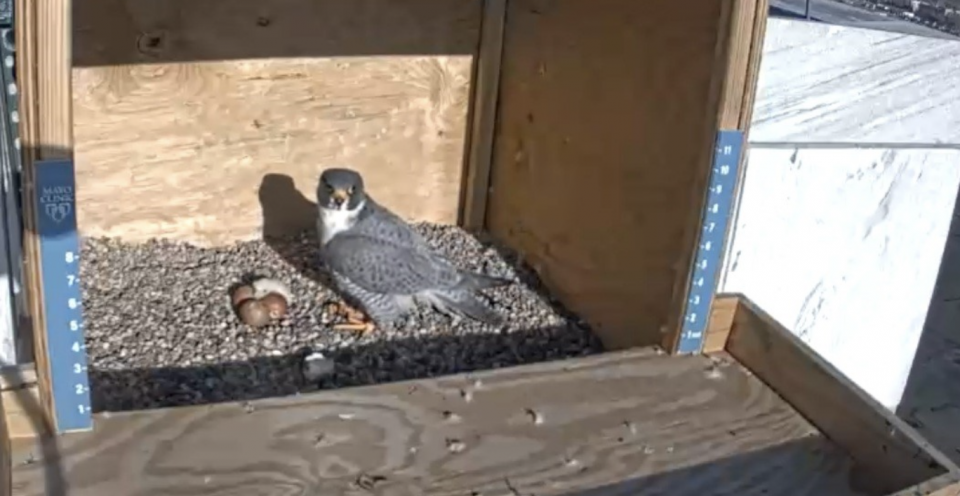
In this photo you can clearly see the eggs pipping - the first breaks in the shell as the chicks begin to hatch - and the first chick that has already emerged. Note the broken piece of egg shell moved toward the front of the box.
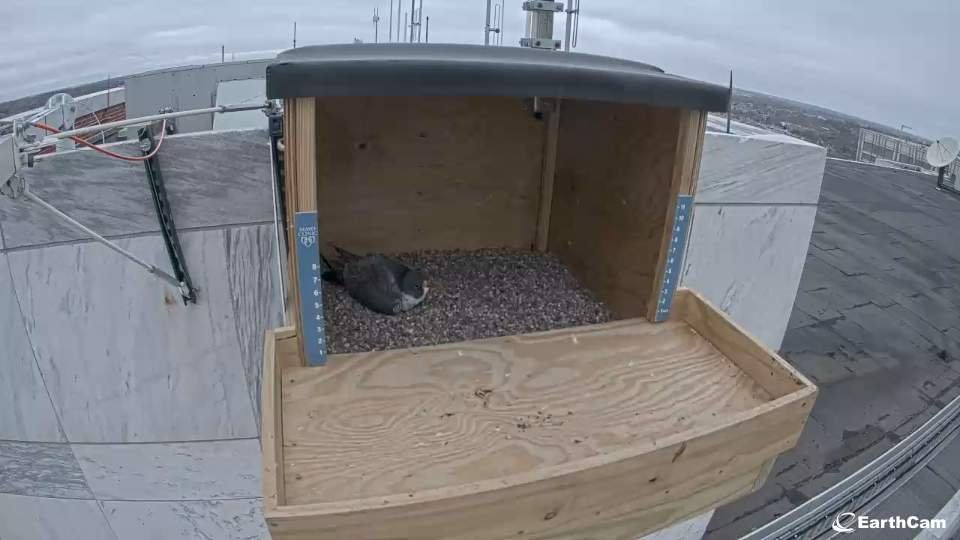
April 14 - The weather in Rochester has been chilly this week. The temperature at 11:30 a.m. is only 33 degrees. But Hattie and Orton faithfully continue to incubate their four eggs. We anticipate hatch to begin around April 26-27.

April 8 - The photo below, taken at about 7:30 a.m., shows Orton taking his turn incubating the egg, making sure to delicately turn them with his beak.
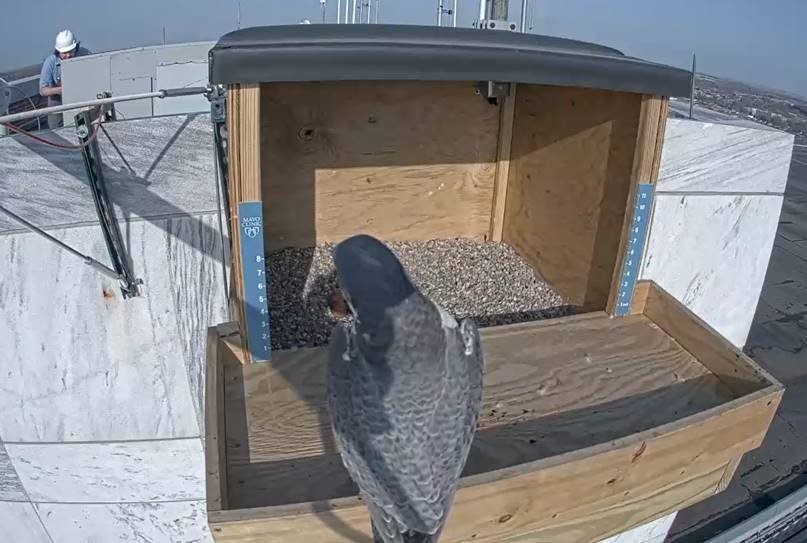
April 6 - Viewers expressed concerned today after noticing that Hattie had left the nest box this morning. Mayo Clinic Facilities staff had to be on the roof to correct issues with the air conditioning unit seen in the background. Hattie stayed nearby and kept a watchful eye on the situtation. We are monitoring the scene and we don't expect any negative impact on the clutch of eggs.

March 31 - Here's a great photo showing the "incubation exchange." It's Hattie's turn for a break so Orton will take over in the nest box for a while.
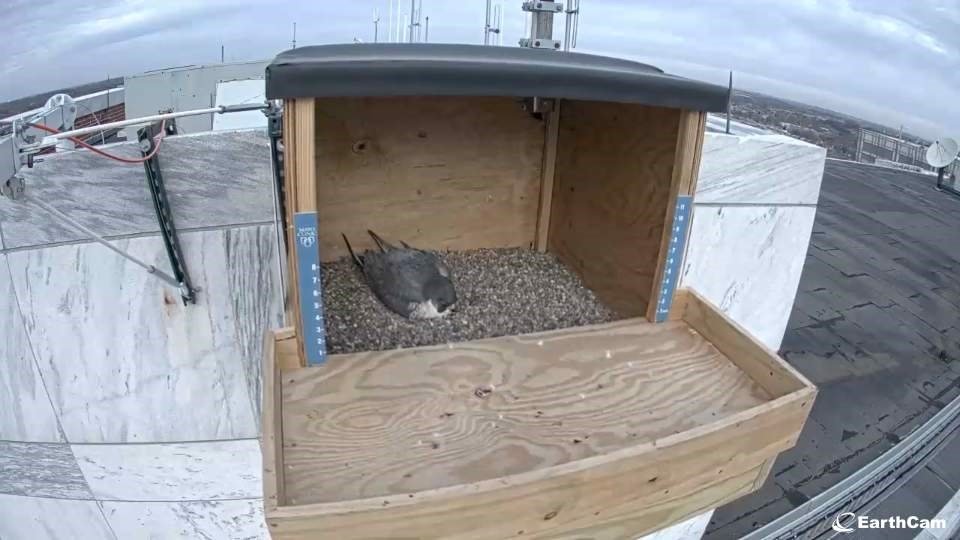
March 26 - The morning sun is streaming into the nest box where Hattie is incubating four eggs. If all goes well, we can expect hatch in about 31 days.
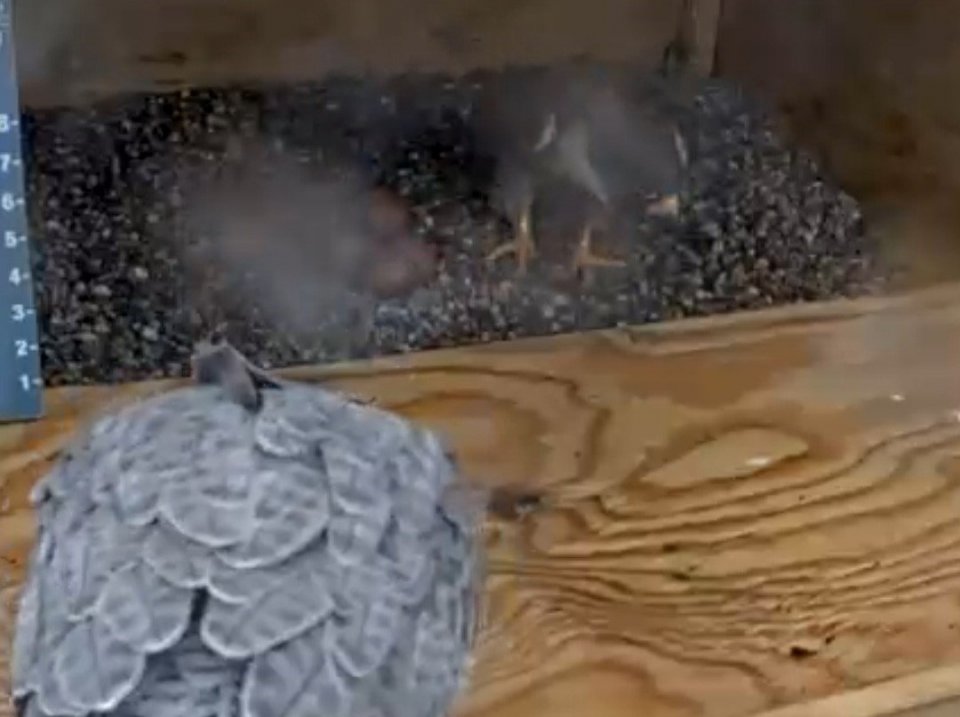
March 24 - Hattie and Orton are now tending to four eggs in the nest box. This photo was taken at approximately 1:30 pm. It’s blurry due to rain in the Rochester area.
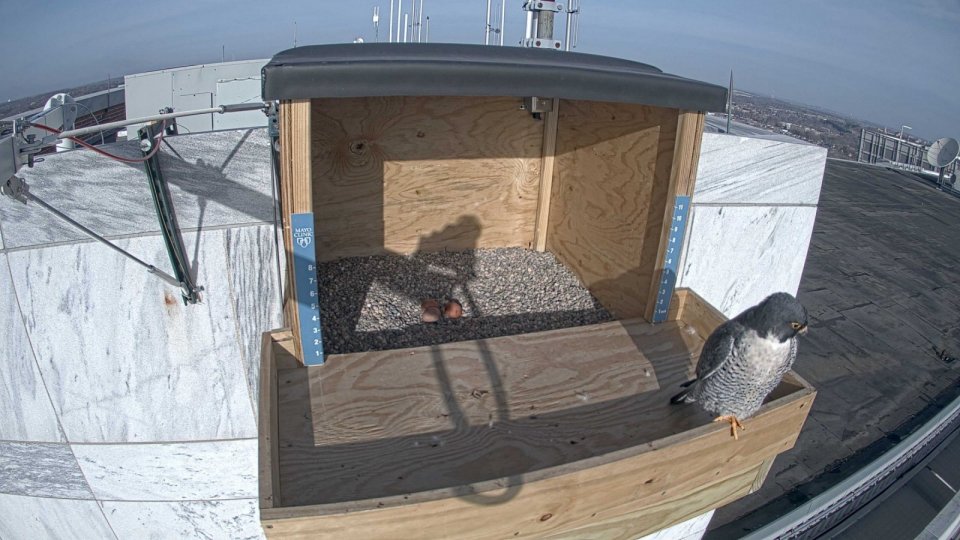
March 22 - This photo, taken at 9:00 am, shows three eggs in the nest box.
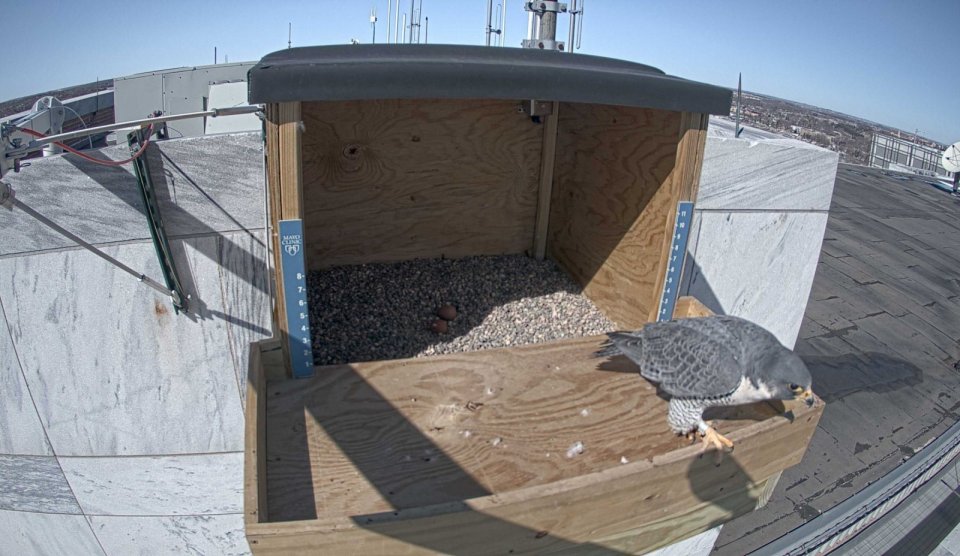
March 19 - Hattie laid her second egg at approximately10:30 this morning. Now we may see Hattie and Orton taking turns tending to the eggs in the nest box, but there will be times when neither bird sits on the eggs. Don't be concerned; Hattie will begin incubating the eggs after she lays her next-to-last egg. This timing helps all the eggs develop at roughly the same time to hatch in about five weeks.
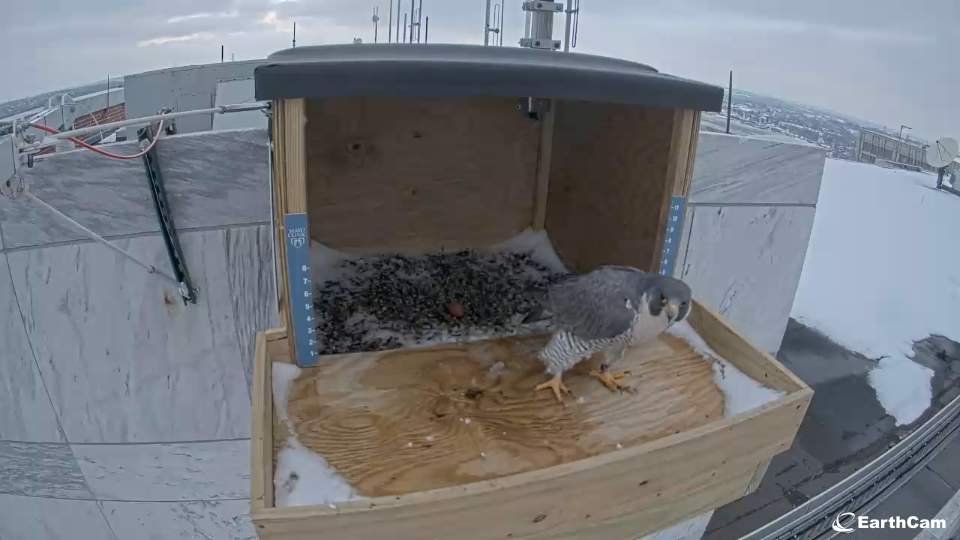
March 16 - We have our first egg! This is the earliest date on which peregrines at Mayo have had eggs.
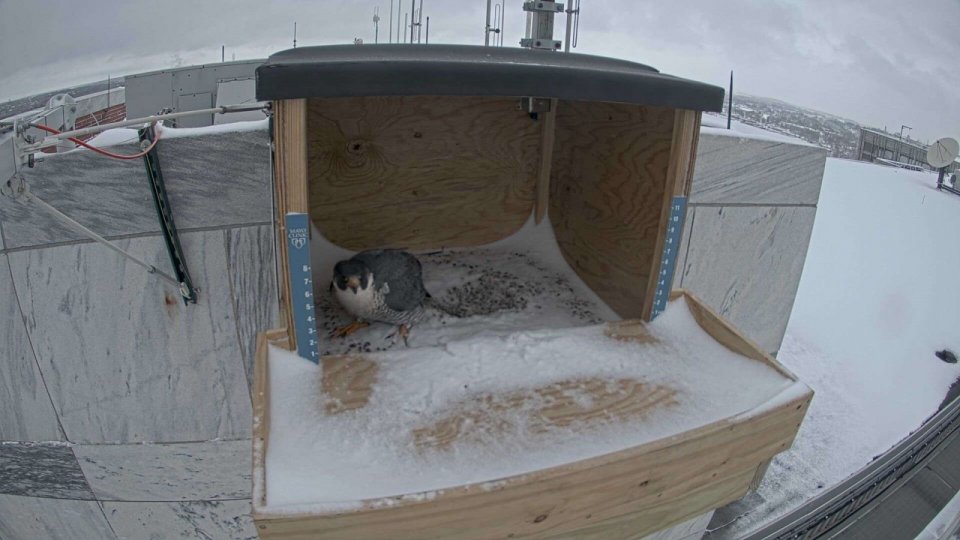
March 15 - Hattie spent some time in the nest box during the snowstorm that swept through Rochester and the surrounding area.

March 12 - This photo shows Hattie and Orton in the nest box.
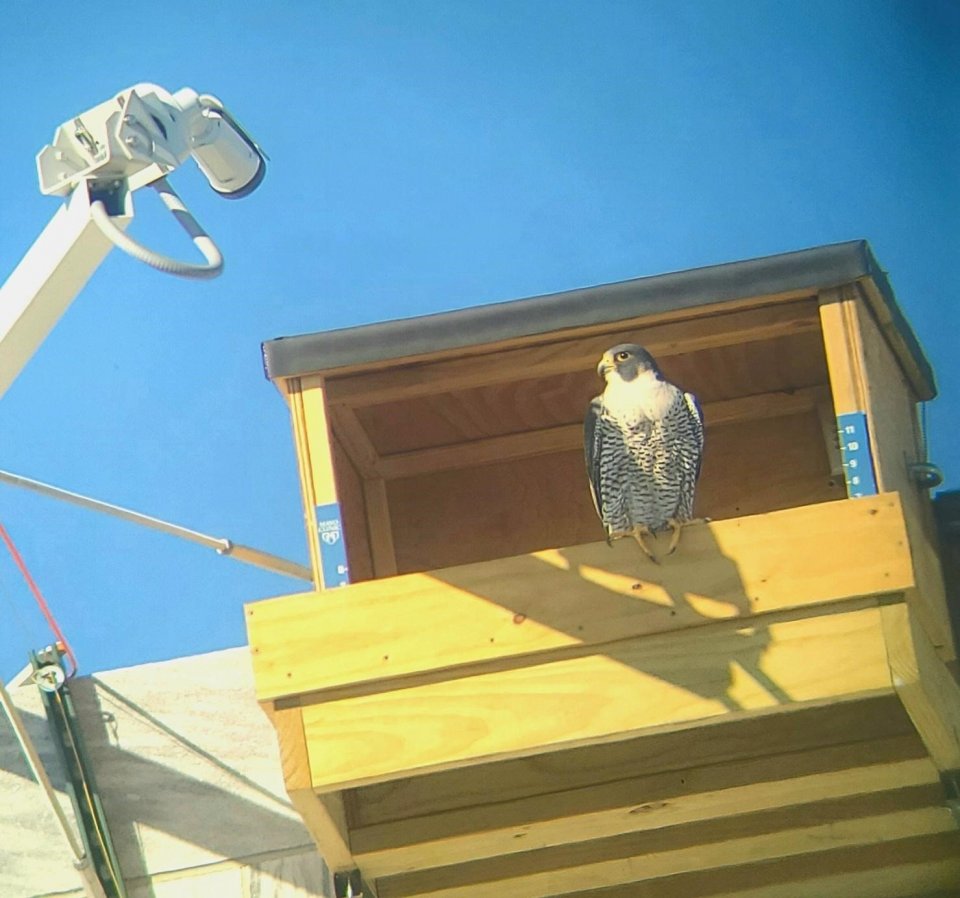
March 12 - Viewers may have observed a tussle between Hattie and an unidentified female earlier this week. The photo (below right), taken around 10 a.m. today, shows Hattie at the nest box. Once again, she is successfully defending the territory, for the sixth straight year.
March 3 - A territorial battle was observed on March 3 at about 11 a.m. An unbanded adult female was vying for Orton's attention. Hattie did not tolerate the presence of another female and quickly gave her an escort out of the area. Territorial battles are quite common at this time of year as migrating birds come through the area.
February 23 - Orton is working on a scrape - a depression in the gravel - in the nest box. Peregrines use a scrape as a nest for eggs.
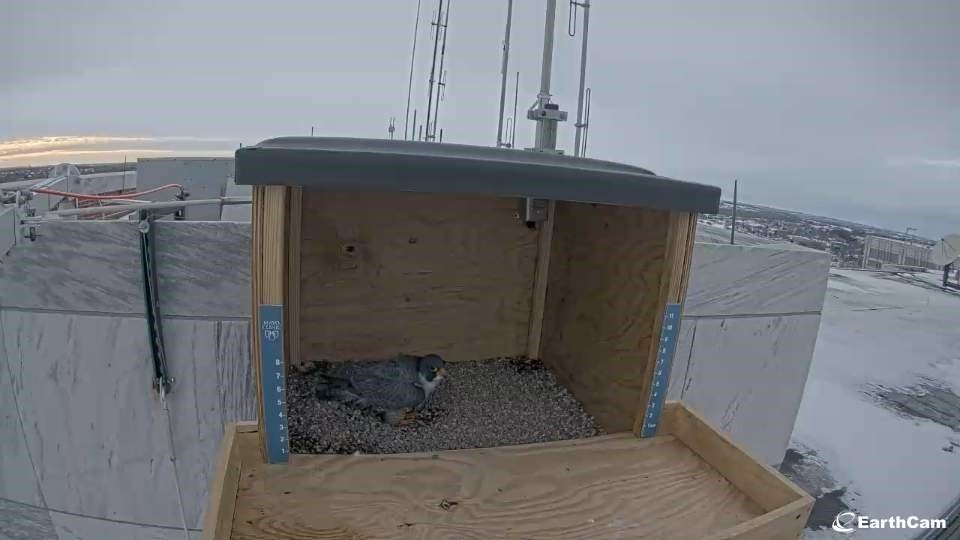
February 22 - As of 2/19/21, Jackie Fallon identified both Hattie and Orton as maintaining possession of the Mayo territory. This time of year, there can be quite a bit of change in occupancy, with the resident birds actively defending the box.
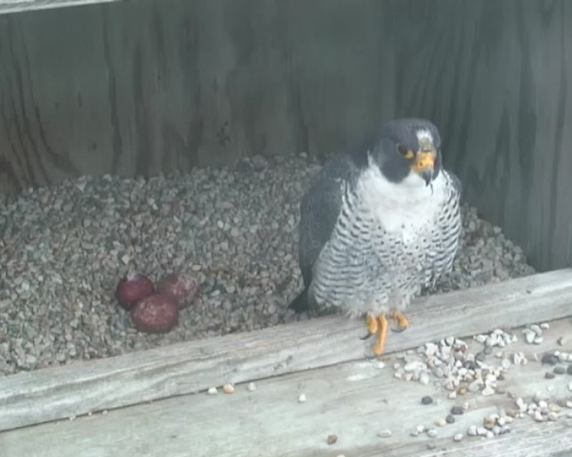
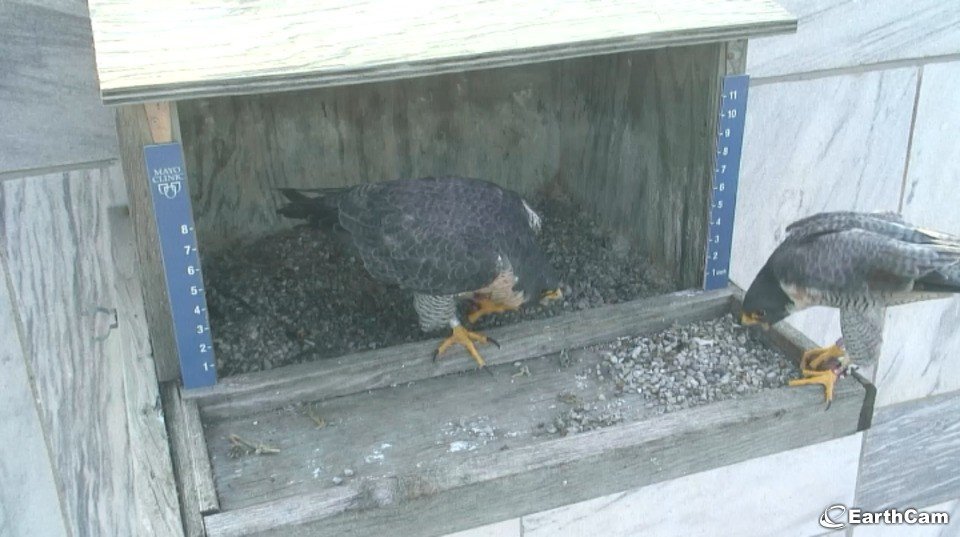
August 31 - It's difficult to share sad news: Nadya, the last of the chicks to hatch this year, was found badly injured at Carley State Park on August 25. She was taken to the Raptor Center in St. Paul, where it was determined that her injuries (severe soft tissue damage and necrosis of the left wing) were extremely serious and she was euthanized.
However, there is good news to report: our adult pair, Hattie and Orton (shown below), continue to maintain a strong bond, spending time in the nest box together and even forming another scrape (a depression in the gravel where eggs are laid). Orton is doing very well, having completely recovered from the injuries he sustained in July.
August 11 - Jackie Fallon reports that both Orton and Hattie have been seen at the nest box during the past few days, and all is well. We're happy to share this link to a video made by Axel Gumbel, Mayo Clinic Public Affairs, showing the full story of Orton's release on August 7. Enjoy!
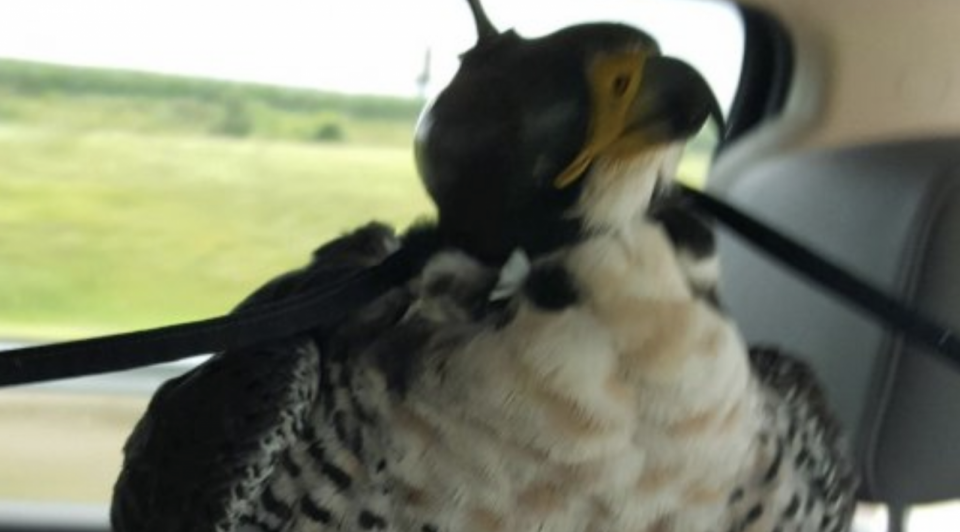
August 7 - We are pleased to report that Orton was successfully released from the 16th floor of the Plummer Building today at approximately 11:30 a.m. Jackie Fallon from the Midwest Peregrine Society and Chet Ellingson, a wildlife photographer, carefully transported him from the Raptor Center in St. Paul this morning. As Chet drove, Jackie held Orton on her fist as he was more comfortable there than on a perch.
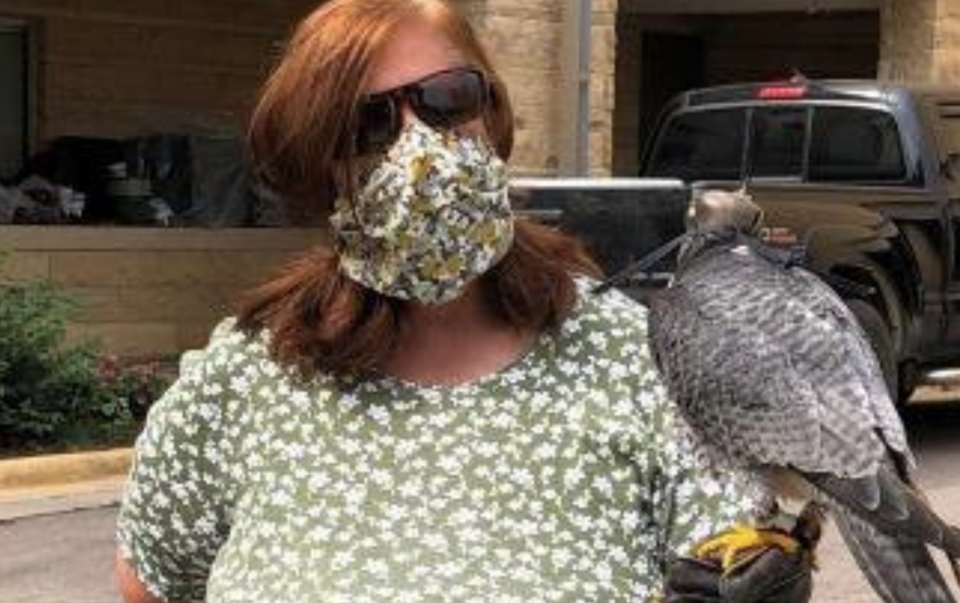
After arriving at the Plummer Building balcony, Jackie finalized preparations for release, then handed Orton to Tom Behrens from Mayo Clinic Facilities Management.
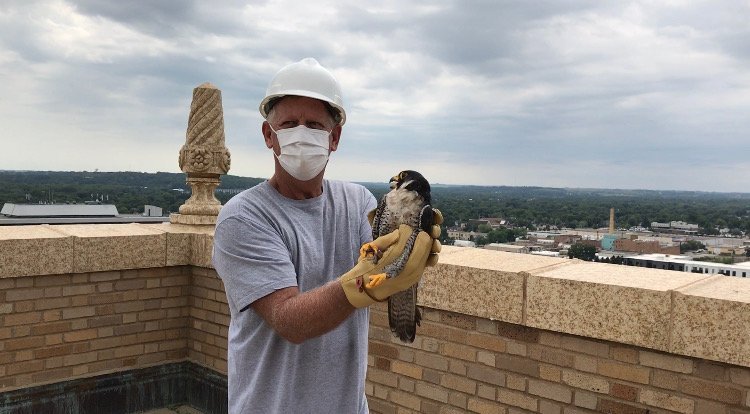
Tom, who has led the Mayo Clinic Peregrine Falcon Program for almost 30 years, released Orton, "tossing" him into the wind on the south side of the building.
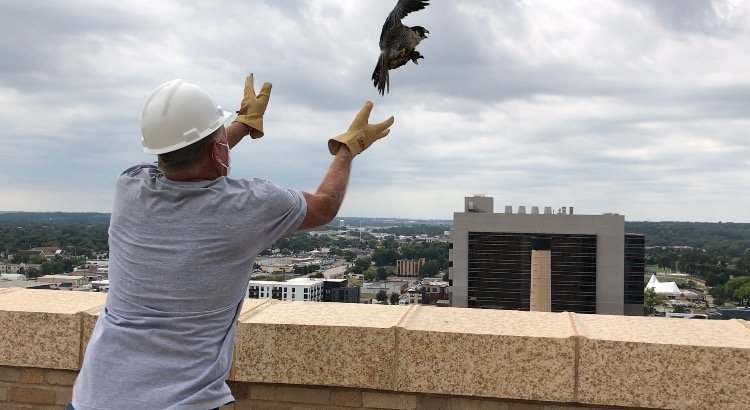
Orton immediately took flight, heading toward the Mayo Building. Hattie had been keeping watch from the top of the Guggenheim Building, across the street from the Mayo Building, and she immediately flew nearby to determine that Orton was not a threat. Orville, one of this year's fledglings, took cover in the nest box until he was more certain that Orton did not pose a threat. According to Jackie Fallon of the Midwest Peregrine Society, Orton's release could not have gone more smoothly.
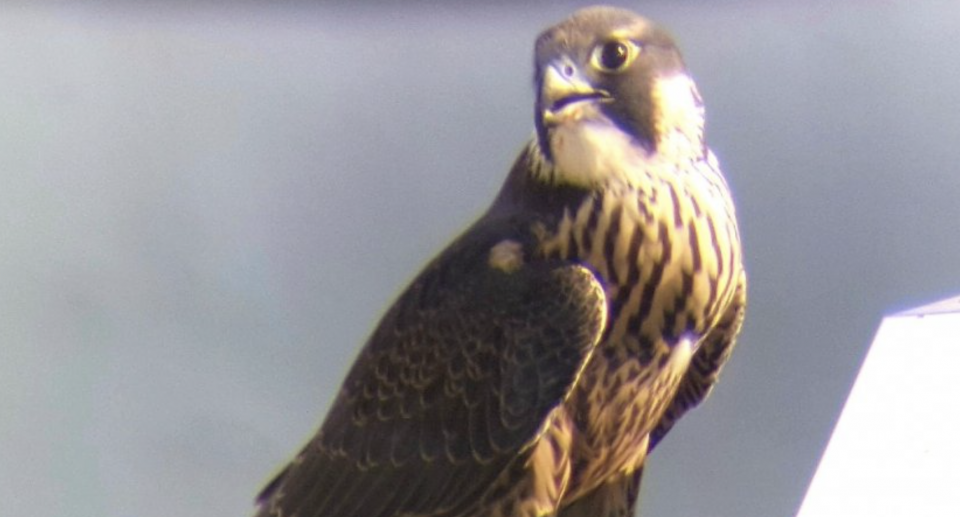
August 6 - Orton is ready to return home to Rochester and will be released from an upper floor of the Plummer Building tomorrow (August 7) at around 11:30 a.m. We will take photos of the event and will post them online as soon as possible. Keep an eye on the falcon cam during this time; you may see some activity and hear vocalizations of Hattie and the fledglings as they realize that Orton has returned.
August 5 - We are developing plans to release Orton from either the Plummer Building or the Mayo Building in downtown Rochester this Friday, August 7. We will share more details as soon as possible.
August 3 - We're happy to report that we have still not seen another adult male on territory so we're hoping that situation doesn't change. Orton is making great progress at The Raptor Center and discussions are underway regarding a potential release date in Rochester.
July 24 - Above is a photo of Nadya, taken today. If you recall, Nadya is the youngest and smallest of this year's brood.
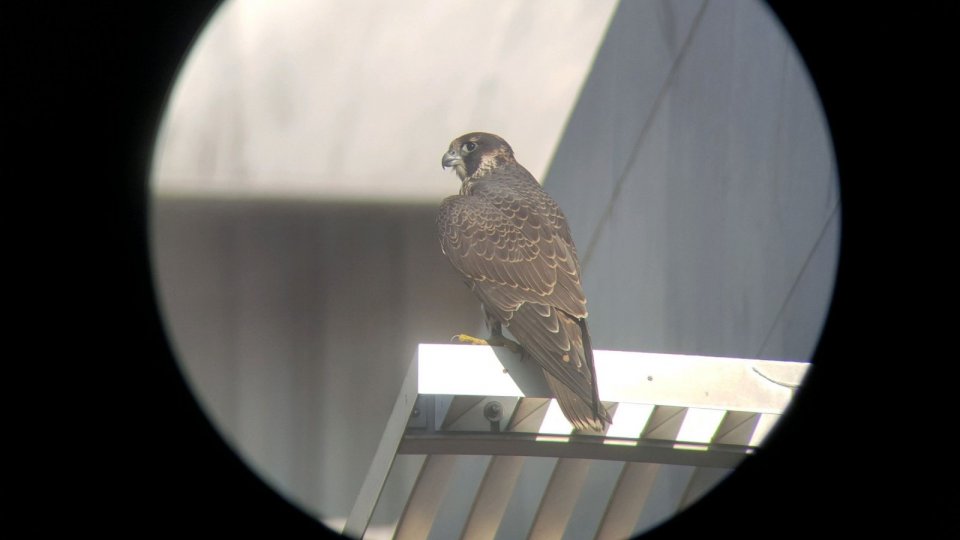
July 17 - Jackie Fallon from the Midwest Peregrine Society is closely monitoring the activity of our peregrines while Orton is recovering at The Raptor Center. With Orton away, it's possible that another adult male could try to assume this territory, and that could cause problems for the three fledglings. So far, all is well and no other adult male has been seen on territory. Jackie captured these photos today, showing Hattie overseeing the situation, and Glory, who had been begging for food.
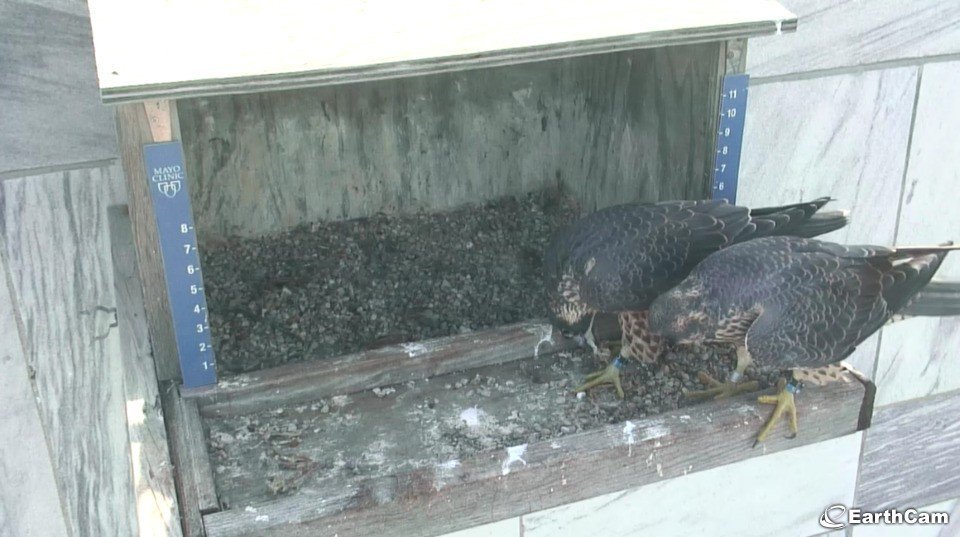
July 14 - We’re sorry to share the news that Annabelle, one of this year’s four fledglings, was found dead this morning on the ground next to the Mayo Building. She had a pigeon carcass right beside her, so our guess is that she was hunting and misgauged something in flight and hit the building. While this is difficult news, it is typical of the trials young falcons face during their first year. Experts estimate that three out of four falcons do not survive until their first birthday. Below are photos taken today of Annabelle’s siblings (Nadya, Glory and Orville) who are doing very well.
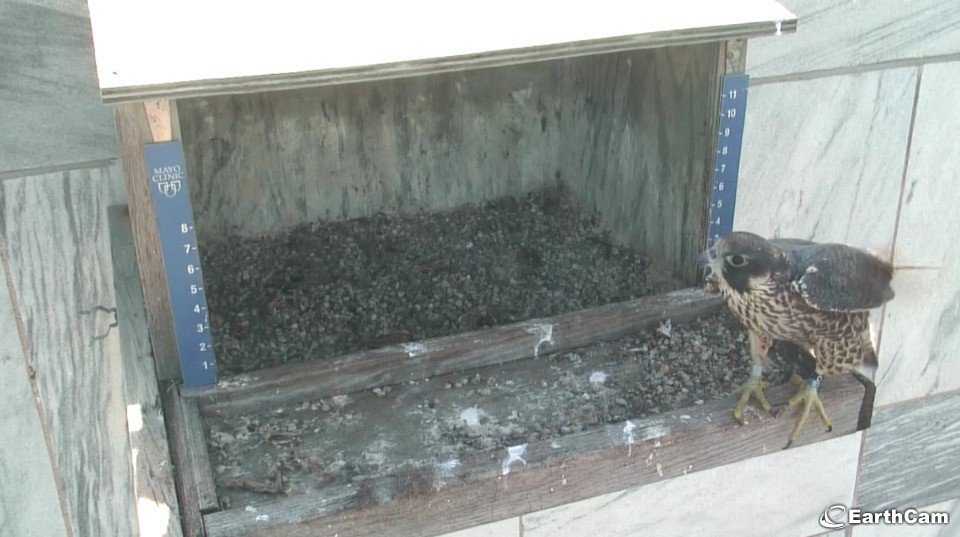
July 14 - We’re sorry to share the news that Annabelle, one of this year’s four fledglings, was found dead this morning on the ground next to the Mayo Building. She had a pigeon carcass right beside her, so our guess is that she was hunting and misgauged something in flight and hit the building. While this is difficult news, it is typical of the trials young falcons face during their first year. Experts estimate that three out of four falcons do not survive until their first birthday. Below are photos taken today of Annabelle’s siblings (Nadya, Glory and Orville) who are doing very well.
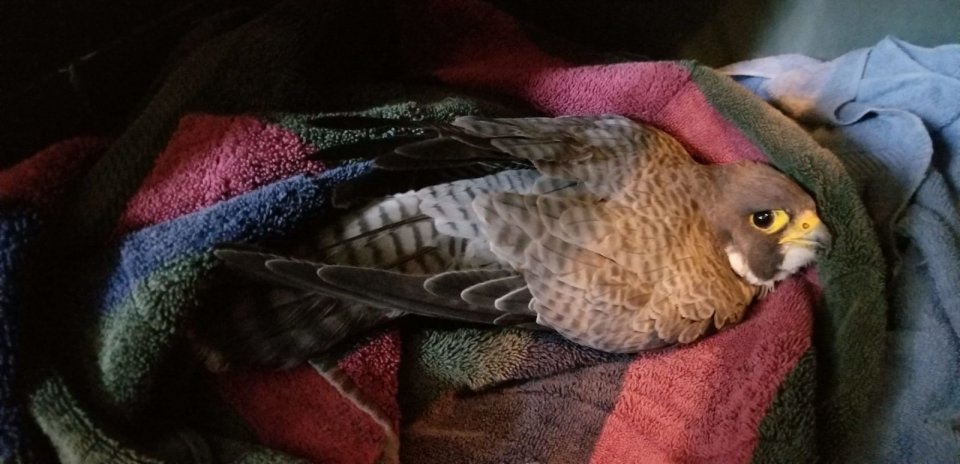
July 13 - All four fledglings have been seen around the nest box and are doing well. We have no further updates on Orton's condition but we are hopeful for a full recovery. The process will take several weeks and will eventually include exercise and careful evaluation to determine if he is well enough for release.
July 10 - We are happy to report that the four fledglings continue to do well, occasionally appearing on the nest box camera. Unfortunately, we do have some bad news about Orton, the breeding male. Orton was found Wednesday, July 8, running on the ground since he was unable to fly to the safety of a rooftop. He was captured by a local wildlife rehabber and transferred to The Raptor Center in the Twin Cities. He has suffered an injury to his keel (breastbone) and also has some soft tissue damage. Orton was very strong and healthy before his injury so it is hoped that he will have a speedy recovery and can be released in the near future. Stay tuned for more updates to be posted here.
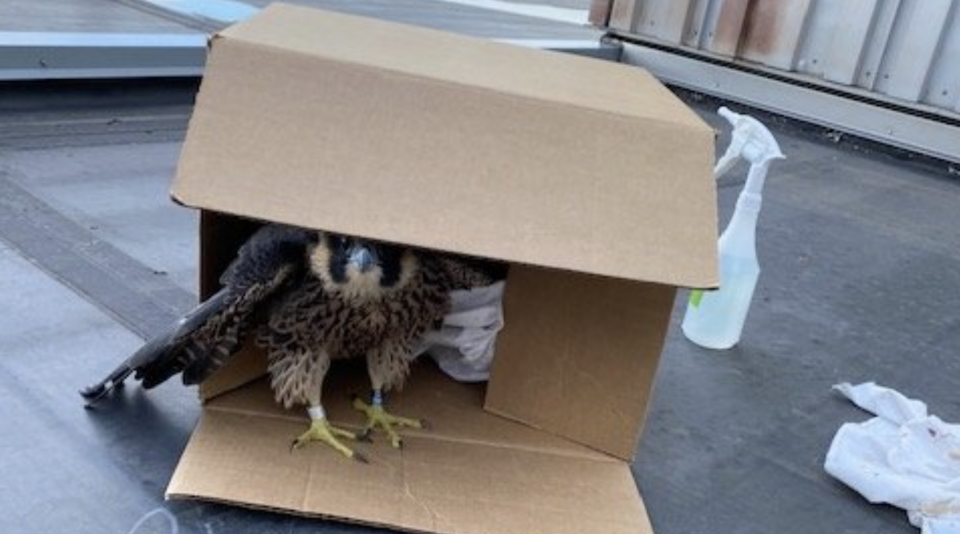
June 30 - We're pleased to share these two photos showing Nadya exploring the surroundings on the roof of the Mayo Building. She is definitely curious about her world outside of the nest box!
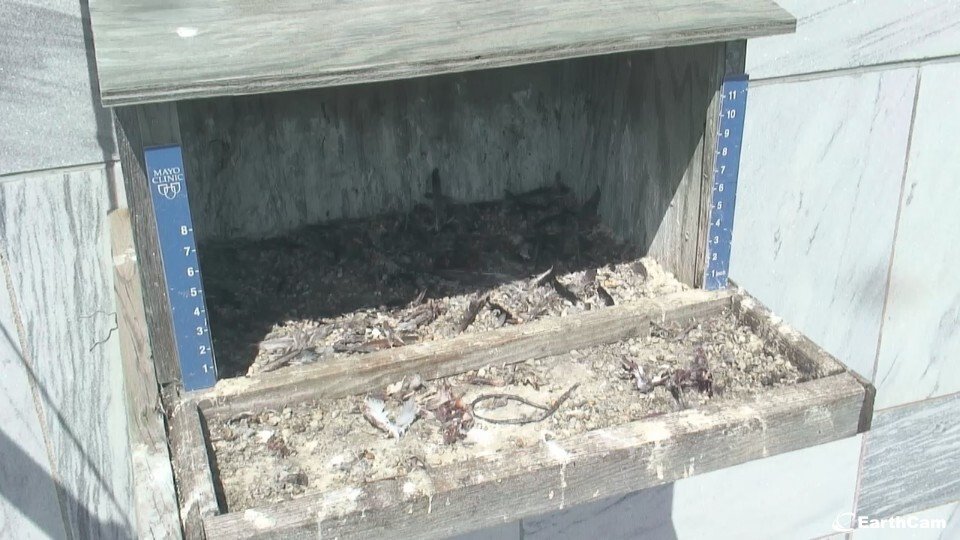
June 25 - All four of the falcon chicks have now fledged. Nadya, the last chick to hatch, was the last chick to fledge, sometime yesterday afternoon. Occasionally you may see shadows above the box and you may hear lots of vocalizations because the chicks are nearby, but they will spend less time in the box as they now learn to fly and hunt.
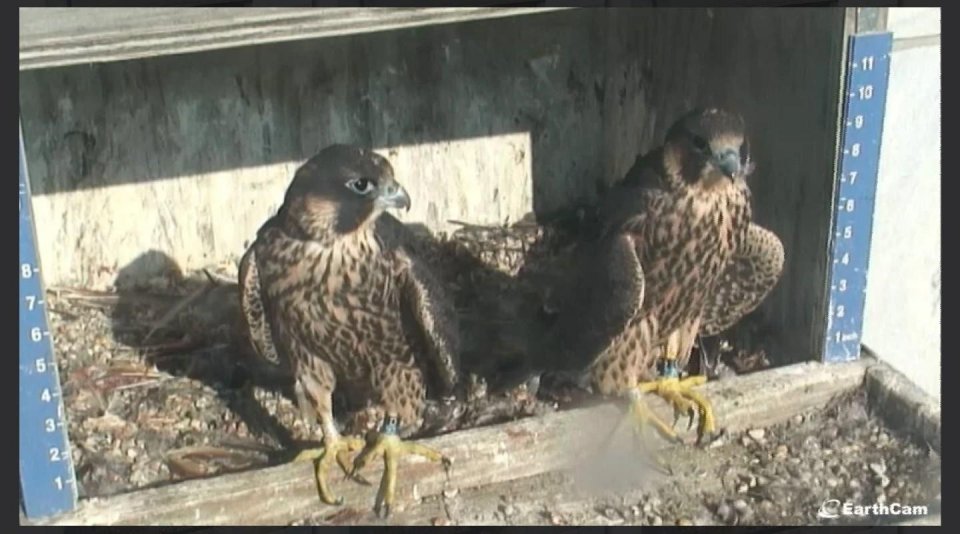
June 21 - At 7:30 a.m. today, all four chicks were in the nest box, but by 10:00 a.m., two of the chicks had fledged. Annabelle and Orville were the two chicks to leave the nest box, and one of them later returned. This photo, taken shortly after 10:00 a.m., shows Glory and Nadya still in the box, perhaps watching their brother and sister trying out their wings.
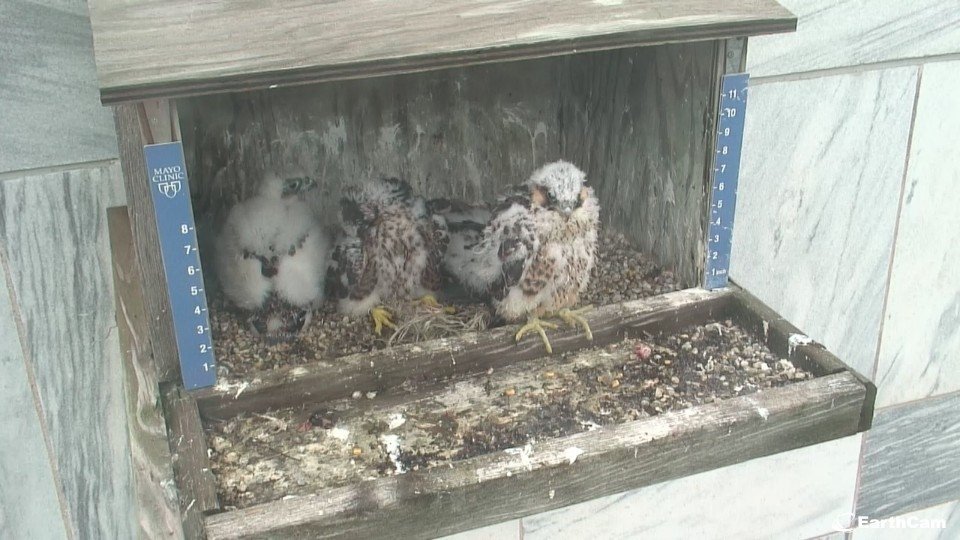
June 11 - As the chicks continue to grow, they are becoming even more curious about the world beyond their nest box. If any one of them would happen to tumble off the ledge, there is a subroof about 20 feet below. In fact, when the chicks fledge, they typically land on the subroof below before attempting to fly above the box. This is the nature of flight.
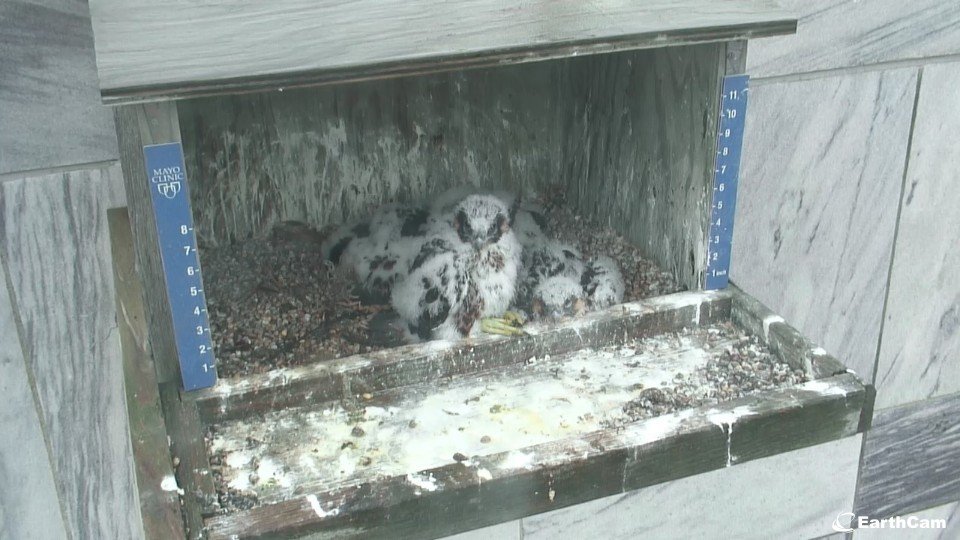
June 9 - These photos show how quickly the four chicks are growing. Every day you can see more dark feathers on the chicks. Compare the photos to the one below, taken only one week ago! When the chicks aren't huddled together, you can also see the difference in development between the older three chicks and little Nadya, who hatched just 2.5 days later.
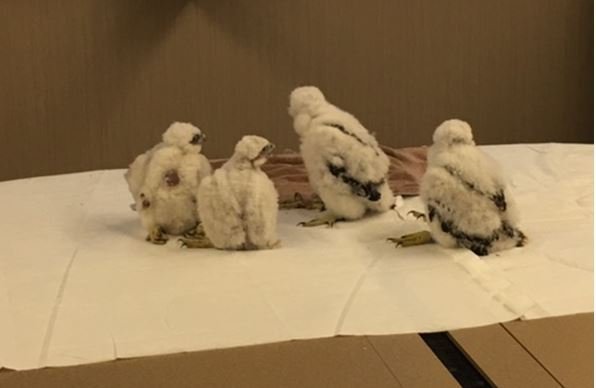
The names Orville, Annabelle and Glory were chosen from the many names submitted to the Heritage Days email address in recent weeks. Jackie Fallon named the smallest chick Nadya, which means "hope" in several languages. Jackie, who has banded every chick that has fledged from Mayo Clinic, asked for the opportunity to name one chick to honor Mayo Clinic and all those who work here, particularly in these challenging times. Thank you, Jackie!
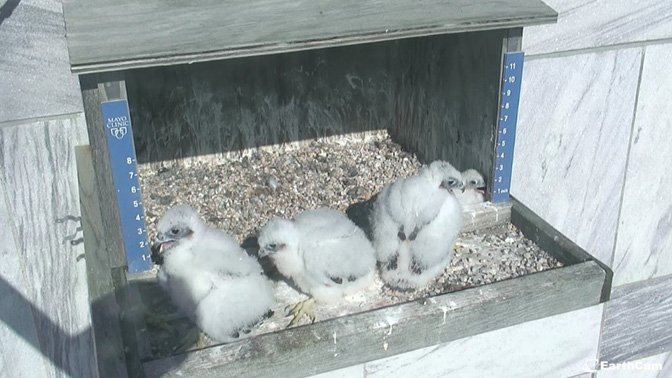
June 2 - This photo shows the four chicks, getting bolder each day and even venturing out onto the ledge.
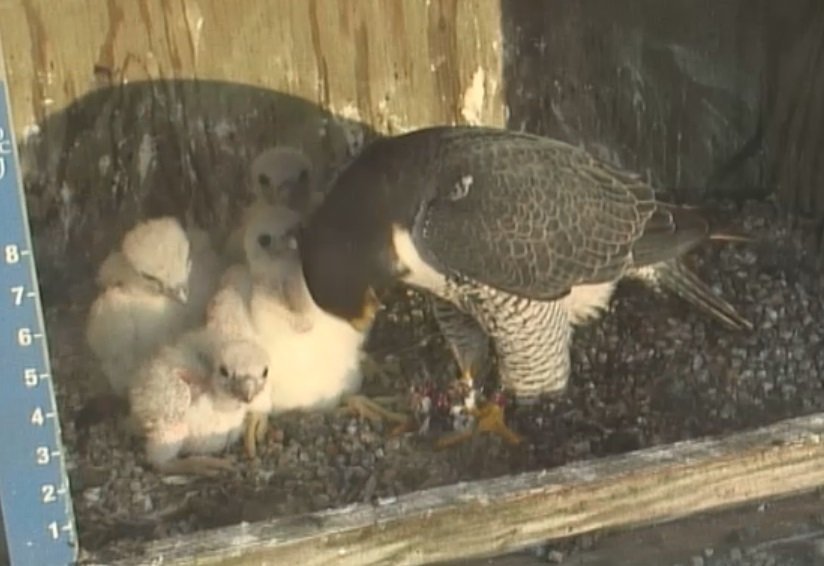
May 27 - Now that the chicks are older, they no longer need to be kept warm by their parents but they still tend to huddle together in the nest box. They are growing rapidly and will be ready for banding and naming next week.
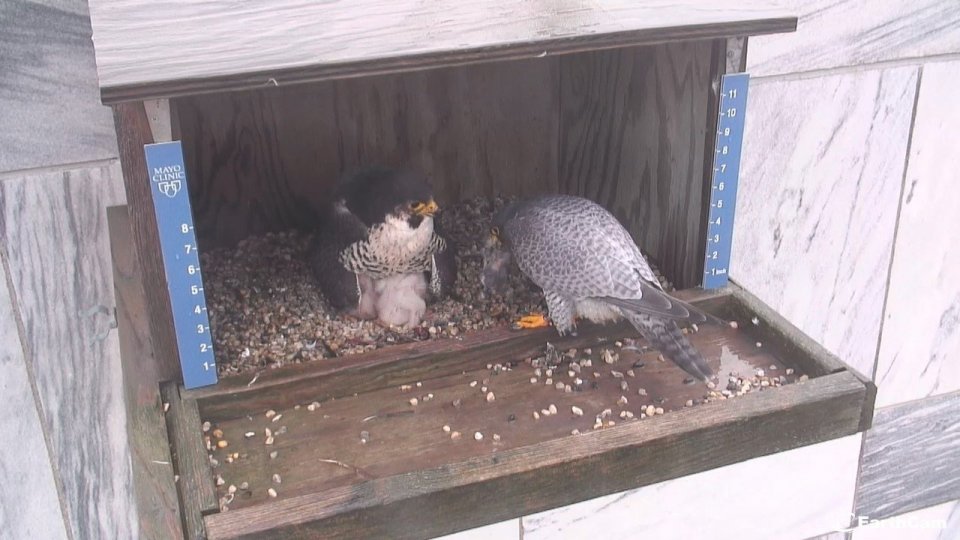
May 18 - We've had rainy days in Rochester but the falcon chicks are doing well in the nest box. Hattie and Orton are excellent parents!
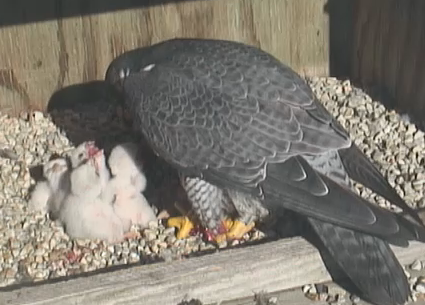
Great news! The fourth egg has hatched and all four chicks are doing well. You will notice that the last chick to hatch is definitely smaller than its three siblings who have had several days' headstart on eating and growing. You may also notice that Orton plays a significant role in caring for the chicks. He is an excellent provider and also takes his turn feeding the youngsters.
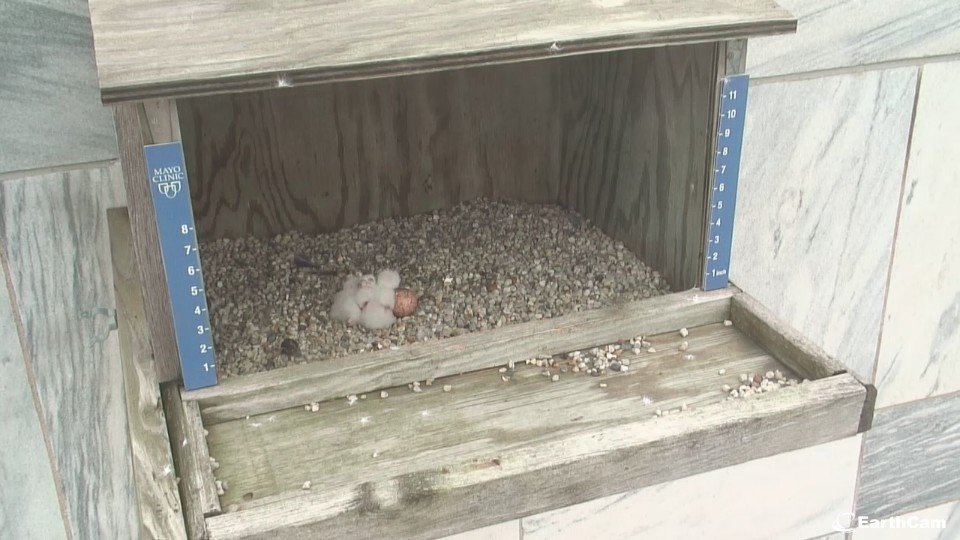
May 14 - The photo below shows the three chicks that hatched on May 12 and the unhatched egg. If that egg doesn't hatch sometime today, we can assume that hatch won't happen. You may recall that Hattie laid one egg earlier than the other three. Both Hattie and Orton had just survived some fierce territorial battles, and it's possible that the first egg was never fertilized.
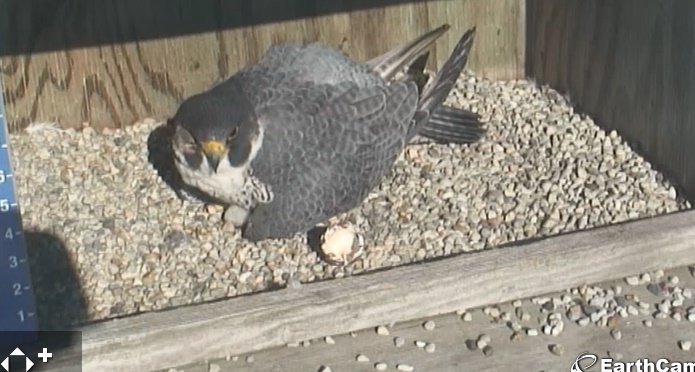
May 12 - As the sun rose this morning, we could see that three of the chicks had "pipped" through their shells, getting ready for hatch. Shortly afterward, it was apparent that one of the chicks had already hatched. The first photo below shows the empty shell, and you can see the small white fluff of the chick tucked beneath Hattie.
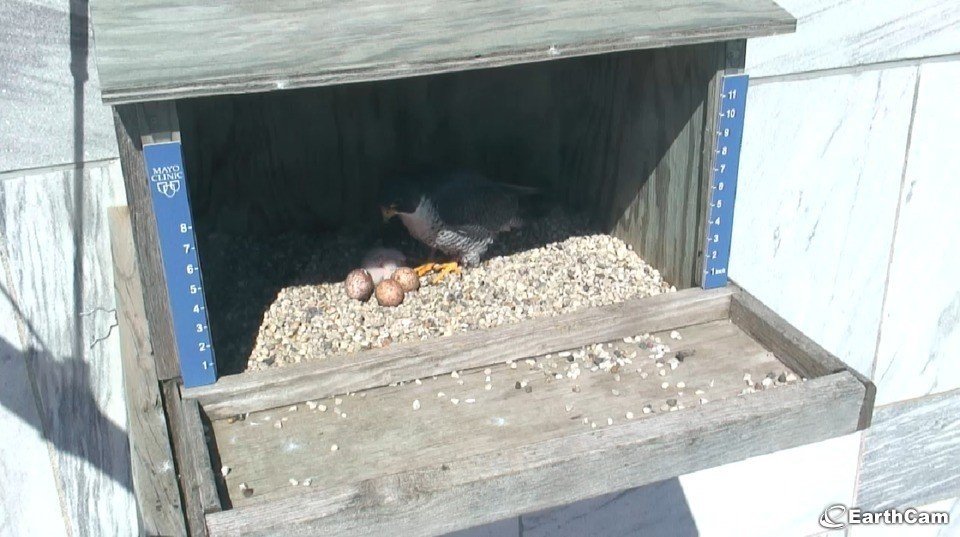
May 12 - The second photo shows Hattie with the first chick at about 10 a.m.
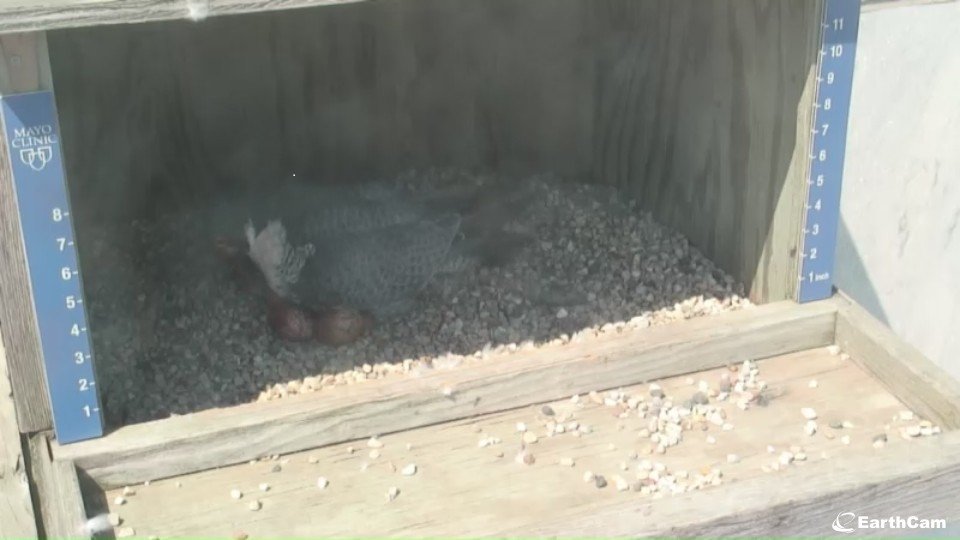
May 8 - All is well in the nesting box in spite of cold overnight temperatures in Rochester. We are looking forward to hatch any time next week!
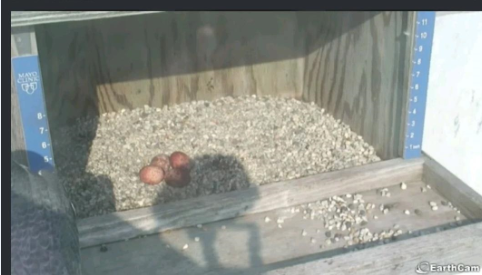
April 11 - Sharing the good news that we now have four eggs in the nesting box.
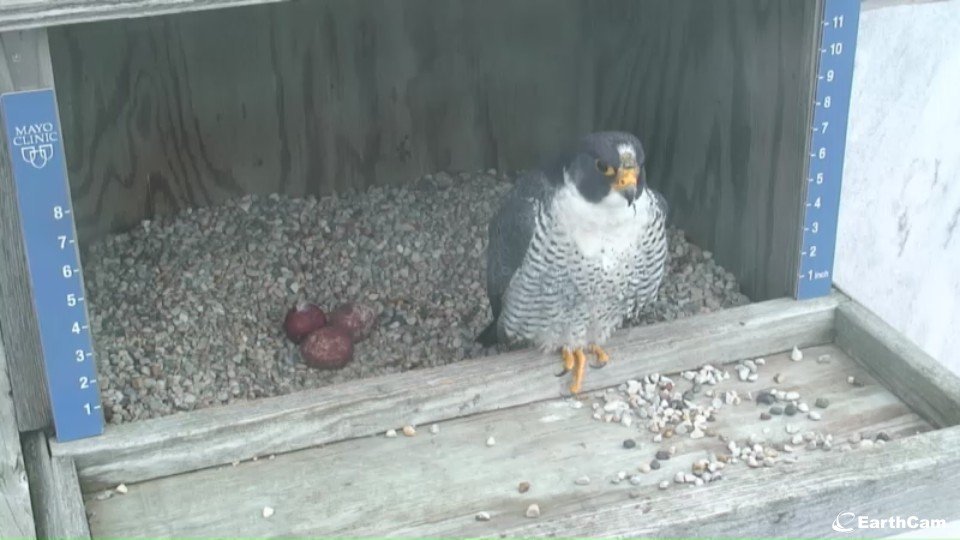
April 8 - We have a third egg as of about 9:15 a.m.! This photo shows Orton standing guard.
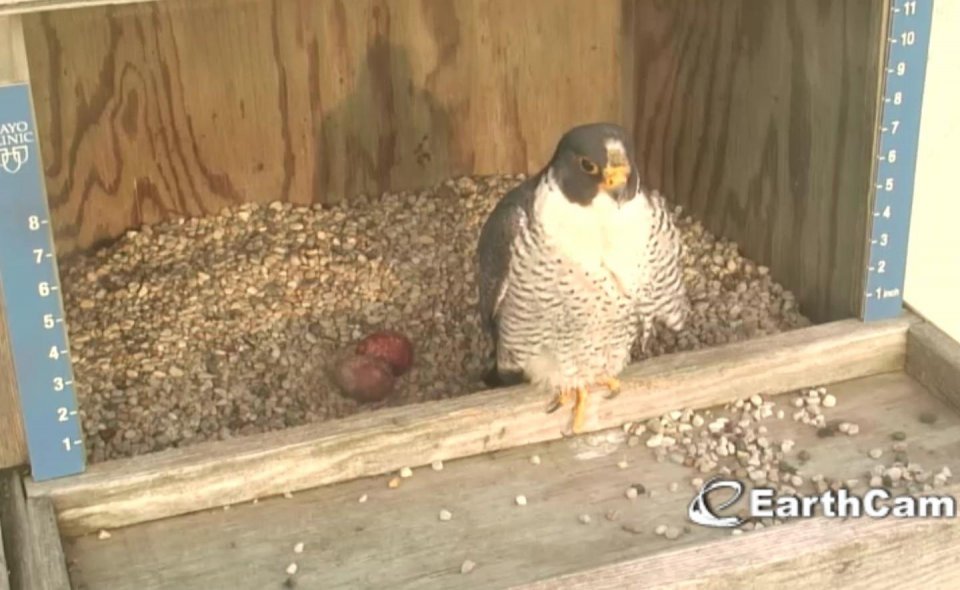
April 5 - Hattie laid a second egg this evening at about 7:20 p.m.
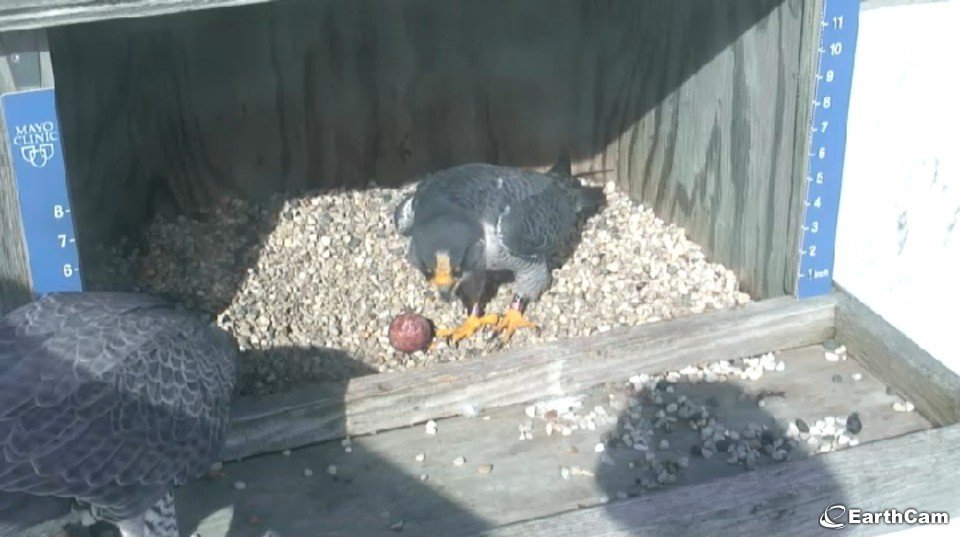
April 3 - Typically falcons lay eggs every other day. There are several possible reasons that Hattie has laid only one egg so far. 1) The first egg may have been an anomaly and she will actually begin to lay again this weeked. 2) The stress of the fierce territorial battles may have taken a toll on the hormones of one or both of the adults. At this point, we are taking a "wait and see" attitude.

March 30 - Hattie has laid her first egg! The egg is brown/maroon in color and is situated near the front of the box. Hattie and Orton will not brood (incubate) the eggs until the second to the last one is laid so don't be alarmed if you see that the egg(s) are exposed at this point. Keep an eye on the falcon cam and visit this website often for more updates.
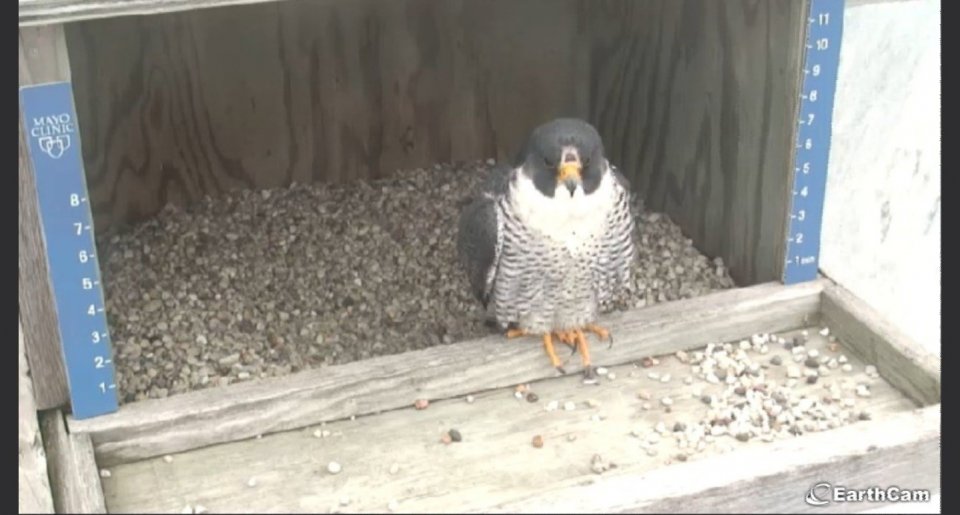
March 24 - This photo shows Orton at the nest box with a laceration above his beak. It was inflicted during the territorial battle last week. We will do our best to observe him to learn the severity of the laceration. In the past week, territorial battles in the upper midwest have resulted in injuries to several peregrines, including one injury that was fatal.
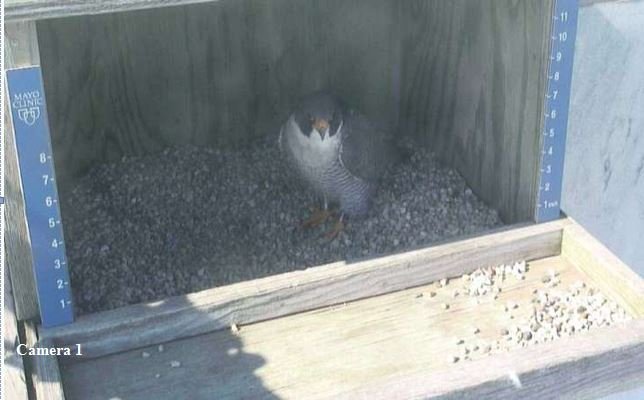
March 16 - Orton and an unidentified young male were engaged in a fierce territorial battle on March 14. The aerial battle lasted for about 1.5 hours. Orton was exhausted after the battle but it appears that he has won the territory. Orton and Hattie were both observed in the nest box on March 15.
March 6 - Orton has been seen often at the nest box. Hattie is more easily identified because she has scarring near her right eye from territorial battles in 2019. Female peregrines are also larger than males.

February 28 - Hattie and Orton spent the winter in the Rochester area and have been seen in and around the nest box. The photo shows them on the Gonda Building this morning.
Orton has also been working on a scrape -- a depression in the pebbles where eggs can be laid.
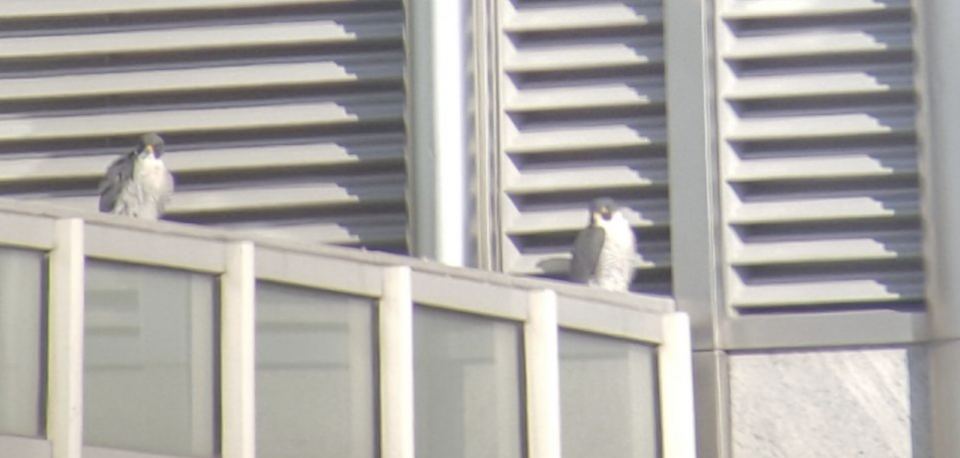
Another female has been seen on territory and may be vying with Hattie for the nest box.


The entries in this gallery recap the events of the 2019 nesting season at Mayo Clinic in Rochester, Minnesota.
The adult peregrine falcons are named Hattie and Orton, the resident pair since 2016. Hattie is four years old and is named in honor of Hattie Damon Mayo, the wife of Dr. William J. Mayo. Her name means "keeper of the hearth and ruler of her household." Orton is a 5-year-old male. He fledged from City Hall in Minneapolis and is named for the Minnesota town where the rose granite used in City Hall was quarried.
June 20 - Blizzard was seen on the roof of the Mayo Building mid-afternoon, doing just fine and in close proximity to her parents.
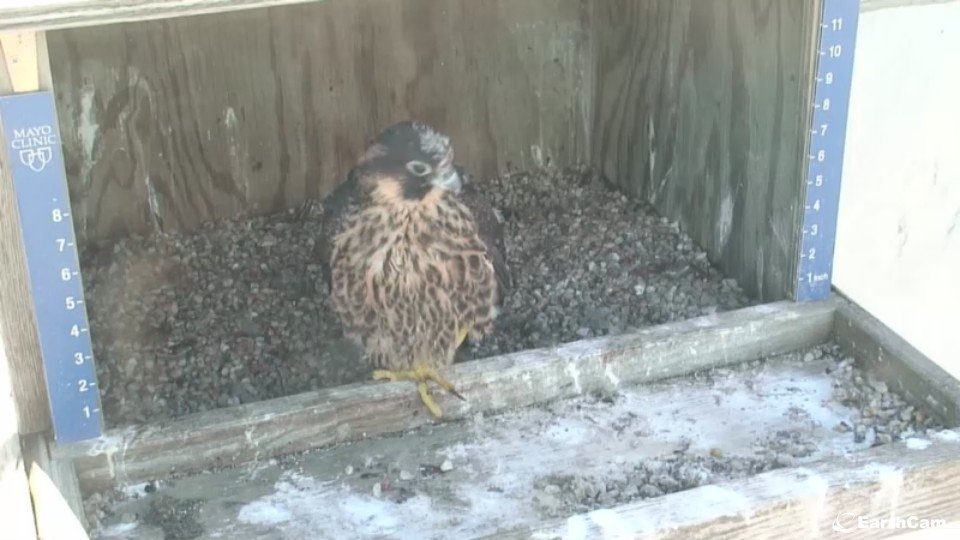
June 19 - At 42 days old, Blizzard left the nest box at 7:30 p.m. for her first flight. During the past few days, Hattie and Orton had been working with her to prepare her for this adventure. We won't see the birds on camera as often now, but we may hear them as they teach Blizzard to fly and hunt for herself.
June 18 - Blizzard is often venturing out onto the ledge of the nest box and testing how the wind feels underneath her wings. She may attempt flight later this week.
June 12 - It's amazing to see how much Blizzard has grown and changed in color during the last week. Within the next week to 10 days, it's very likely that she will make her first attempts at flight.
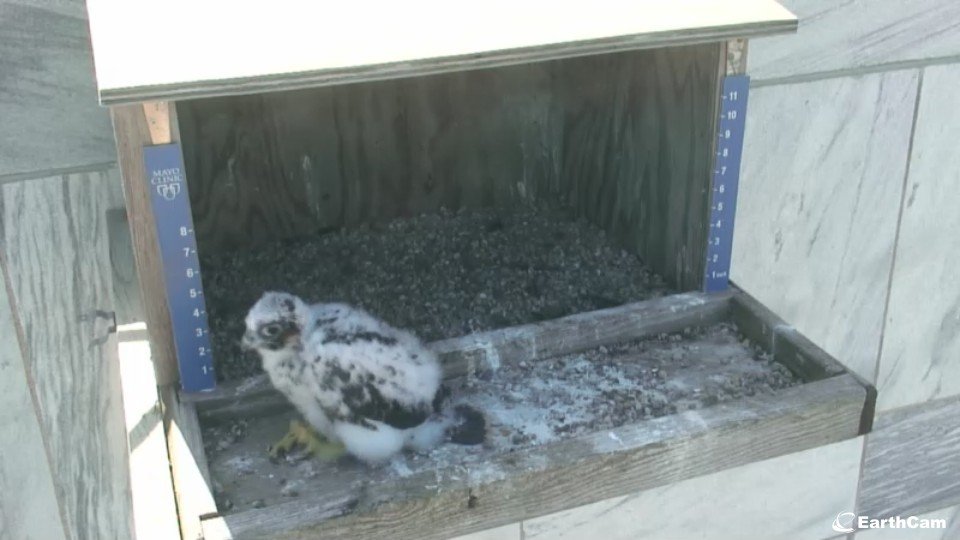
June 5 - Blizzard is changing every day, and is curious about what is beyond the nest box. Don't worry; there is a ledge beneath the nest box that is not seen on camera. If Blizzard tumbles off the ledge, she won't fall very far.
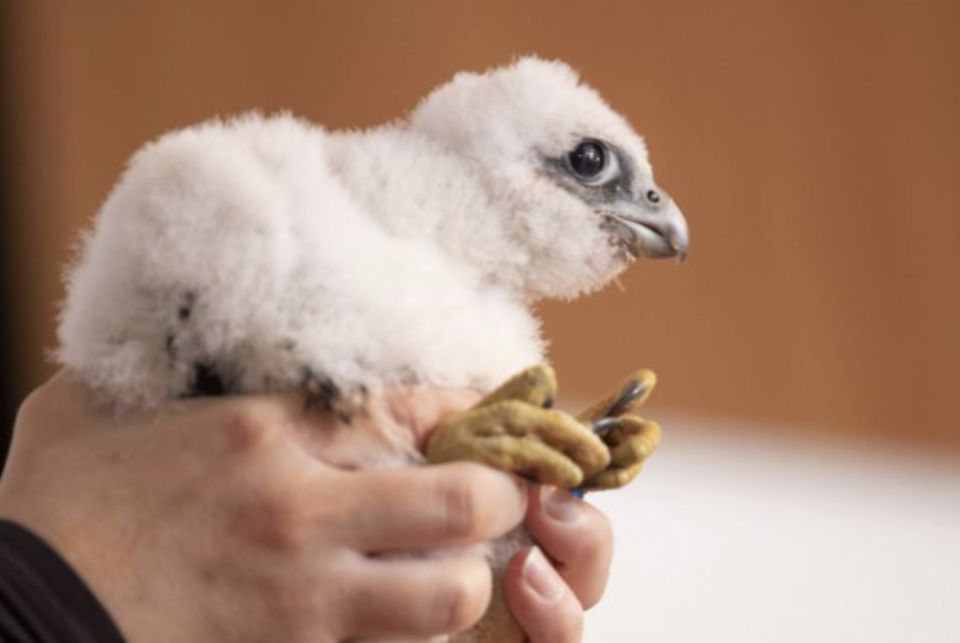
May 29 was a big day in the life of our falcon chick. At 21 days old, it was time for the chick to be banded and named. The chick was removed from the nest box and brought to Geffen Auditorium in the Gonda Building.
The audience watched as Jackie Fallon from the Midwest Peregrine Society attached an identification band to each leg of the chick. Jackie announced that the chick was a strong, healthy female. Logan Allison, a young falcon fan from Waterloo, Iowa, was invited on stage to draw a name from the more than 500 suggestions submitted, and the name "Blizzard" was chosen for the young chick. Blizzard was returned to the nest box where Hattie and Orton will continue to provide food as she prepares for fledge.
The chick is no longer in need of being brooded so Hattie and Orton are spending less time in the nest box now, except for times of feeding. Blizzard is also in less need of frequent feedings and we will begin to see her self-feed within the week.
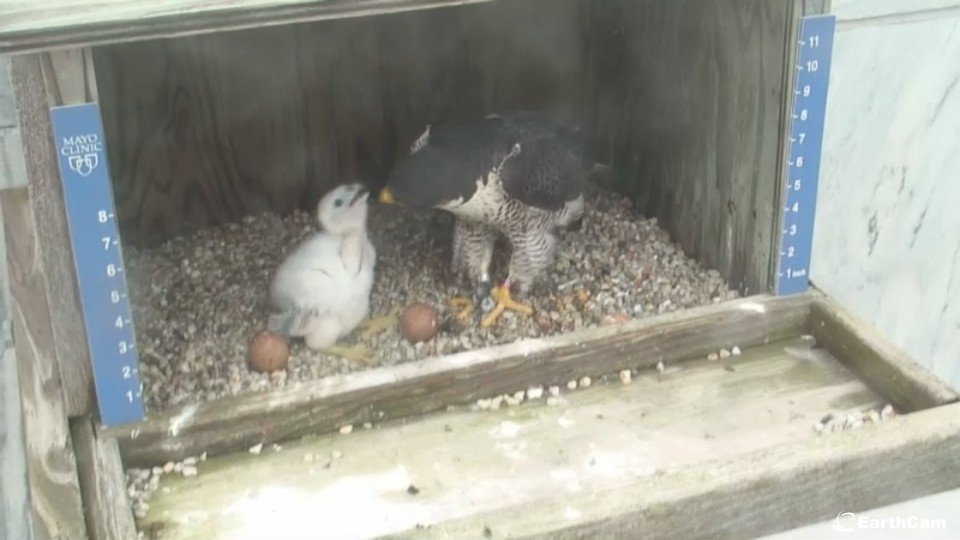
May 22: The past few days have been windy and rainy, but Hattie and Orton are keeping the chick well-protected from the elements. Here's a look at feeding time at 9 a.m. today.
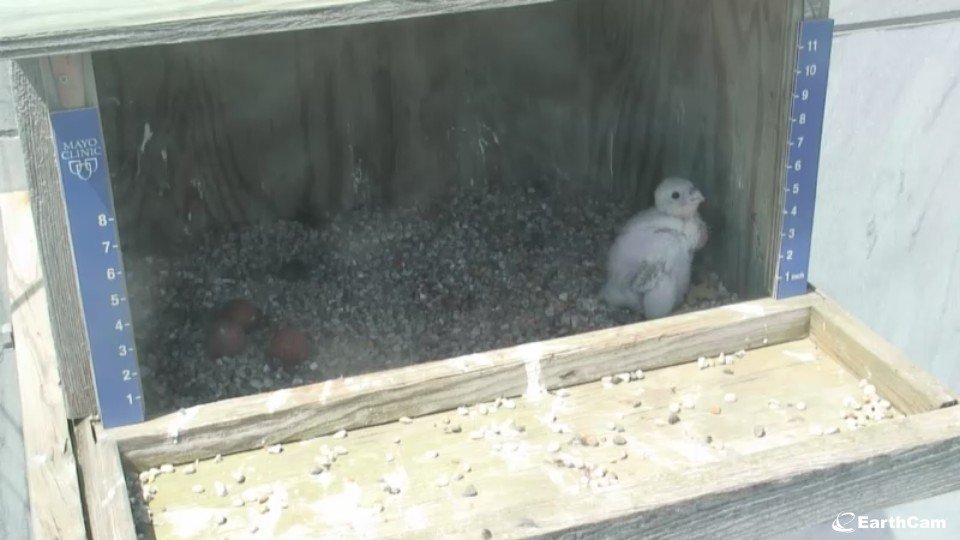
May 20: Our little one is growing fast. At 13 days old, the chick can be seen much more often on the camera as Hattie and Orton will sometimes leave it unattended in the nest box for short periods of time. The chick is quite curious about its surroundings!
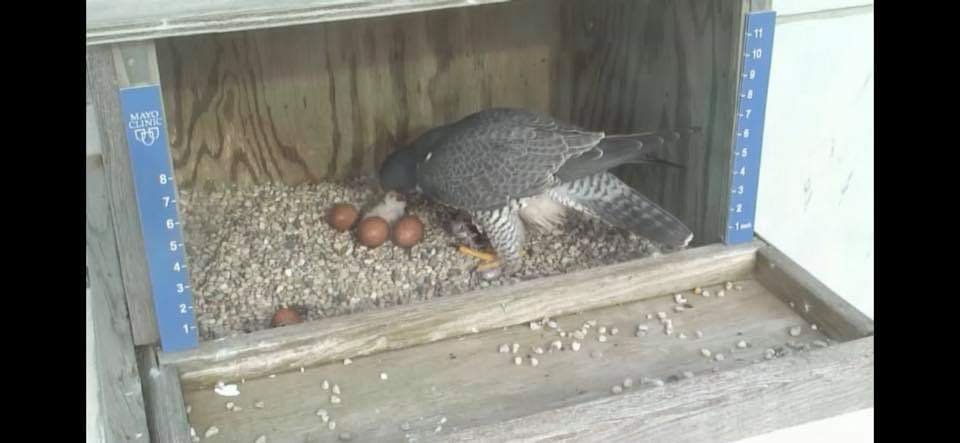
May 13: It's been nearly a week since the first egg hatched and that chick is doing very well. Hattie diligently cared for and protected the young chick throughout the cold, wet weather we had last week. It appears that the other three eggs will not hatch; the eggs will be removed from the nest box on the date of the Banding Event, May 29.
May 7: The first egg has hatched!

April 29: Hattie and Orton are diligently caring for their four eggs, taking turns around the clock. If all goes well, we can expect hatch to begin around May 6.
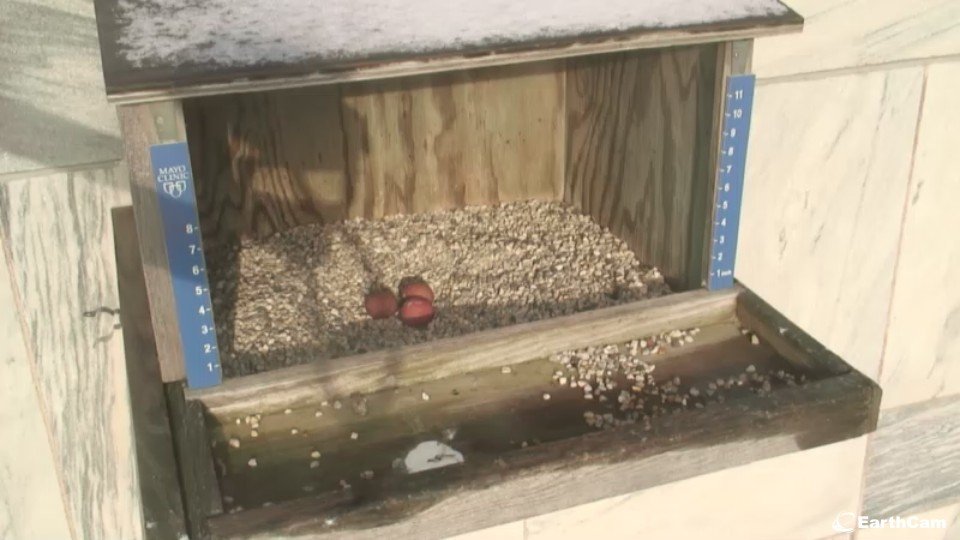
April 4: Hattie and Orton now have four eggs to care for.
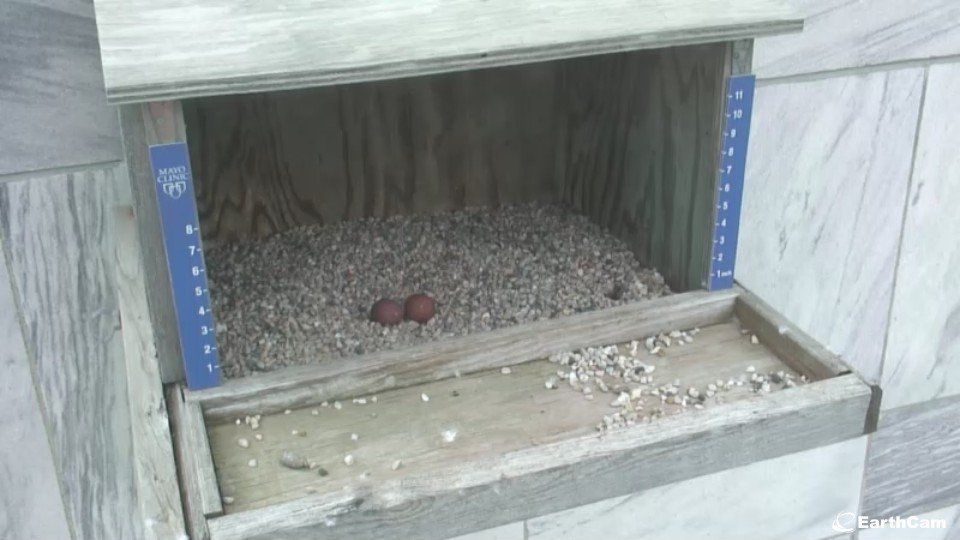
April 1: The second egg was laid over the weekend.
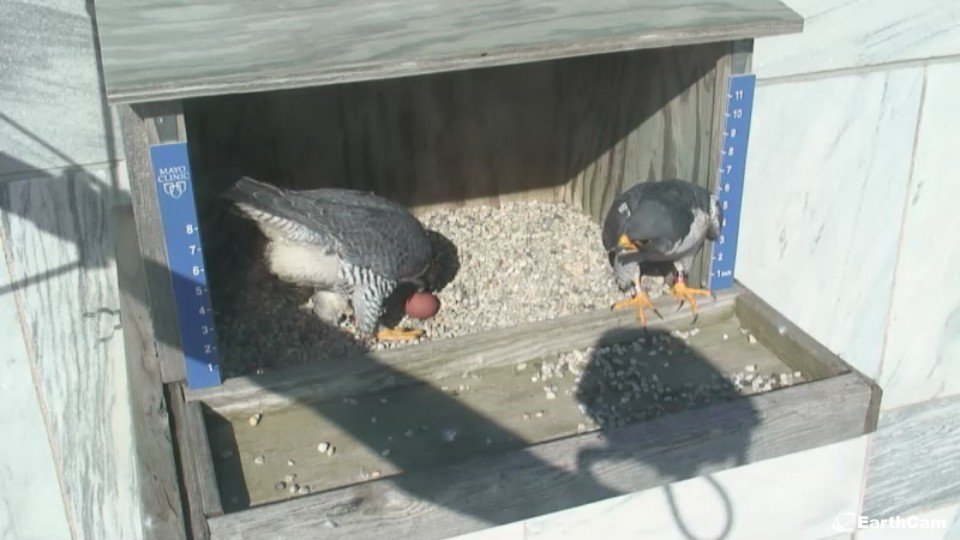
March 28: We have the first egg!
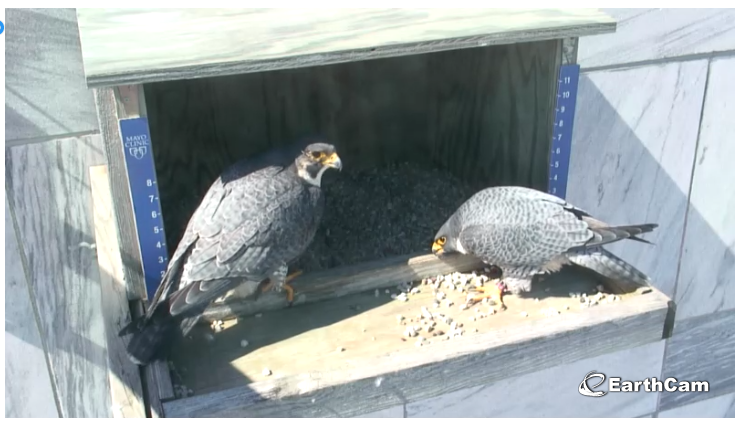
March 25: This photo (right) was taken around noon, showing Hattie and Orton at the nest box. We could see the first egg any day.
March 19: It appears that there are now only two birds on territory. Jackie Fallon from the Midwest Peregrine Society has confirmed that the female is Hattie and the male is Orton.
February 20: Three birds were observed on territory. Hattie and Orton were both back and actively defending the site from a third bird.


